NORTH SAILS BLOG
All
Events
Guides
News
People
Podcast
Sustainability
Tech & Innovation
Travel & Adventure

MY SONG CLAIMS NEW RACE RECORD
MY SONG CLAIMS NEW RACE RECORD
Line Honors Victory And A Cherry On Top For Baltic 130 Supermaxi
Pier Luigi Loro Piana’s Baltic 130′ Supermaxi My Song takes line honors and sets a new RORC Transatlantic monohull race record, covering a total of 3,000 miles from Lanzarote to the finish line in Grenada. My Song finished the 2018 race with an elapsed time of 10 days, 5 hrs 47 mins 11 secs, besting the previous record of 10 days 07 hours, 6 minutes, and 59 seconds set by Jean-Paul Riviere’s French Finot-Conq 100, Nomad IV in 2015.
Spending most of their time at a smooth 20-knots of hull speed, My Song was able to stay ahead of the clock, and the crew was pleasantly surprised at the dock in Grenada when generously greeted by locals and race officials in awe of their newly accomplished race record.
Congratulations to skipper Pier Luigi Loro Piana, and crew Giacomo Loro Piana, Luca Albarelli, Jaime Arbones, Andrea Balzarini, Gerri Baracchi, Giorgio Benussi, Alberto Bolzan, Ambrogio Francesco Maria Cremona Ratti, Gaetano Figlia di Granara, Andrea Forlani, Flavio Grassi, Cristian Griggio, Jose Ignacio Braquehais, Giorgio Peretti, Jacopo Piazzolla, Ignacio Postigo, Nicola Simoncelli, Vittorio Zaoli, and Gabriele Zoppi on a job well done.
Below: Dockside interview with My Song’s Pier Luigi Loro Piana, courtesy of © RORC/www.picturesofgrenada.com.
©Arthur Daniel
©Arthur Daniel
©Arthur Daniel
READ MORE
READ MORE
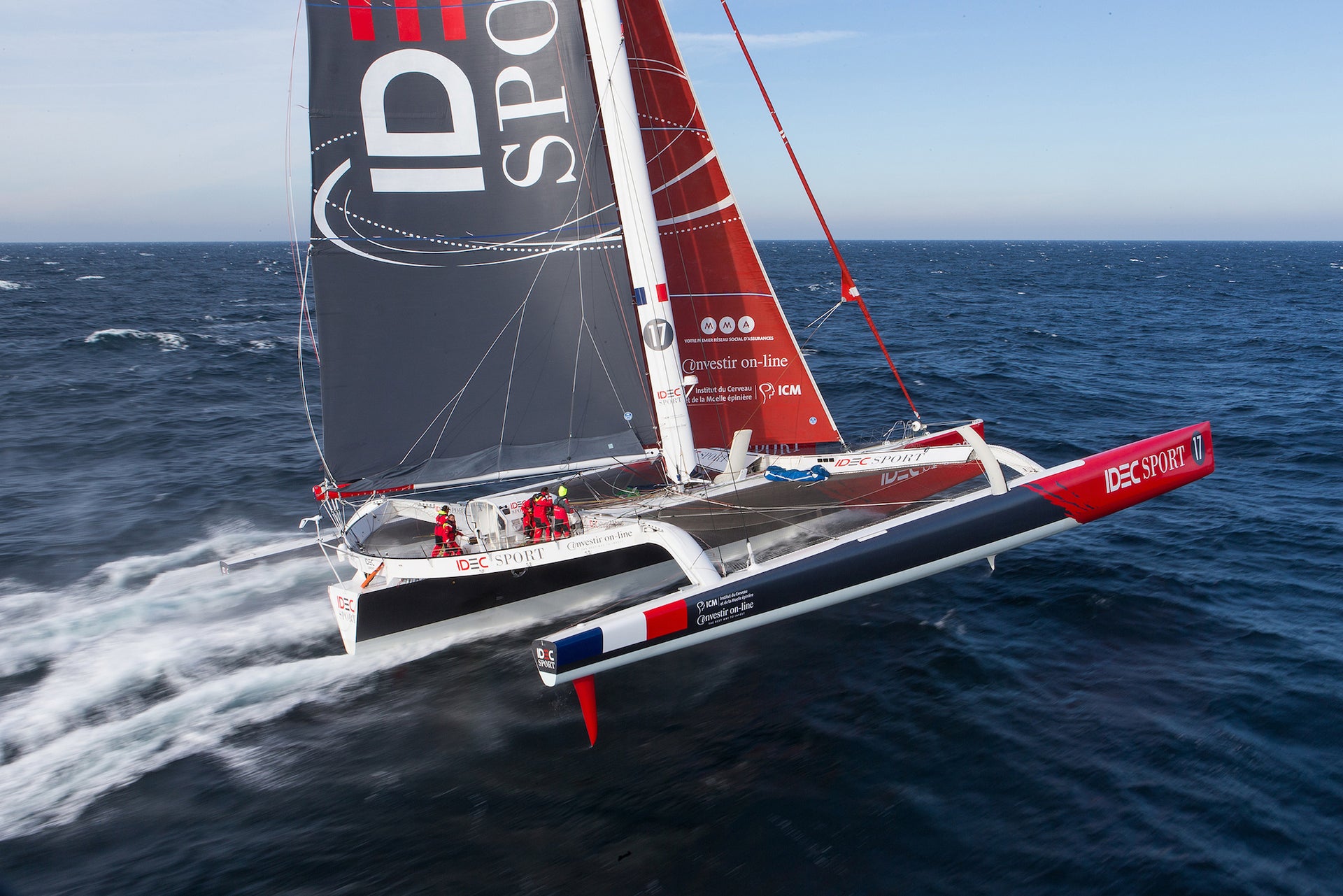
2018 ROUTE DU RHUM VICTORIES
Whether you finish at record speed or simply finish, completing the Route du Rhum is a major accomplishment; one that is met with a rum punch after sailing 3,542 miles. The 2018 edition of this solo transatlantic race to Guadeloupe saw breakdowns, repair detours and comeback stories for the history books. North Sails clients posted podium finishes in five of six classes, a podium sweep in the Ultime class, and captured half of the podium overall. For the North Sails loft in Vannes, France, seeing our client success is the culmination of years of hard work. This most recent edition of the race represented 130 new sails, and some 6,000 hours of work for the Vannes based team, with more than 1,000 sails across the fleet.
Our only disappointment? We have to wait another four years for the next race.
IDEC Sport sets new Route du Rhum record, placing first overall and first in Ultime division. © Yvan Zedda/ #RDR2018
3rd overall, 2nd place Ultime division, Francois Gabart’s MACIF © Yvan Zedda / #RDR2018
First place Multi50, Reaute Chocolat, skipper Armel Tripon © Yvan Zedda / #RDR2018
Third place Ultime, Thomas Coville’s SODEBO © Eloi Stichelbaut
READ MORE
READ MORE
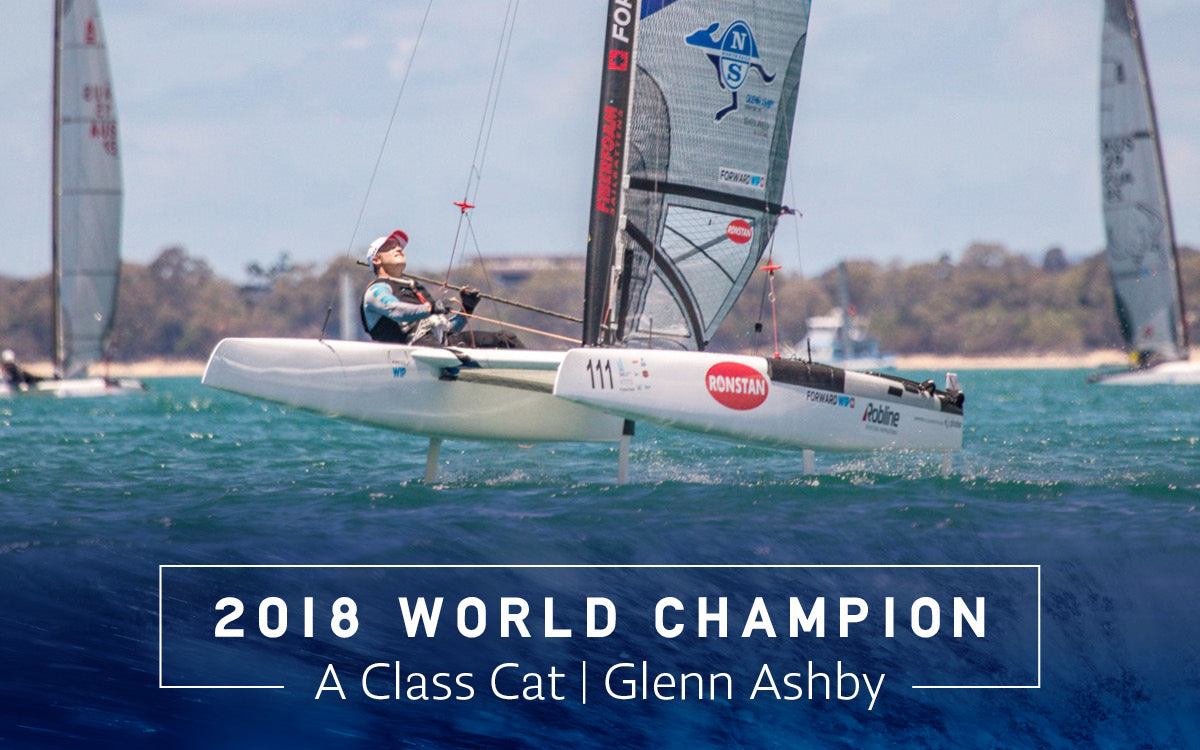
GLENN ASHBY FOR THE A-CAT WIN
GLENN ASHBY CROWED 2018 A-CLASS WORLD CHAMPION
The Multihull Superstar Won Six of Nine Races In Hervey Bay
Winning a World Championship could be considered a once-in-lifetime accomplishment. Not so if you’re world class sailor, and multihull superstar Glenn Ashby, who has won this tenth (!) title in the A-Class Catamaran. Glenn posted first-place finishes in 6/9 races sailed in Hervey Bay, Queensland, Australia, leaving him with half the points of his second closest competitor.
Beyond his talents on the water, Glenn has been working in collaboration with North Sails on the ‘Glenn Ashby Signature Sails’ since 2016′ a series designed by Glenn himself. Glenn, as well as third place Worlds finisher Blair Tuke, used the most recent version of the Decksweeper Mainsail. It’s a safe bet that Glenn is already thinking about the next round of updates that will then go into the next generation of his A-Cat sails.
📸 Gordon Upton Photography
READ MORE
READ MORE
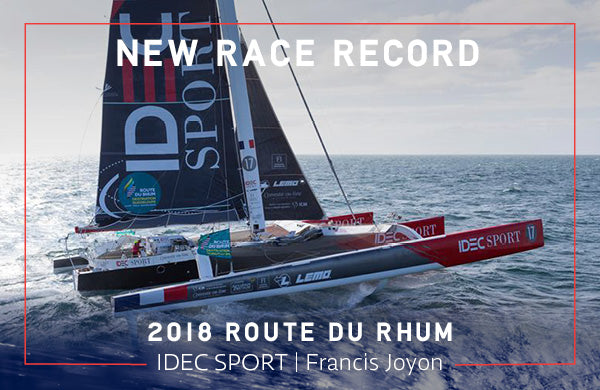
IDEC SPORT SETS A NEW RECORD
RECORD SPEED FOR IDEC SPORT
2018 Route du Rhum Completed In 7 Days, 14 Hours, 21 Minutes
📸 Jean-Marie Liot / Alea / IDEC
Francis Joyon has set a new race record and won the 2018 Route du Rhum, in what was the closest finish since the race began in 1978. The transatlantic race came down to the final moments with Joyon closing out François Gabart and the wounded Macif by a mere seven minutes and eight seconds.
This is the eighth Route du Rhum for Joyon, an offshore sailing veteran, who has set multiple speed records throughout his career. Joyon beats the previous Route du Rhum record set by Loïck Peyron in 2014 by just 46 minutes and 45 seconds. For an extra twist in the plot, Joyon was sailing an older generation Ultime, the same boat Peyron sailed in 2014 under the name Banque Populaire VII.
Bravo Francis! And the entire North Sails network joins your team in cheering #GoFrancis.
📸 Jean-Marie Liot / ALEA / IDEC
READ MORE
READ MORE
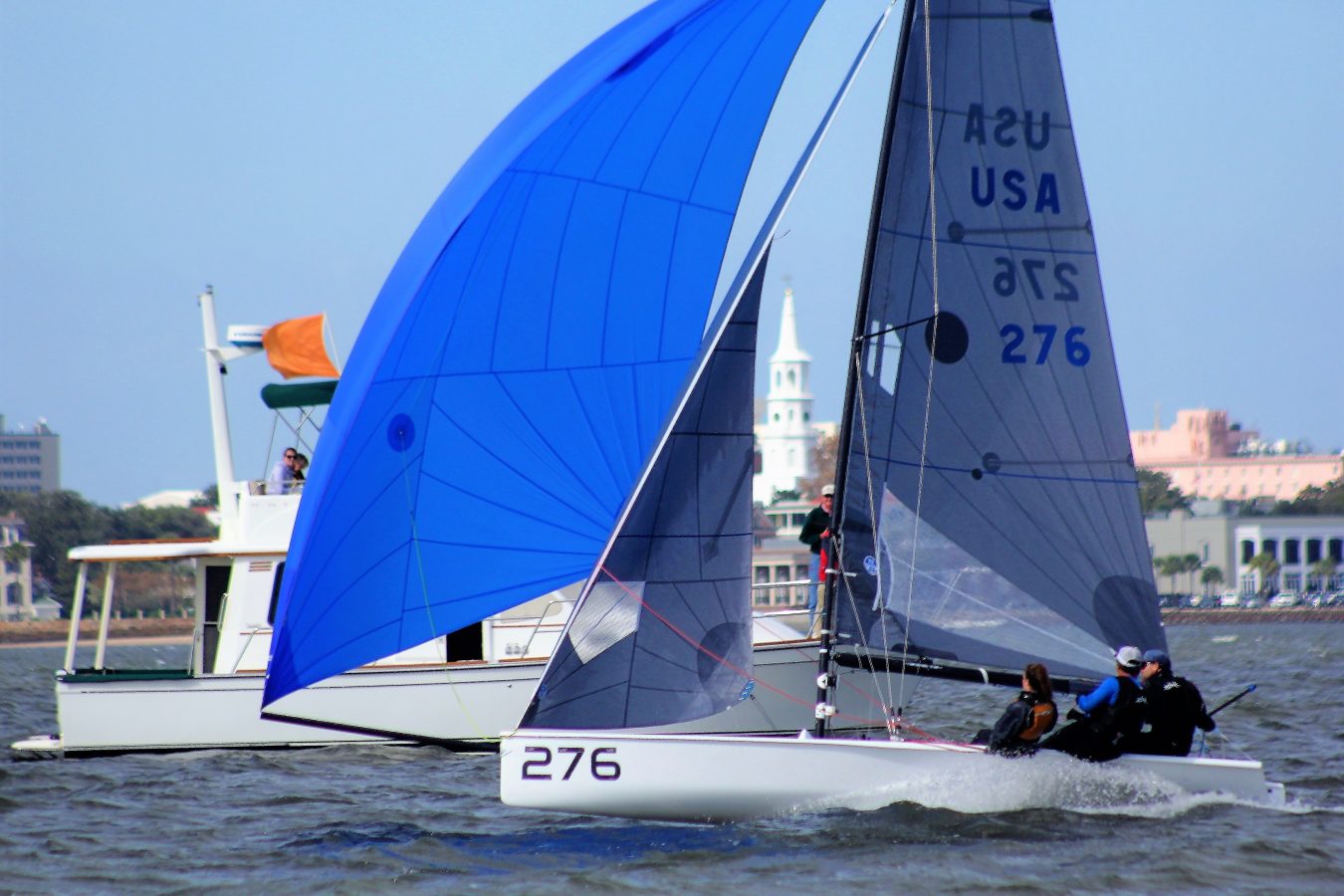
VX ONE NORTH AMERICANS: FAST, FUN & FIERCE
VX ONE NORTH AMERICANS: FAST, FUN & FIERCE
Interview: Making the VX One Go Fast
2018 North American Champions – Christopher Alexander, John Bowden and Caroline Main. © Priscilla Parker
Charleston delivered excellent VX One sailing conditions for the North American Championship the first weekend of November. Strong breeze, flat water, and of course a little bit of that Charleston current. The southern hospitality offered from the Carolina Yacht Club put an exclamation point on the event.
The VX One has been gaining traction as a class over the last few years, and this year’s North American Championship proved to be the deepest field of competitors yet. Racing was fast, fun, and fierce with boats reaching 20 knots of boat speed in the strongest puffs. The sheer fun had by sailing these boats might just outweigh the stiff competition.
We caught up with the winners of the event: Chris Alexander, John Bowden, and Caroline Main, as well as North Sails designer Mike Marshall and class president Jeff Eiber (sailing together, finishing 2nd) to learn what makes a VX One go fast and what the class is all about.
Interview by Jackson Benvenutti
John, this was your first regatta in the VX One. What was your basis for the winning rig tune? Any specific ratios between the uppers, lowers, and check stays?
I didn’t have a good idea of the ratios as first, and I was interested in working to help create a new tuning guide, so we were trying a few different things out (be on the lookout for that new tuning guide soon!). Most importantly, I was trying to induce headstay tension with the lowers and the vang.
A good way to think about it is that the boat is always either looking for power, or needing to de-power, which is fully controlled by headstay tension and de-powering the jib. De-powering the main was fairly easy, but de-powering the jib proved to be a little more complicated without affecting the mainsail shape.
There is always a debate in the VX One class about team weight and sailing with two or three people. Chris, your team sailed with three people. What was your total team weight and what are your thoughts about sailing with three people? Would you consider always sailing the boat at that weight, and with three people?
I am fairly small so I have sailed most big events with three. We were approximately 435 lb total and I believe that it was a very good all around weight for the regatta and the varying conditions we saw. I would say we were perfect weight on day one (10-16 knots), about 40-60 heavy on day two (6-12 knots), and 40-60 light on day three (15-20 knots).
Sailing with three can get a little crowded but you have an extra set of eyes and hands. Caroline did a great job of expediting tuning adjustments at mark roundings, trimming jib downwind, and moving weight where it was needed.
2nd Place – Mike Marshall, Jeff Eiber and Jo Ann Fisher. © Priscilla Parker
Chris, you’ve been sailing the VX One for a few years now, this was John’s first regatta ever in the boat and Mike’s second regatta in the VX. Can each of you speak a little bit about your experiences with the boat and the class?
Chris – This was my fifth North Americans and I have had an absolute blast owning this boat. The design of the boat is superb—the construction of hull, rig, and sails are of robustness and high quality—and the people of the class have become family. It’s a hard sell to get me to sail other boats now, because this one is just so good!
John – The boat is great, super responsive, it can change gears quickly and is fun to sail. I’m looking forward to seeing how the class develops and grows.
Mike – So far, I have spent 5 days in the boat and frankly, I have loved every minute of it. The boat is a blast to sail both upwind and downwind and I look forward to seeing more people start sailing them. The class is still in its beginning stages, but the key points about everyone having fun while keeping the racing at a very high level are there. As I have said in the past, the boats reward people that sail them flat and fast, so the sooner that you can achieve that mode, the better you are going to do in the race.
It isn’t very often that you find a boat that makes you come off the water grinning ear to ear about how fun the sailing was. I don’t think I will ever forget ripping downwind in the last race right next to Chris’ boat thinking about how awesome the boat was and how great that photo opportunity was for the class!
Chris, this is your second time winning the NAs, can you tell us two main things that are particular to the VX One, both upwind and downwind, that you focus on to make sure your VX One is sailing fast?
The times in the past where I haven’t felt fast have been due to rig tune or weight. These boats have a flat bottom and little rocker, which makes them accelerate quickly and be weight sensitive. Tuning to your weight, and how the boat feels that day becomes very important. I had very little experience with the technical rigging aspects of what makes a sport boat like the VX One go fast when I bought the boat, but have been enjoying the learning process.
UPWIND – Caps and Intermediate shrouds are the ‘gross’ rig adjustments and should be VERY high on the mental priority list pre-start since they can not be adjusted after. After the start we made constant adjustments to vang and main sheet, and very little movement on the jib. John was trimming the main and would tell me if we were fully trimmed or eased, and I would relay back how much vang tension, from 0-100%.
John was relentless on playing the main and focusing on how much power we were putting into the boat. My hand never left the vang line, and would adjust on nearly every puff. John probably made 1-4 adjustments on the jib halyard each windward leg was well. The short fetch caused such puffy conditions we were going through quite a lot of gear changes. John was also very adamant about not pinching and I feel that combined with quick gear changes got us through the ever changing breeze faster than the rest.
DOWNWIND – Weight and kinetics were probably the two biggest factors of straight line speed. We were very dynamic and highly focused on what mode we were in. Body weight was generally moving diagonally across the boat, either low and forward, or up and back. We sailed “normal,” as John would say, but focused on the minutia of our execution to go fast.
3rd Place – Lawrence Frost and Jackson Benvenutti. © Priscilla Parker
Mike, you obviously are an excellent sailor and sail designer. What was your biggest take away from this regatta in regards to sailing the VX One?
My biggest takeaway was that you absolutely must get the boat going fast. In any condition, you have to focus on speed. Once you are going fast, then worry about getting height upwind, and going the right direction.
To get that speed:
HEAVY AIR: I was easing the main out 4 feet at times in the overpowered conditions, and dropping the jib car down on the track to keep the jib from luffing the eased main.
LIGHT AIR: In the lighter conditions, I was keeping the jib telltales flying straight all the time to keep moving fast.
DOWNWIND: Downwind I was always trying to push the boat as low as possible as long as I was going the same speed or faster than everyone else.
KEEP BOAT FLAT: I was focused on keeping the boat flat. Six degrees of heel is what I heard was optimal. That, while sailing, feels like the boat is about to capsize to windward on you. But when you heel over, the boat pivots on the leeward buoyant edge that is way away from the centerline. This means that not only does the keel get shorter from the rotation, but also from the boat lifting out of the water. It is a double negative. Sailing the boat flat is fast and staying fast is the key in my mind.
Jeff, you’ve been sailing VX Ones now for a few years and you are the class president. How do you see the class evolving and what kind of people do you think would enjoy racing in the VX One class?
Over the years I have seen a spectrum of teams returning to the dock with big smiles after sailing and racing a VX One: junior sailors, collegiate sailors, Olympians, couples, moms and dads with young and grown kids, women’s teams, grey haired old guys… The one common thread tying these groups together is a modest level of fitness. The boat is not overly physical, especially offwind, but rewards a willingness to hike upwind and a sensitivity to speed and balance.
At the same time the boat is very forgiving to errors. Wipeouts and capsizes result in the boat coming to a stop while the 68 kg (150 lb) lead bulb on the keel prevents turtling. The open transom means no bailing. These features make the boat a fantastic learning platform for beginning and intermediate sailors.
Boats and fleets are spreading worldwide. There are boats in Canada, Great Britain, France, Germany, Switzerland, Hong Kong, Chile, Australia, New Zealand, United States. The next step for the class is to pull these owners together into a truly international class.
Another step in our evolution is to settle on the best setup for the boat. The way we sail the boats in North America is in the slowest configuration: fractional kite, no trapeze and with the lead bulb. But the boat is engineered to have a masthead kite, trapeze and no bulb…can’t wait to try that setup! Or maybe we develop racing for both configurations.
Starting line at the 2018 VX One North Americans. © Priscilla Parker
2018 Vx One North Americans
1
Christopher Alexander
2
Mike Marshall
3
Lawrence Frost
4
John Potter David
5
Jerry Callahan
6
Sam Padnos
8
Rob Doolittle *
9
William Curtiss
10
Paul Murphy
* Denotes Partial North Sails Inventory
Learn more about the North Sails products for the VX One.
READ MORE
READ MORE
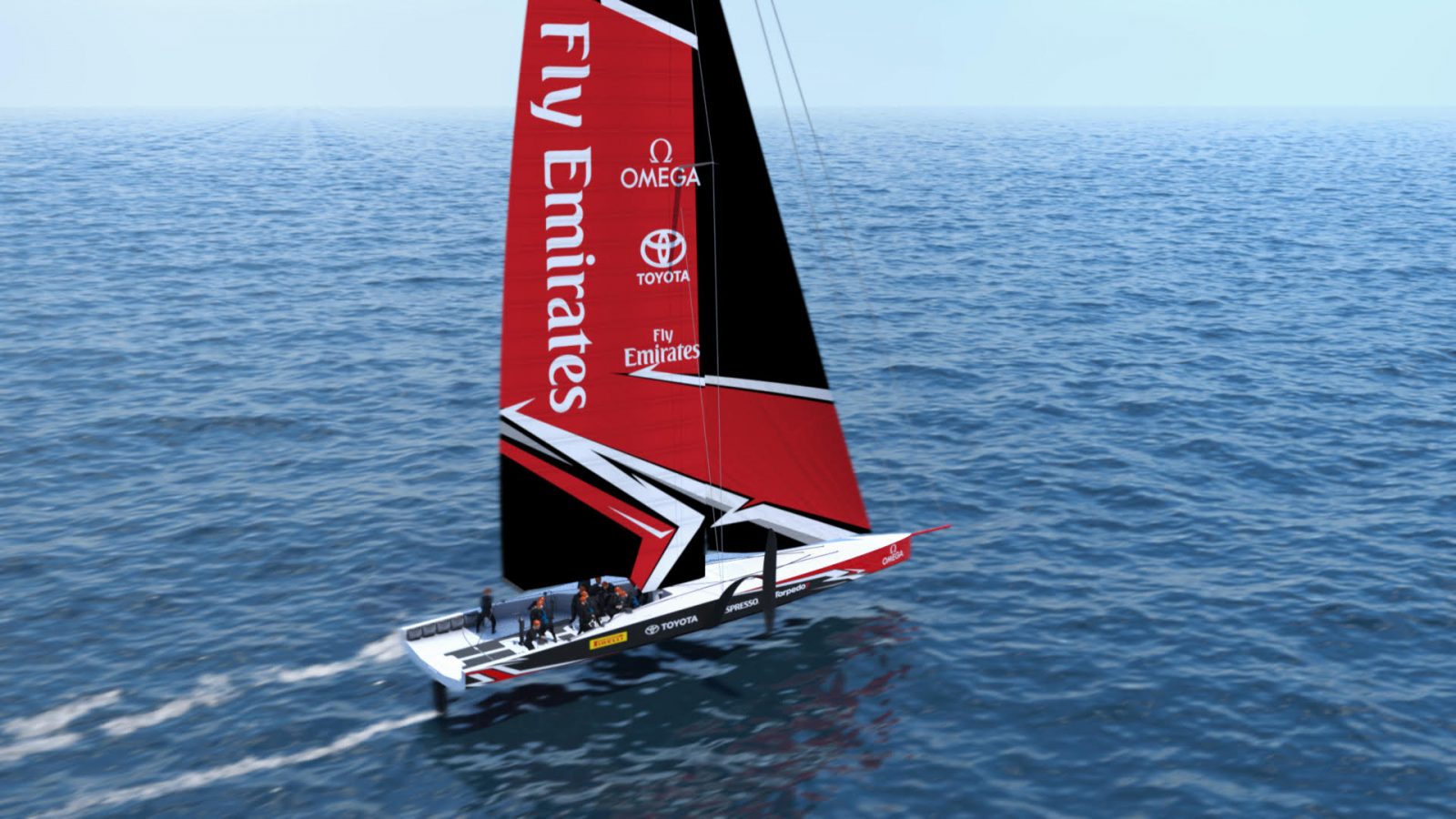
NORTH SAILS CONFIRMED SUPPLIER FOR 36TH AMERICA’S CUP
North Sails is once again leading the way in the America’s Cup as Defender Emirates Team New Zealand and Challengers Luna Rossa and INEOS TEAM UK have confirmed the global leader in sailmaking as the supplier of choice in the next event.
READ MORE
READ MORE
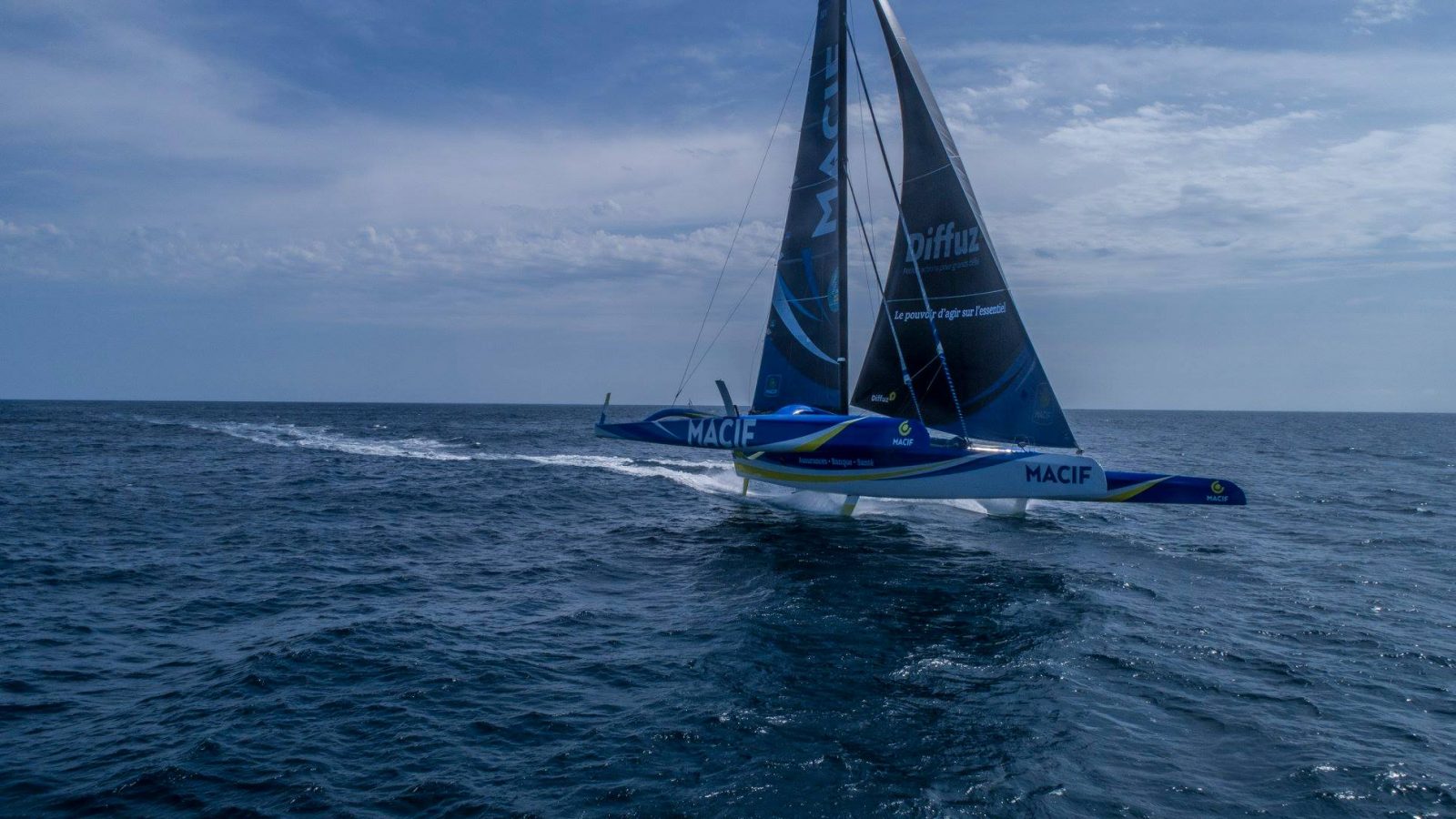
2018 ROUTE DU RHUM
2018 ROUTE DU RHUM
Fast Sailing, Foils and High Expectations Across The Fleet
📸Alexis Courcoux / 2018 Route du Rhum
The Route du Rhum is a prestigious offshore event and an example of single-handled ocean racing at its best. First sailed in 1978, the Route du Rhum was a transatlantic race introduced to overthrow conventional wisdom; monohulls sailing alongside multihulls, pro sailors racing against amateurs. The first edition of the race featured 38 entries and the winner finished in 23 days. In 2014, Loïck Peyron set a new course record of 7 days, 15 hours, 8 minutes and 32 seconds.
Four year later, 123 sailors and thousands of North Sails across six classes will hit the start line in St Malo, France, and set off 3,542 miles for Guadeloupe. The 2018 Route du Rhum represents 130 new sails and some 6,000 hours of work for North Sails, and specifically, the Vannes-based loft.
“The diversity of projects in this race is something which is important for us,” commented Greg Evard, country manager for North Sails in France. “Responsiveness is essential; listening, understanding and acting in the shortest possible time when necessary, with the goal to ensure that those who trust us do not lose any time sailing.” The key to success lies in the integrated teamwork between design, production and service.
Greg’s team efforts on the ground combined with the global design and product expertise has paid off; evidenced by growing market share for North Sails across the Route du Rhum fleet. Gautier Sergent, the Head of North Sails R&D, based in France added. “The advent of foiling has forced us to redesign our sails for the IMOCA and Ultim classes, because with the foils, everything changes: speed, apparent wind angle, torque, geometry, deck plans…”
With 3Di™, North Sails has a technology that perfectly matches the new challenges imposed by these out of the ordinary machines but still allows every level of sailor in this race to have the best possible suite of sails. It is going to be an exciting race and as is ever the case, when a fleet of boats leaves the dock, anything can happen.
READ MORE
READ MORE
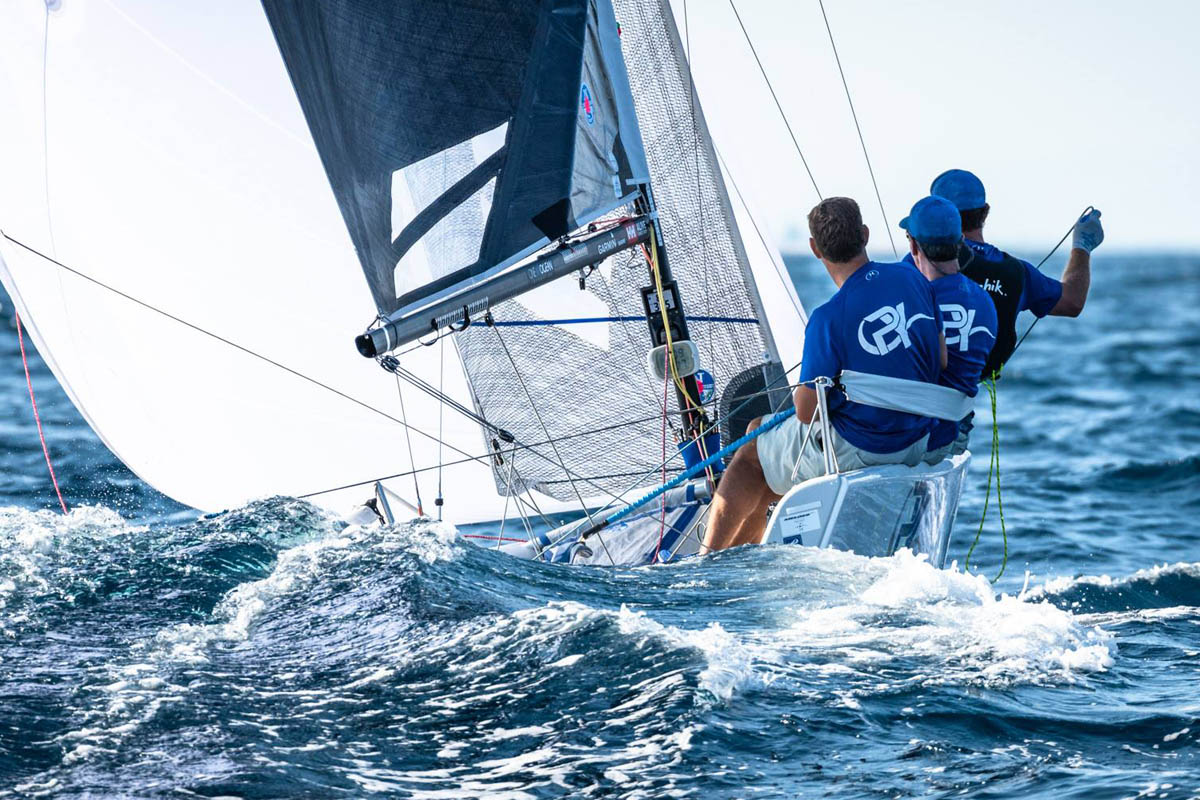
MELGES 20 SPEED READING
MELGES 20 WORLDS: SPEED READING
Two-time World Champion Drew Freides Shares His Views on Winning Speed
The waves were bumpy and the wind was hard to read at the 2018 Melges 20 Worlds in Cagliari, Italy. That put a premium on speed at all times for the crew of Pacific Yankee, which earned its second championship title in a row.
Racing in a tough 38-boat fleet, Drew Freides, Morgan Reeser, and Charlie Smythe won the last two races to earn the title by a point. What made the difference?
Skipper Drew Freides credits his teammates, coaching, planning, and preparation, and says one key, after winning the 2017 Worlds, was adopting the attitude, “We’ve got to improve because everyone else is going to improve.”
“One thing I’m good at is that I’m scared of failure.” Drew says, “so I’m never content. I always feel like someone’s going to pass me and be better.”
Build a Speed Matrix
“Over the year, we focused on a matrix for boat setup,” Drew says. “Vince Brun, our coach, was maniacal about it. When we’re racing we don’t want to think about boat setup—we want to focus on sailing well and sailing smart. The matrix is marked as number of turns on and off the uppers and the diamonds and is easily repeatable. We developed ours by starting with the North Sails Tuning Guide, and it evolved from there based on our work with sail designs and our observations.”
“We always put the rig back to base setting at the end of the day,” he adds. “Sometimes we check measurements with calipers and once in a while with a tension gauge.”
Think “Dead Stick” and “Unload the Boat”
Drew says to go fast the boat can’t be loaded. It should have more of an “easy” feel. “On our boat,” he says, “Morgan is focused on tactics, and Charlie on speed, but Morgan is holding the mainsheet. When we wanted speed, Charlie would say to him ‘free it up,’ meaning to unload the boat. We’d go for a flatter mode for the sails, put the bow down, and get it ripping. When we wanted height, I’d ask for more load on the helm, which meant more leech tension, rounder sails.”
“The boats are tippy, and heel is your enemy. You’d be surprised how much the boats heel. You really want the tiller to feel like a “dead stick”…the less feel we had, the faster we went. It takes time getting used to it.”
“The upper shrouds on a Melges 20 are on cars,” says Drew. “Charlie spent a ton of time adjusting uppers, forward and back. We would set ourselves up going off the starting line with the car forward. We’d go a tenth or two slow, climb and build our hole, then once we were in clear air, we would move the cars back and put the bow down. Once you get the boat going fast, it points high on its own.”
Upwind in Lumpy Conditions
At Cagliari, Drew says, “it got very lumpy, which put a premium on accelerating and rebuilding speed quickly. We needed a good balance of sail depth for power, but not so much that we couldn’t put the bow down and go.
“On the second to last day, port tack was brutal. We had a great setup and could put the bow down and rip up to 5.9 knots. When you hit waves, it was important we were already going fast and not trying to climb. If Charlie said, ‘Bad set coming,’ Morgan would ease the main and I’d bear off. If Charlie said, ‘Flat spot,’ Morgan would sheet in and we’d start climbing. The biggest gains to be made were in terms of height, but that’s only because we were already going fast.”
Same Speed and Lower, Downwind
“The goal downwind was to sail the same speed but lower,” says Drew. “ When it got lighter, it was an uncomfortable low mode. With spinnaker sheet in his hand, Charlie coached me how low we could go. We were constantly looking to soak and never have the boat loaded. We never had enough wind at the Worlds to sail higher and get beyond lazy planing.”
“Some thought we had special sails, but for the record, we used North’s R-2 and V4-2R, off the shelf. We used the V4 more than you would think, down the wind ranges, because it let us heat it up and get onto some of the waves. The R-2 is not as comfortable reaching so we sometimes used the planing chute even though we were trying to soak low.”
Read more about Pacific Yankee’s victory at the 2018 Worlds
“In the 8- to 12-knot range when not overpowered, use rounder sails and hike really hard. We were sometimes too quick to depower.”
READ MORE
READ MORE
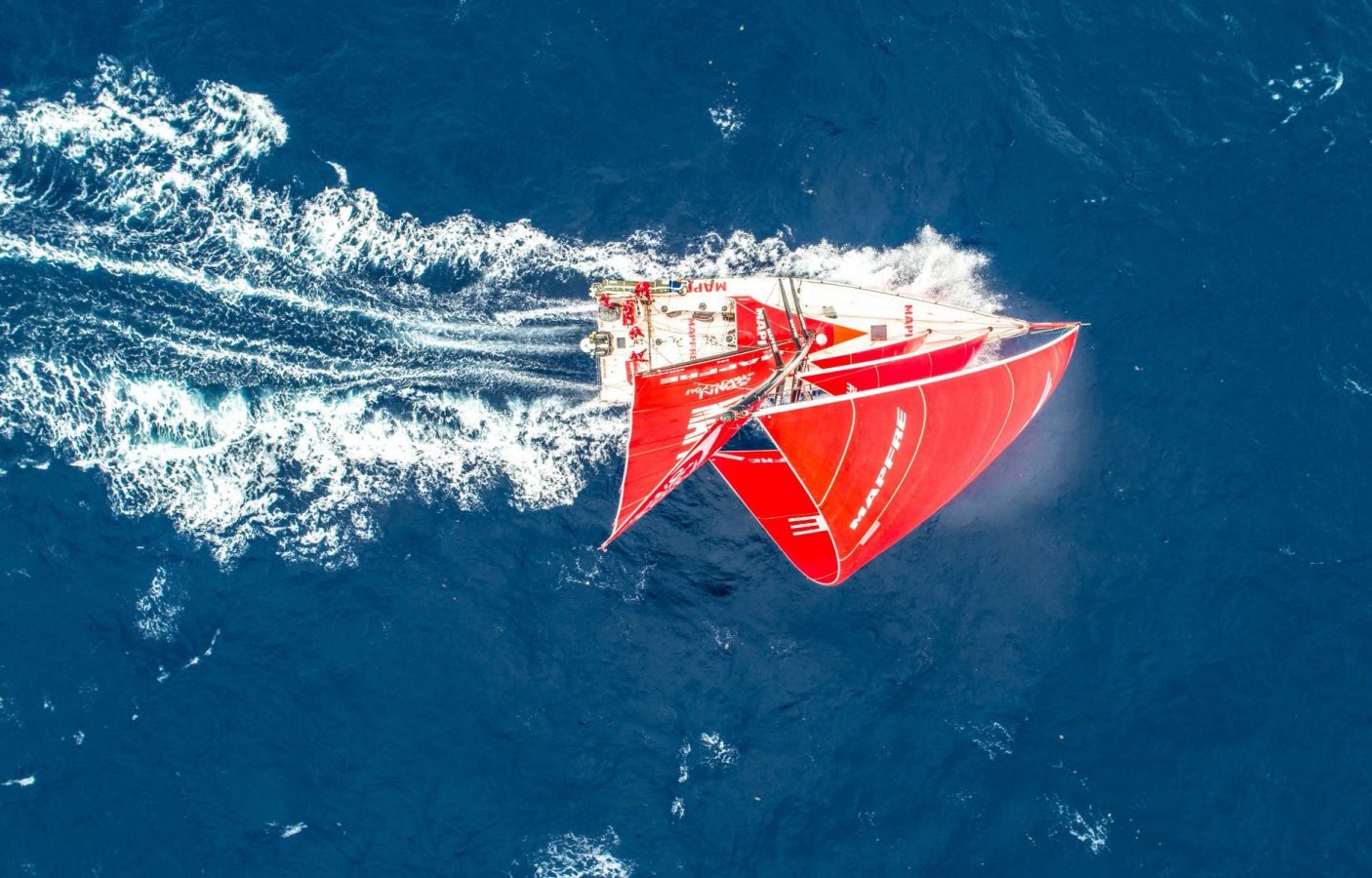
VOLVO OCEAN RACE 2017-18 DEBRIEF
45,000 MILES OF EXTREME TESTING
The North Sails Volvo Ocean Race 2017-18 Debrief
📸DongFeng Race Team / Volvo Ocean Race
The Volvo Ocean Race has long been considered a proving ground for the best offshore sailors in the world. And for the industry-leading marine companies who supply the equipment on the VO65 race boats, this race is where they get pushed the hardest to find solutions for the extreme conditions crews encounter. Such is the case for North Sails, which designed, built, and maintained the one design sail inventory for the 2017-18 fleet.
“This is the toughest race in the world, where fully professional crews push the boats, the rigs, the sails and themselves beyond what was considered to be the limit,” says North Sails President Ken Read, a skipper in two previous editions of the race. “And it’s not just for a day or two or a few hundred miles, it’s all the way around the world, over eight months of racing.”
“For us here at North Sails, there really isn’t a better way to test ourselves. This pushes all of us to stay at the top of our game.”
The intensity of the racing, especially in a one design class like the VO65, makes an event like the Volvo Ocean Race a perfect feedback loop on sail design, engineering, and manufacturing process for North Sails.
This edition of the race allowed more feedback than ever before, partly because of the increased use of drone video, which was sent directly off the boats by independent On Board Reporters, who weren’t being censored by the teams.
“From all the footage, we learned early in this race just how hard these guys and girls are trying to destroy our sails,” Read said, only half-jokingly. “It turned out to be really valuable to see how they sail the boat in real-life racing conditions, compared to what we hear during debriefs during the stopovers. Getting a better understanding of the real use allows us to think about where we can make improvements that will have a positive impact.”
Gautier Sergent was the head of the Volvo Ocean Race 2017-18 project for North Sails. He managed the design and build process, in order to supply the fleet with identical suits of sails, and then oversaw the event-supplied maintenance provider, The BoatYard, at each stopover.
“We try to prepare the sails so they will stand up to everything they will encounter, but I’ll admit, that despite this being my fifth Volvo Ocean Race, I was a little surprised when I saw some of the footage,” he said. “There were a few moments when you say, ‘Oh God… This is what they’re really doing out there.’ I think of it as the expected, unexpected moments.”
Use and abuse of the sails comes with the territory when professionals are gybing along an ice exclusion zone in the Southern Ocean, but this race also saw the crews use the sail inventory in unexpected ways. One technique the teams discovered between the design of the sail plan and the first legs of the race was to sail ‘triple-headed’, sailing slightly tighter angles downwind and flying the Code 0, J2 and J3, instead of a newly designed A3.
“The intention,” Sergent said, “based on what we heard from the sailors after the last race, was to increase the range of the new A3, which would allow them to sail slightly higher and to carry it in stronger winds. The complaint in the last race was that it was too much of a strictly downwind, VMG sail. So we wanted to make something more versatile.”
But in training, some of the teams discovered the more efficient triple-headed configuration, which offered a similar sail area with a much lower center of effort. The technique spread like wildfire through the fleet.
“We spent a lot of time testing before the race started with team AkzoNobel,” said Charlie Enright, the skipper of Vestas 11th Hour Racing and a North Sails expert. “The results were fairly conclusive. You saw the two of us sailing like that out of the start in Alicante and we were one-two in that leg pretty quickly. And that was it for the A3… maybe we should have kept our powder dry a little bit longer!”
📸Desafio / Volvo Ocean Race
Charles Caudrelier, the skipper of the winning Dongfeng Race Team, confirmed there was a lot of watching the opposition and learning from the others in the fleet.
“After the first leg, everybody realized that Vestas 11th Hour Racing and AkzoNobel were much faster using the Masthead 0 and by Leg 2, everybody started to sail like this and we never tried the A3 again!”
For Read, the saga of the discarded A3 was further confirmation of what he’s long known – good sailors still figure out how to trump computer modeling predictions.
“We designed that sail based on the feedback from the previous race and everybody tested it and they loved it,” Read said. “Everyone went into the race thinking the A3 would be a huge part of the sail inventory. Then, as it turned out, they never used it!”
“What happened is, the sailors figured out a way to sail the boat completely differently from the way anyone imagined. That’s where creative sailors always win. And even though it was an option they all wanted, they essentially made a new sail obsolete just by figuring out a better way to race the boat faster with the rest of the sails. And that technique and thinking is going to trickle down through other fleets too.”
That wasn’t the only learning in the 2017-2018 race. The new J0 was designed to limit the number of sail changes needed upwind and to enhance fast reaching, where it outperformed expectations. Yet it was not the pick in the quiver for pure upwind VMG sailing.
Perhaps the biggest success was just how structurally reliable the sail wardrobe was across the fleet. With seven boats racing 45,000 nautical miles around the world, there were no failures that could be attributed to the supplied inventory.
📸 Vestas 11th Hour Racing / Volvo Ocean Race
“I think it can be easy to overlook what happened here,” Enright said. “When you don’t hear about something, in this case, it’s a measure of success. There’s a lot of assumed resilience at this stage, which is a bit of tribute really.
“Most of the sails were carried much further up-range from what they were structurally intended to be and as the race wore on, it became obvious that if you wanted to rise to the top, you really had to push the gear and the sails were no different. And yet, across the fleet, there were no problems. You just never had to worry about it.”
It’s even more impressive considering that the most recent inventory was built with 3Di RAW, not the 3Di Endurance product that was used for the 2014-15 race. By discarding the outer polyester film on both sides of the sail, there was a considerable weight saving; mainsails were a full 8 kilograms lighter.
The sailors appreciated both the weight saving and the durability; they could focus on pushing hard, rather than protecting their limited sail allocation.
“With the 3Di RAW sails, we thought they would stand up to whatever we would see,” Caudrelier noted. “We didn’t worry about breaking the sails, but when we started the race we wanted to preserve the shape. The potential for damage is usually highest when we peel to make a sail change. The original idea was always to bear away and take care for every peel. But the race was so close that we almost never did this and I’m sure some of the other teams did it even less than we did. Even so, we knew we could trust the sails.”
“For our part we were confident that the 3Di RAW sails would survive for the race,” Sergent said. “We had used them in IMOCA before, and even though those boats aren’t pushed as hard as the Volvo Ocean Race boats, we felt the sails would hold up fine.” The IMOCA reference is timely, as the next round-the-world crewed race will feature two classes: the high-performance, dynamic, foiling IMOCA 60s as well as the one-design VO65s that have provided such close racing over the past two editions.
The move to IMOCA means the sailmaking design space is open once again. For Sergent, it’s a welcome challenge.
“As a company, North Sails is all about innovation and development and we think we do a better job when we can really show the potential of our expertise, our knowledge, and our tools.”
“We’re already starting to work on a bit of a starter package for our designers and customers,” Sergent continued.”We’ve brought together our in-house experts in the IMOCA and Volvo Ocean Race and we’ve hired Rob Greenhalgh (MAPFRE watch captain) and Charlie Enright to bring some recent, relevant sailing experience to our team.
“We’ve won every edition of the Volvo Ocean Race (since 2001-02) and been the one design sailmaker for the last two editions of the race, and in IMOCA, boats with our sails have won the last two Vendée Globe races so we think we’re in a unique position.”
📸Volvo Ocean Race
“It’s exciting and it’s going to be a big challenge,” agreed Read. “We’ve been working with IMOCA 60s for a long time and we’ve had amazing success. We feel like with our people we have the design and engineering expertise, the software and the hardware to produce a winning package for a foiling 60-footer.”
“At the same time, I feel like this is going to be one of those campaigns where you start the race saying, ‘this is my plan’ and you finish the race using the equipment completely differently to what was anticipated. So we have to stay agile.
“Don’t underestimate it. This is a big jump. These are speeds that no one has imagined before for an offshore monohull. There will probably be sail geometries that nobody has considered before this.”
“It’s a brave new world and it’s not going to be easy. But because of our experience in the last couple America’s Cup campaigns putting sails on those foiling catamarans and now working with three of the four Cup teams this time around, I think we have the right people and that our software has evolved and adapted well to meet the challenge.”
If the past is anything to go by, that’s a safe bet.
📸 Volvo Ocean Race
📸Turn The Tide On Plastic / Volvo Ocean Race
READ MORE
READ MORE
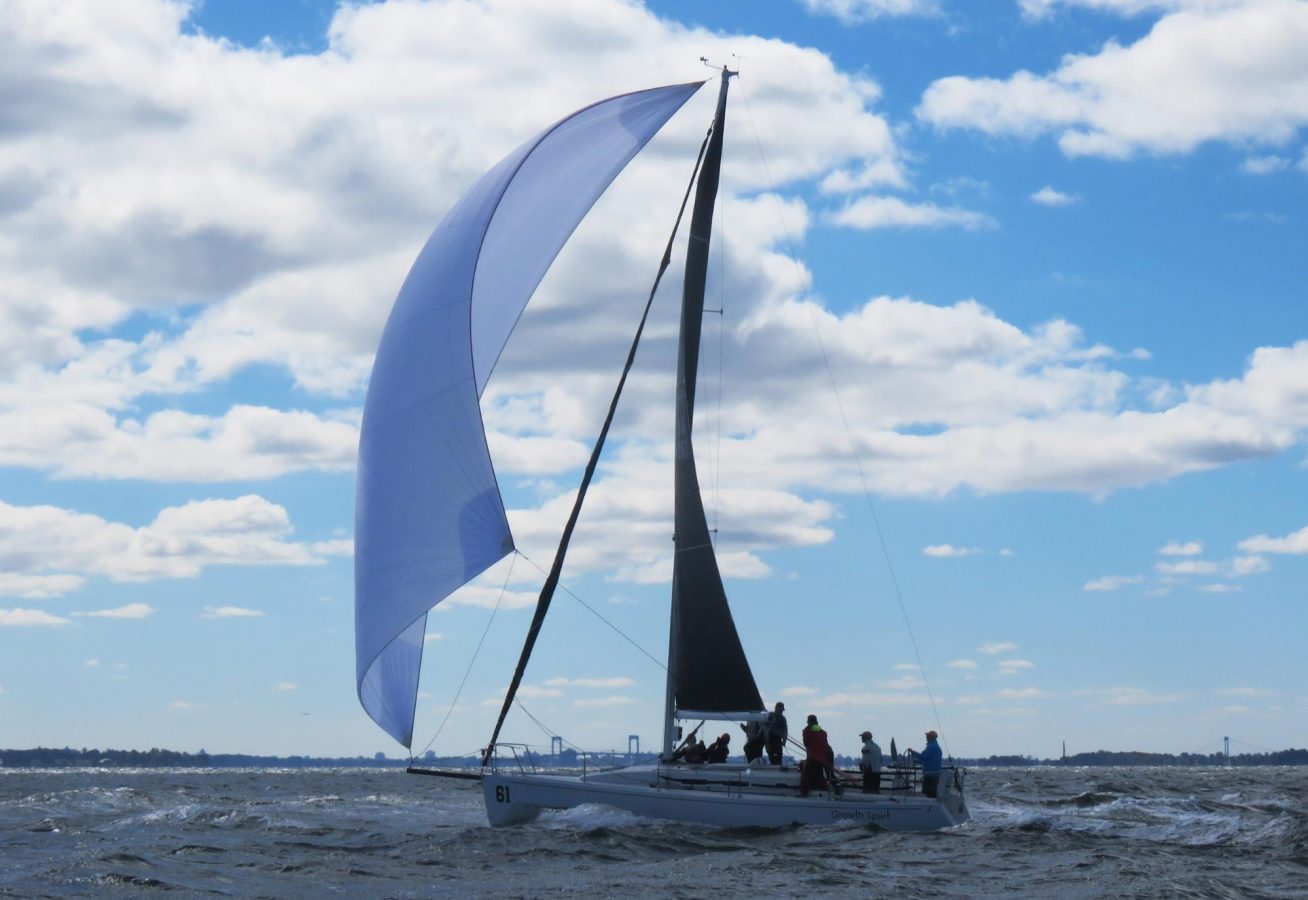
J/109 NORTH AMERICANS INTERVIEW
J/109 North Americans Interview
Growth Spurt Wins the Corinthian Title and Second Overall
Larchmont Yacht Club hosted the 2018 J/109 North Americans, with twenty teams in attendance. We caught up with John Greifzu, owner-driver of Growth Spurt, who won the Corinthian title and finished second overall.
John, congratulations on a great event! A pretty windy regatta. Any lessons in trim or technique from what you were accustomed to doing upwind? Downwind?
No kidding. With the big breeze, we kept our starts simple and talked a lot about our maneuvers to minimize potential surprises. Upwind, once we were able to achieve the right amount of twist in the sails, we found the speed we needed. Downwind, it was about sailing low and staying in control. Crew weight placement became even more important.
What kind of rig tensions were you setting up for the breeze on Friday?
Friday was our best day. The North tuning guide was a great start for rig tension. But when we tried going upwind, we realized the rig needed to be tighter. We put additional turns on the cap shrouds and D1s until the helm was balanced. The first upwind leg for each of Friday’s three races was really the key to making gains on the day. We were going fast-forward while other boats were going sideways, as they were overpowered and not flat.
The first top mark looked like a traffic jam most races. How did you manage to escape?
We approached the windward mark with a plan, and picked our spots to be aggressive. After giving away a podium spot at the American YC Fall Regatta with one bad decision at a windward mark, we were determined not to do that again.
We saw some boats using Tackline Drops, others preferring Jibe Drops and Weather Drops, and a couple using Strings. What was your preferred spinnaker drop? Any lessons to share from that?
We did not favor any certain spinnaker drop technique. We practiced them all going into the regatta, so our tactical options were always open. To be honest, with that many good boats on the course, we didn’t know what kind of takedown would be needed until we were close to the leeward gate.
Which sails did you use? How were you feeling with the new HAi-7 jib from North?
Our main was a North 3Di RAW from 2017. Going into the regatta it had 26 race days on it, and was still fast. On Thursday, Friday, and Saturday we used the new HAi-7 jib. It worked well in as little as 9-knots TWS and up through the range of gusts we saw on Friday. On Sunday, we used a 3DL AP jib from 2017 and that powered us in the lighter stuff. We also used the new A2-3 spinnaker for most races.
“Growth Spurt in about 20 knots of wind with the top of the main inverted, the bottom of the main working, and an appropriate angle of heel. An example of fast trim in heavy air ”, said North U expert Bill Gladstone.
Who sailed with you? How did the team prepare for the NAs?
We had an amazing group of Corinthian sailors who have put in a lot of time on the boat. Our official tune up was the American YC Fall Series, but I have logged a lot of miles with this team. Two of the guys, Richard Born and Joe Quick, I have been sailing with since our days at Tulane in the early 2000s. Rich trimmed jib and Joe handled pit on Thursday. The other crew members joined our program at various times since I bought the boat for the 2016 season.
Michelle Miltenberger was amazing on mast and bow assist, and Chris Mangieri, who I met on another J/109, was all over the boat helping with jib and spinnaker trim. Malcolm Kriegel, a recent Tulane alum from New York, has been sailing with us for three years and he trimmed spinnaker. I met our bowman, John Hughes, when he was assigned to my boat for the Storm Trysail Foundation Intercollegiate Regatta a couple years ago.
Ellen Quinn started racing with us last year and even moved work flights around to make it in time to run pit Friday through Sunday. Jon Singsen started sailing with us this year. He trimmed main and called great tactics.
Congratulations Team Growth Spurt
What’s next for Growth Spurt?
This NA’s was our last event for the season, but we’re already talking about 2019! The initial schedule will have Block Island Race Week, the J/109 North Americans in New Bedford, and other one design events in Newport and Long Island Sound. Placing second and winning the Corinthian North American Championship was great, but we’re looking forward to mixing it up again with our friends on Loki (three-time North American champion).
© Howie McMichael
READ MORE
READ MORE
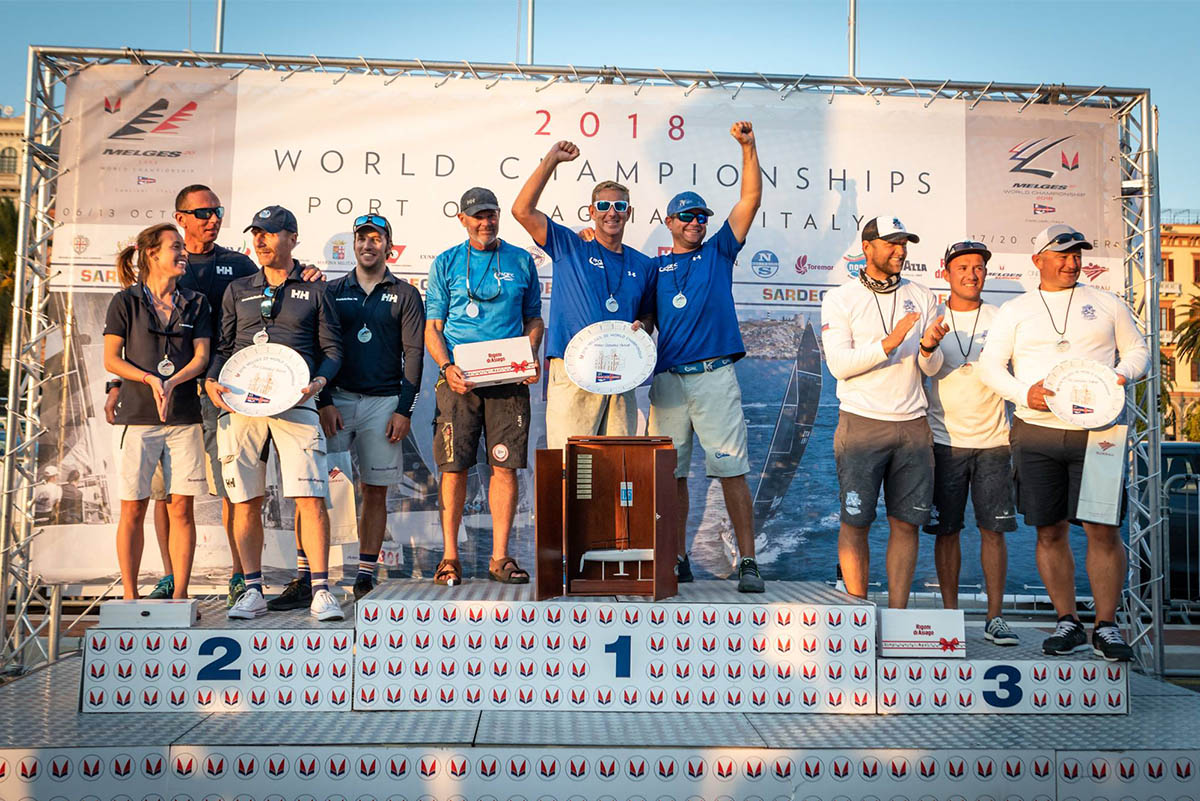
DREW DOES IT AGAIN
DREW DOES IT AGAIN
Pacific Yankee Team Wins Second Consecutive Worlds
📸 Mauro Melandri / Zerogradinord / Melges 20 World League
Drew Freides, Morgan Reeser, and Charlie Smythe have added themselves to the #NSVictoryList once again by winning the 2018 Melges 20 World Championship in Cagliari, Italy. A bullet in the final race moved them ahead of Brontolo Racing, securing the regatta win for these defending champions.
We caught up with Drew after he returned from Cagliari and he had a lot to say about how he got to where he is now.
“I’d be missing something if I didn’t thank North Sails because Tim Healy, Per Andersson, Vince Brun, and the One Design team have just been great. We would never have done what we did without their help along the way.”
: Morgan Reeser, Drew Freides, and Charlie Smythe with Coach Ed Adams. 📸 Mauro Melandri / Zerogradinord / Melges 20 World League“We owe a lot of our success to our coaches, too. Vince Brun was all about boat setup, Ed Adams was our weather and current guide, and having them both was really helpful. Ed also helped us with strategy and how that relates to how we sail, making him a great benefactor to our team.”
According to Drew, it all came down to the last jibe on the final downwind leg. “We were in second and we needed to put one point between us and Russian Bogartys. Meanwhile the Italians on Brontolo Racing were coming in strong so we had to keep passing boats. We jibed on the Russians coming into the finish line to move from second to first, a call made by our tactician Morgan Reeser. It was a last minute call, and Charlie wasn’t 100% ready but pulled it off; unfortunately it all happened so fast, Morgan got caught behind Charlie’s elbow. So in the end, the only thing we lost was Morgan’s nose.” Blood and sweat paid off in the end.
“In this fleet,” Drew continued, “you have to have the ability to dig back. It’s one thing to win a world championship, but it’s much harder to defend it because you’re in the spotlight and everybody is looking at everything you do and trying to match it.”
📸 Mauro Melandri / Zerogradinord / Melges 20 World League
Asked what he likes about the Melges 20, Drew commented, “There is just no boat out there like the Melges 20. It sails like a skiff-dinghy. It takes about 12 knots to get on a full plane and just rip! Also they have really complicated rigs and there’s a lot of nuance to the rig setup. Thanks to Vince and everybody, we really had our settings down.”
Drew also likes the need for constant improvement.
“The competition keeps you on your toes. We’ve been doing everything we can, trying to develop the 3Di Sails with our North Sails experts, and it worked well. Our competition is close behind though, so we still have to keep pushing. Personally, I never feel like I am good enough.”
📸 Mauro Melandri / Zerogradinord / Melges 20 World League
With sail purchases limited by year and activity level, sail selection is very important. “You want to have the best options. You start the season out with three sails, then after you’ve competed in four events, you get one additional button. Then you are permitted only two more for the Worlds.” Drew wanted to keep his options open, so he waited to pull the trigger on getting his sails measured in until he was 100% sure.
📸 Mauro Melandri / Zerogradinord / Melges 20 World League
Brontolo Racing started the season with using the new Mi-2 3Di mainsail, so Drew matched them. He felt going into the worlds 100% matched to his prime competition would make it a fair match. Regardless of the match, he is pleased with 3Di and how it adds to the program.
“We can honestly say we love 3Di. You can definitely see they last much longer, and that shape will hold and never fail. It never distorts, it looks perfect, and sets up like a wing. It’s phenomenal.”
“No matter what, we can hang with the front of the pack upwind. As soon as we round the top mark we rely on our speed, which is unbelievably fast. Downwind we use the standard Melges 20 models: the R2 Runner and V4-2R Reacher. Some of our competitors think we use something special, but it’s just the standard inventory available to everyone.”
📸 Mauro Melandri / Zerogradinord / Melges 20 World League
Drew has been sailing with the same team for a couple of seasons now and is proud of his program. “My motto has always been if you surround yourself with the best people, it gets a lot easier. We have the best team. We’ve got a good dynamic in the boat. We understand where the rig should be in any given wind conditions. From there, we go sailing and focus on sailing, not on anything else.”
📸 Mauro Melandri / Zerogradinord / Melges 20 World League
“North Sails is good at making sails. They want to create the best products for everyone. I love the company and I believe the sail technology far exceeds the rest, by far. With all the support we’ve received, it’s made a huge difference and has made this massive commitment a lot of fun.”
📸 Mauro Melandri / Zerogradinord / Melges 20 World League
📸 Mauro Melandri / Zerogradinord / Melges 20 World League
📸 Mauro Melandri / Zerogradinord / Melges 20 World League
Full results
READ MORE
READ MORE
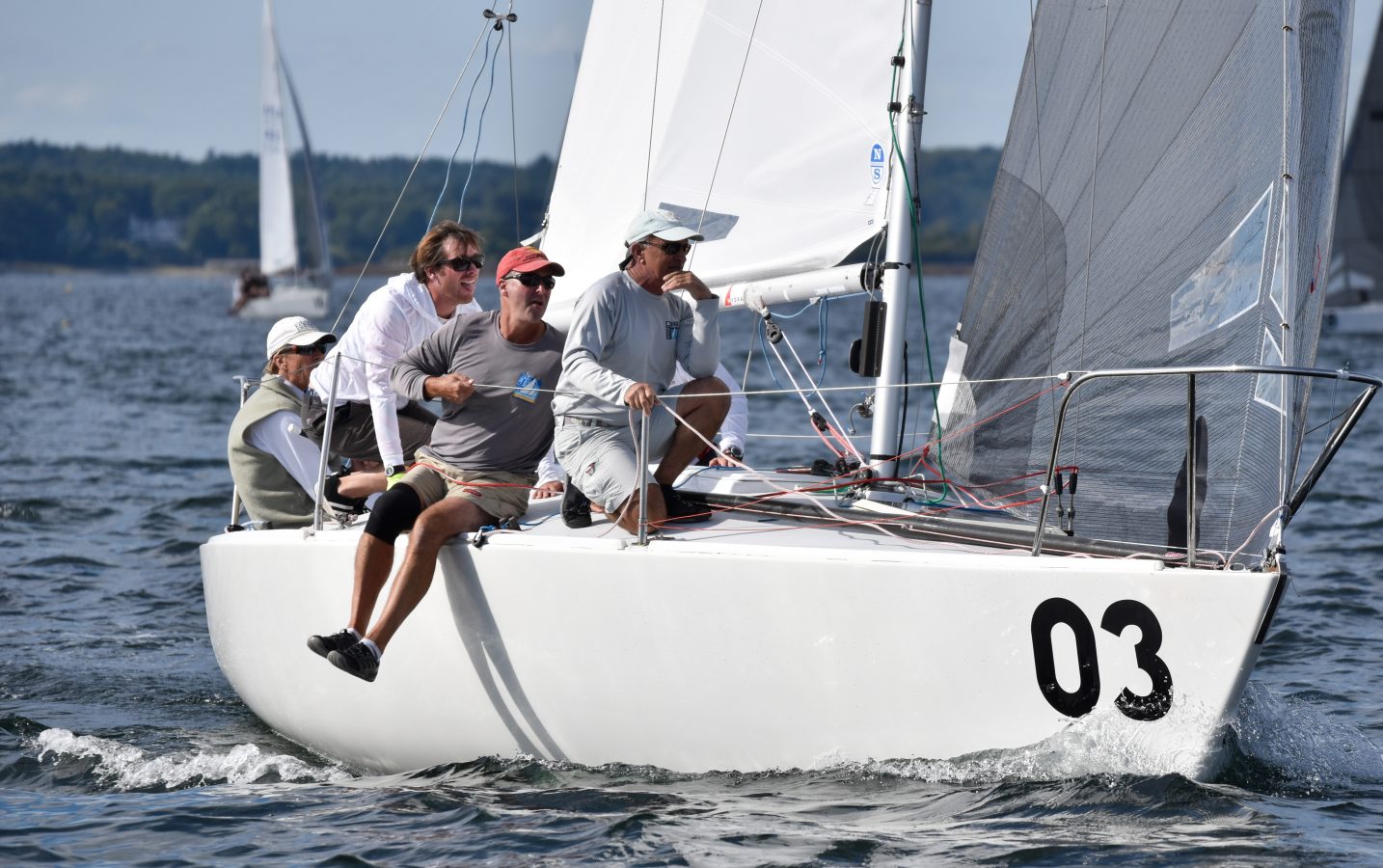
J/24 NATIONALS: MANAGING STRONG CURRENTS & LIGHT AIR
J/24 NATIONALS: MANAGING STRONG CURRENTS & LIGHT AIR
Class Veteran Robby Brown Shares His Top Secrets
© Chris Howell
The 2018 J/24 US Nationals were hosted by the Portland Yacht Club in Casco Bay. We caught up with Robby Brown, skipper of the winning team Angel of Harlem for some insights:
You have been sailing J/24s for years on and off, can you tell us a little about yourself, how you got into the class and what keeps you coming back?
I have been in the J/24 class since the Mid 80’s. I began sailing J/24s regularly around 1995. While I sail in multiple classes, I love the competitive nature of the J/24 class and its relative affordability of keeping a World Class boat going. Over the years, the class has always offered top level competition, that’s the biggest reason that keeps me coming back. Combined with the great atmosphere of the competitors and the class, I have always enjoyed my time spent campaigning the J/24.
Who crewed for you at the Nationals and how long have you all been racing together?
We have been working hard to put together a World Class team in advance of the Worlds in Miami. We are sailing together more regularly with team consistency than we have ever been able to manage in the past.
Our team consists of a group of sailors whose lives have been connected for many, many years as sailors that enjoy sailing together. The biggest factor gluing the team together at this point is my partner Mark Liebel. Mark and I are full partners in our pursuit of a top finish at the 2019 Worlds. We began sailing together nearly 15 years ago when I first moved to the Tampa Bay area. Over the years, we have developed a great friendship and ability to work together based on trust and truly enjoying working together in pursuit of team goals.
Ron Hyatt has been my most steady contributor with his rock solid bow work. He and I have been regularly sailing together for 15 years as well. Ron is a huge contributor in every aspect of campaigning the boat. He will help with deliveries and is always working hard on the dock to insure that we are prepared for a championship outcome.
Arthur Blodgett has developed into a huge asset in the trimming position and has been able to find the time to join us on a fairly regular basis ever since he graduated from college sailing as an award winning sailor. He was my best sailor when I was the collegiate coach at Eckerd College. We have been working together for almost 10 years.
Brian Simpkins was our fifth for the Nationals. He was new to the team but nevertheless a key to team success. Brian and Mark have been sailing together for many years, and I can’t say enough good things about the job he did stepping right in and making a huge contribution to our team success. We are definitely hoping he will join us some more in the future as a regular part of the team.
There is a fair amount of current where the Nationals were sailed this year, how did you figure it out so quickly?
Mark and I have sailed at the venue in the past and Arthur is from the area. We knew enough to have great respect for the need to figure out the current. We are all experienced at figuring out new venues. I am a high school sailing coach who regularly faces new venues with my teams. Mark is active in many classes and is diligent in his contributions to insure we have a good plan for the venue we are sailing in. In the end, I feel we did more homework on a daily basis than the competition, being able to process this information to insure success.
Here’s what we did:
We were determined to be the first boat off the dock, sailing the course area and examining trends and identifying course-specific opportunities to make gains.
We were checking current all of the way to the course area first thing in the morning. All of the lobster traps were great current tell tails.
We sailed both sides of the first beat in the morning to find the strong current. We examine where the water was rougher as an indicator of strong current.
We played the ever changing current more than wind shifts.
We made start strategies to get to the good current first and it paid.
What was your starting game plan against 50 other boats?
Hope and pray! This was true to some degree.
On the first two races we got caught up in crowds and were flushed at the start. Lesson learned, for the rest of the regatta we started toward the end that we liked, with a priority of staying away from the crowded areas. We would start just to one side or the other of the crowded area and still be as close as possible to where we wanted to be. With some good fortune, we had some great luck with starts in the last three races and were able to dig ourselves out and salvage the best possible finishes. Being able to escape the pack, and get out to the lead, we converted our good starts to 2-1-2 finishes, closing our gap to snag the victory.
We are constantly applying great focus to insuring we get good starts. The dynamics seem to be ever changing from event to event as far as getting off the line well. We feel that starts are the biggest benefactor of our ability to sail well at the Midwinters, North Americans, and finally the Nationals. Our big fleet start experience is definitely paying off.
You seem to have a pretty good light air gear, how did you set up your boat?
We definitely thought about this a great deal. We have been honing our speed for years and feel we have a particularly good gear in the light air. While we enjoy good boat speed in all conditions, the things we feel we do better than most in light air are a result of years of tuning, working with our North Team representatives, and living in an area where we get a lot of practice in light air. I noticed we did a couple of things differently than the most:
Primarily, we keep our mast butt well aft in the light air conditions.
This gives us the forestay sag that we utilize to really keep the boat powered up in light air. We never go below 20/15 on the rig. Rather, we push the mast butt back to get a really full genoa shape. This requires lots of scallops in the luff, as well as putting on backstay a little at times to pull some of the sag if the breeze gets bigger puffs or just picks up a little. We feel we are better pulling a little backstay on than we are if the rig was softer than 20/15. We felt like the puffs were a little too much for our tune. This has proven very successful for us
Secondly, we are weight farther forward and down in the boat more than anyone else.
Going downwind our spinnaker trimmer is one or two steps up on the cabin house, our tactician is standing on the cabin sole all the way forward in the hatch. Additionally our bow person and mast person go below and the mast person shifts from port to starboard side to balance the boat right up against the bulkhead and the bow person is in front of the bulkhead. I truly feel this was our secret to really superior downwind speed. We also had our fifth below upwind when it was very light. If he’s not hiking on deck, he is below against the bulkhead,
What sail designs do you use and why?
All of the North products are superior. Our choice for more years than I can count are Newport Upwind (Fat Head Mainsail, DX-7TT Genoa) and San Diego downwind (FR-2 Spinnaker). Rather than switching around between designs, we feel we have been able to get tremendous performance from these sails by sticking with the designs and honing our tuning of these sails over these many years.
Others have had great success with the many good product offerings available from North. We have been tempted to try something different a few times over the years, but we are always rewarded by our “if it ain’t broke don’t fix it” mentality. This has allowed us to develop our tuning model to a better than most performance through consistency.
What’s next on your sailing schedule?
We have a couple of great regattas on our schedule to close out the year here in Florida. We are preparing for the Southeast Regionals and Districts which will surely bring the best competition to the starting line. From there, we are working toward our best performance at Midwinters at our home Yacht Club, Davis Island.
We are planning to sail the St Pete NOODs as a tune up for the Midwinters and are hoping to coordinate tuning opportunities in addition to sailing as many of the major championships next year as possible. We hope to find good regattas in addition to the Nationals in Rochester, maybe some more NOOD regattas or the Newport Regatta. Please reach out to us if you would like to tune at these events. We are always welcoming tuning partners and opportunities.
© Chris Howell
READ MORE
READ MORE
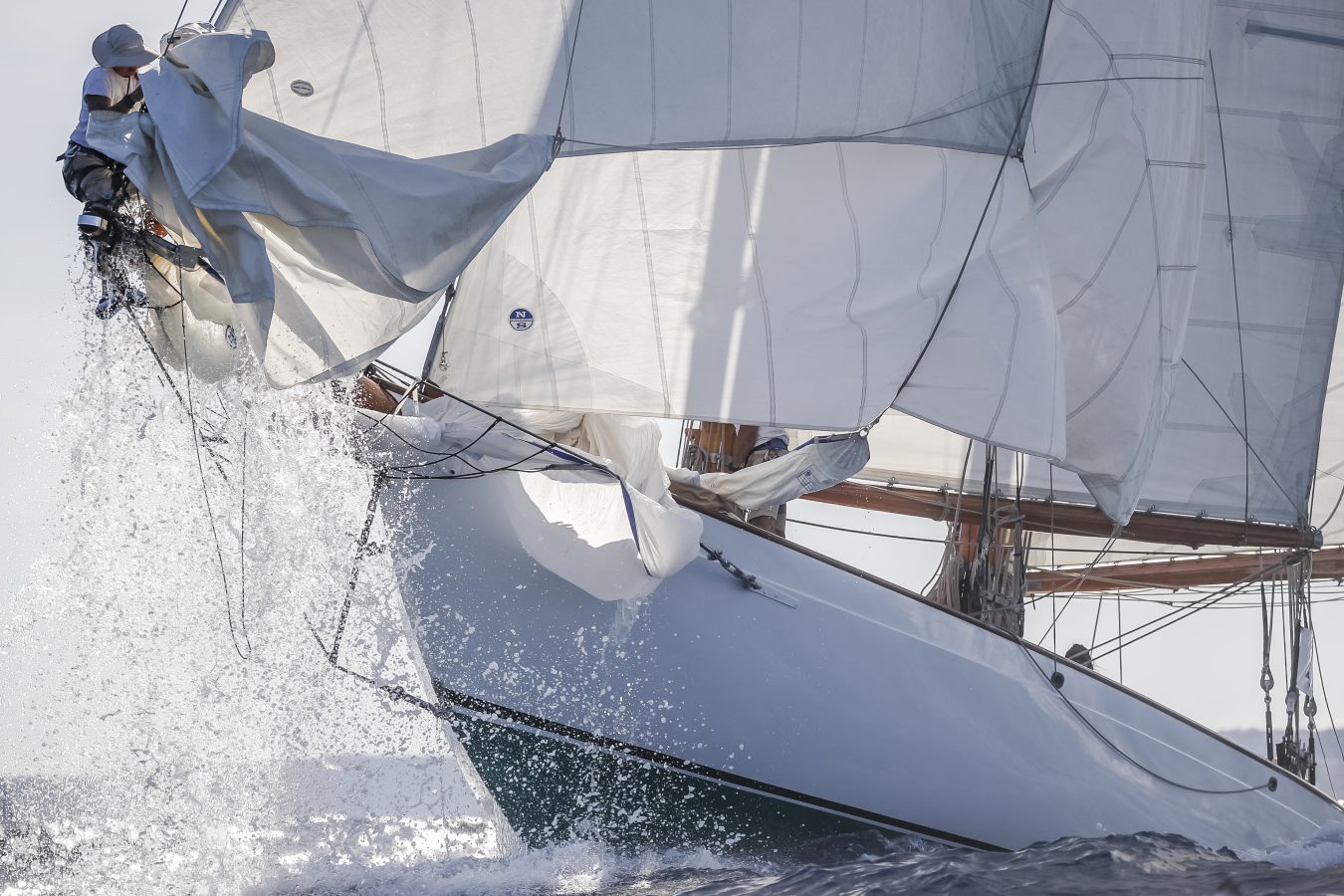
SCOREBOARD SUCCESS AT ST. TROPEZ
The 2018 Les Voiles de St. Tropez provided participants from with a beautiful week of racing to cap off another successful summer season in the Med. North Sails clients had an excellent showing, placing on the podium across 14 divisions, ranging from modern to classic racing yachts. Les Trophées were awarded to clients and their teams who out-performed within their division.
2018 Les Trophées :
Trophée BMW : Wally 77 Lyra – Terry Hui
Trophée Edmond de Rothschild (IRC C): Gladiator – Tony Langley
Trophée de la Ville de Saint-Tropez : Cannonball – Dario Ferrarri
Concours de boules : Lady Jo: Pierre Roinson
Trophée Loro Piana : Topaz – Peter Holmberg
Trophée Kappa : Flo D’ Orient – Bernard Coquelet
Trophée Marines de Cogolin : Alice – Simon Henning
Trophée Le Byblos : Kelpie – Olive Pelham
Trophée SNSM : Rowdy – Timothy Goodboy
Trophée Air France : Elena of London – Steven Mc Laren
Trophée Suzuki : Creme Anglaise – John Rainger
Congratulations to all of our clients for their excellent performance throughout the week.
📸 Carlo Borlenghi
📸 Carlo Borlenghi
📸 Carlo Borlenghi
📸 Carlo Borlenghi
📸 Carlo Borlenghi
📸 Carlo Borlenghi
📸 Carlo Borlenghi
📸 Carlo Borlenghi
READ MORE
READ MORE

J/70 WORLDS: WINNING THE CORINTHIAN FLEET
J/70 WORLDS: WINNING THE CORINTHIAN FLEET
Great Team, Fast Sails: The Formula for Team Marnatura
Team Marnatura, 2018 J/70 Corinthian World Champion. © Photoboat
We are very proud to share that all top five Corinthian teams at the 2018 West Marine J/70 World Championship were powered by North Sails. We had a chance to catch up with Luiz Bugallo from Spain, skipper of Marnatura who finished 6th place overall and won the World title for the Corinthian division.
Luis, congratulations on your excellent regatta at the J/70 Worlds, finishing 6th place overall and winning the Corinthian Division. What was the key to keep consistent finishes?
Thank you very much. The event was very challenging and fun for us. That said, for us the reason for our success lies entirely with our team. Each of us knows what to do in the boat in different situations so our teamwork and trust in each other builds our confidence. We all believe that an important factor is to keep the entire team motivated and to stay positive. Additionally, our game plan is very focused on distributing responsibilities on the boat so we are working at all times as a team., focusing on our jobs.
Tell us about your team.
We are lucky to have such a great group to sail with and I was fortunate to be able to be the helm with such a talented team.
From bow to stern:
Jorge Lorenzo (23, Spain) was our bowman. He sailed Optimists and had good results in the 420 class. He is studying to be a Naval Engineer.
Gerardo Prego (24, Spain) trimmed our spinnaker. Gerardo sails Snipes at a high level in the European Snipe Class. He is a very good bowman and is in high demand on larger keelboats as he pursues his degree in Business Administration.
Alberto Basadre (23, Spain) was our jib trimmer. A bit ironic since he sails mostly Lasers! He is continuing his studies in Mechanical Engineering.
Enrique Freire (46, Spain) was our most “experienced” teammate and took on the difficult role as our tactician. Enrique is the owner and CEO of Marnatura and the keystone of our success.
Luis Bugallo (23, Spain), skipper. I started sailing Optimist when I was 7 years old. I have sailed Optimist, 420, Platu 25 and the 49er. I am studying Engineering.
Choosing which sails to use is an important ingredient to a successful program. What were the main reasons Team Marnatura chose North Sails to power your Corinthian program?
Deciding on what sails to use is not something we take lightly. We work hard to improve every aspect of our racing so we were not in a position to consider just anything. We are only willing to use what will give us the best chance to perform. We have always believed that the North Sails technology is above all others as far as sail manufacturing.
We felt that the XCS-1 main, J-2 jib and AP-1 spinnaker best fit our team and they are designs we had confidence in training. Knowing that, in addition to our focus on shapes and design, the materials North Sails uses are the best materials on the market. Lastly, the North J/70 team has a deep pool of talent and they willingly sharing information with us to help us get better and faster.
Your Corinthian team not only dominated the Corinthian fleet but also your 6th place overall finish bested some of the most talented sailors in the class. What tips would you give to other Corinthian teams?
We believe that success on the race course involves a formula that includes commitment, focused goals, and fun. That said I think our tips would be:
First and foremost, sail with friends and try to build and generate good relationships. Sailing and racing with people you enjoy and have fun with makes the successes much sweeter and the disappointments less bitter.
In general, focus on a target and a goal and center your resources on it. Being target focused is important but can easily distract you from the “big picture”.
In the J/70, downwind, it’s key to choose the correct mode: VMG, WING-WING, or “on the step”. The distances gained or lost can be amazing by picking the right (or wrong) downwind mode so make it a goal to learn which is best in each condition and work as a team to be able to quickly transition into each of the modes.
Try to use the sails you will use for regattas when you train. This will give you more knowledge about your trim settings and boat tuning/setup.
2018 J/70 WORLD CHAMPIONSHIP
Corinthian Division – Powered by North Sails
1
Marnatura / Luis Bugallo
2
Lifted / Jim Cunningham *
3
Pura Joda / Aldo Centanaro
4
Juicy / Francisco Van Avermaete
5
Joint Custody / Jenn & Ray Wulff
© Mauro Melandri | Zerogradinord
READ MORE
READ MORE
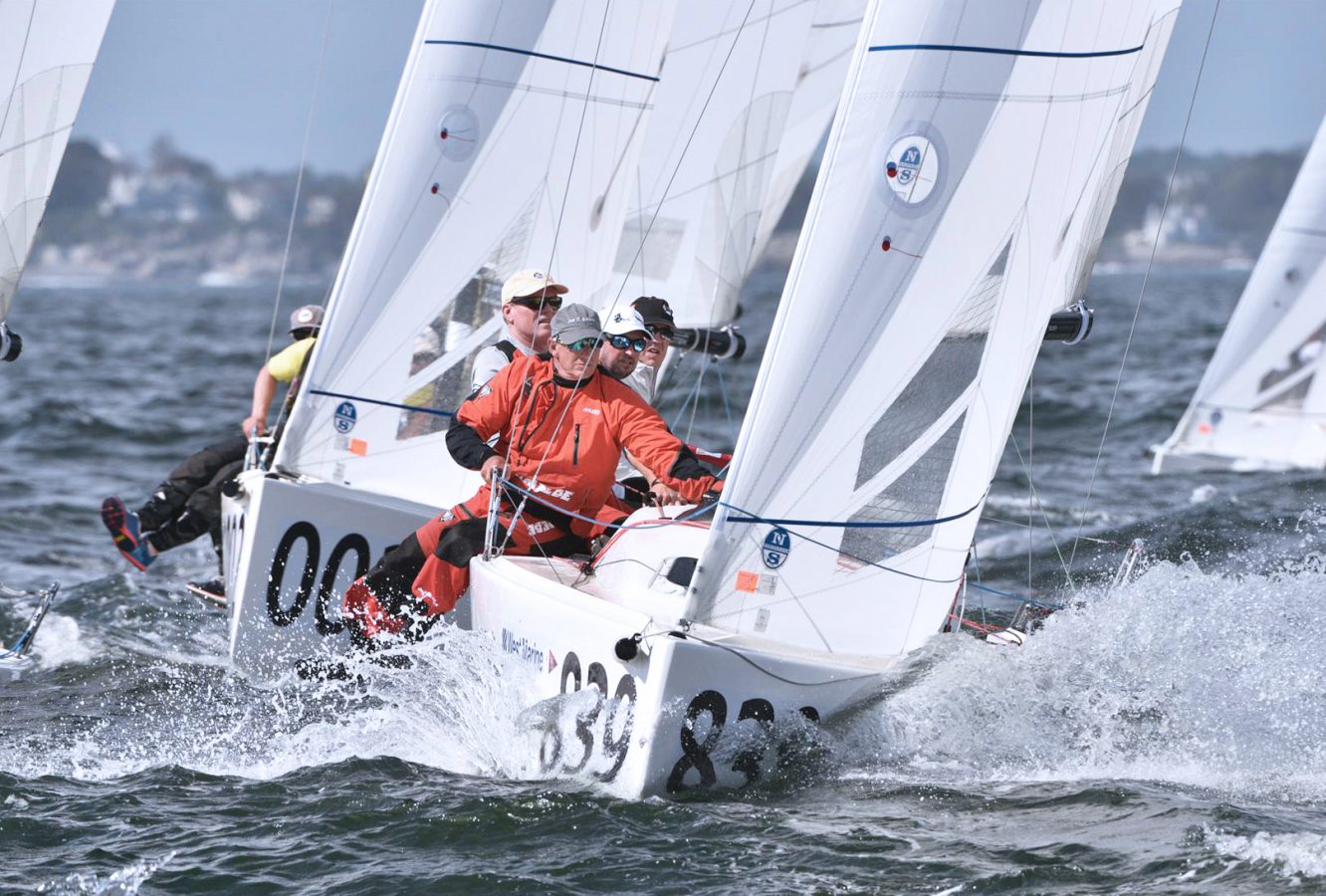
J/70 WORLDS: NORTH SAILS DEBRIEF
J/70 WORLDS: NORTH SAILS DEBRIEF
Considered One of the Toughest Regattas, Many Lessons Learned
© Chris Howell
The 2018 West Marine J/70 World Championship may have been one of the most competitive and best attended one design events yet. Eastern Yacht Club welcomed 91 teams from 18 different countries, and sailors had an exciting variety of conditions for the eleven races in four days. The allure of such an event was too much to pass up, and more than a dozen North Sails experts were on the starting line. Whether crewing for clients and friends or organizing their own team, the depth and expertise of our J/70 experts was on full display with many on the podium and even more in the top 10.
North results:
Corinthian Division: 1,2,3,4,5 – Congratulations Luis Bugallo and team Marnatura
Open Division: 2,3,5,6,8,9,10 – Seven out of the top 10 powered by North (See team/sail chart)
We asked our sailors to share both their impressions and lessons from the J/70 Worlds.
Max Skelley, Stampede – 2nd Place
Managing that many boats and keeping top finishes throughout the event is an impressive feat. What were the key things that you attribute the consistency Stampede was able to deliver?
MAX – We knew going into the event that we had really good upwind speed. Having Tim Healy as our tuning partner throughout the summer was a big help with narrowing down rig tune/sail trim settings. Being able to use our speed to dig our way out of tough spots began to dictate our tactics . We always tried to start in low density areas somewhere near the middle of the favored half of the line, not being so leveraged to one side that we couldn’t dig our way out if the shift didn’t go our way.
On race five we were persuaded to start at the windward end because the two previous races, hard right was really paying. We were able to win the start at the windward end and were first boat to tack to port which was the race winning move in the two previous races. Unfortunately, the left came in hard on the first beat and we rounded in the 50’s. We were able to fight back to the low thirties but the race still ended up being our drop race. We learned a lesson about risk / reward and stayed away from the ends for the remaining of the event using patience and speed to consistently get to the front of the fleet.
Team Stampede, 2nd place at the 2018 J/70 World Championship. © Photoboat
Eric Doyle, Stampede – 2nd Place
You are a boat speed guy. What were the keys to helping keep the boat going fast?
ERIC – We had worked hard all summer on our rig settings, we had confidence of when to change the rig tension for the wind strength. I was trimming the jib and one interesting trim technique that we started during the world’s was that we rarely moved the jib lead. It lived in the #6 hole 95% of the time and we just used the halyard to adjust and jib sheet tension to fine tune the jib.
In the heavy air races, when a lot more halyard was required, we had to ease the sheet about an inch and use the appropriate amount of in-hauler, less in the big puffs and more in the flatter, lighter spots. When it was lighter and we eased the halyard to make the jib fuller overall, it lowered the clew, effectively moving the lead aft, so we trimmed about an inch harder on the sheet and used more in-hauler. It seemed to work better as it is impossible to change the lead without tacking, but the halyard and sheet are readily accessible at all times.
How important was it to make sure your tuning was spot on and was there ever a time where the the conditions didn’t match your setup and, if so, what effect did that have?
ERIC – We always looked to set the boat up to be fast for the first half of the first beat so that we could hold a lane and get to the first weather mark in good shape. Most of the time it worked out but on the 4th day with all the rain squalls coming through and huge changes in velocity, after the first race we just went with a slightly tighter rig from base, +4 and +3, and used the backstay, traveler and boom vang much more aggressively. When the boat felt bad for Bruno, we made sure to remind him that we were out of tune and that he just had to deal with it! In the big fleet with lots of chop in general it was better to get caught a little on the loose side than too tight.
Team 3Ball JT, 3rd Place at the J/70 Worlds using the North J-6 Jib. © Chris Howell
Allan Terhune, 3 Ball JT – 3rd Place
After four days of racing and 11 races the top three teams all had over 100 points and were within three points of each other. Your team had some big scores early in the event. What turned the week around for your team to get back to the top of the leaderboard?
ALLAN – For sure the regatta didn’t start as we hoped. The big thing for us was not to panic and to take a look at everything to see where we could improve. We talked to our training partners and other folks and realized we had to be more drastic in our rig adjustments for the waves and wind. It was a hard event. It was not easy to get finishes in the 20’s.
The regatta was a good lesson in the fighting until the end and that the event is never over, till it’s over. If you would have told me that we would start with 18,22,25 and go into the last day three points out of the lead, I would have said you are nuts. It proved that World Championships are marathons and you have to keep pushing. Our team did that well. We always kept adapting and trying new things.
We were one of the few teams to use the North J-6 jib, and I think it was the right choice for us for sure. We found it gave us more range for the conditions there. It was a sail we were very comfortable with and we were glad we chose in the end.
Team Any Colour featuring the new North J-2 High Clew jib. © Chris Howell
Zeke Horowitz, Any Colour
Crewing for your friends, the Furnary Brothers, what setup did you find worked best to help them get in the groove to be consistently fast?
We used the XCS-2 Mainsail and we busted out a J-2 High Clew for the first time at this regatta. We were extremely happy to find the transition to the J-2 High Clew to be quite easy. It’s a beautiful, forgiving sail with all the modes you need. We stuck pretty close to the North Tuning Guide and found the setup to have the power we needed to fight through the big waves and chop while being easy enough to de-power and keep the groove nice and wide for Scott on the helm.
In the higher winds, we made sure to fine-tune our lowers so that there was no mast sag at the spreaders and if anything, a hint of poke to weather. This helped us achieve maximum head stay tension even when the main sheet had to be eased. Keeping the boat flat (both upwind and downwind) was HUGE.
The J/70 Worlds was a challenging regatta. What did your team do so well to get a top 10 finish and what needs work for next time so you don’t “leave any points on the water”?
ZEKE – For sure this has to be the most challenging regatta I’ve ever competed in. The depth of talent was insane and the sheer number of boats made it all the more difficult. Not to mention some pretty wild conditions! I think every single team felt that they left a myriad of points on the table – I know we did.
One thing we talked about as team before the regatta is that we wanted to play every decision in the race as if we were trying to just be top 20. We knew that if we averaged somewhere in the top 20, we’d be very happy with the result. So all our big picture game plans, tactical decisions, and boat handling maneuvers were made with conservative strategies, (except for the time we crashed into Tim Healy at the weather mark-Sorry, Boss). Scott and Evan Aras (main trimmer) did a fantastic job with starting and we knew that if we could be punched off the line, that would most likely get rid of about 50 boats that had bad starts.
From there it was really just about lane management and looking for opportunities to put the boat in places where we could make gains.
One thing that would really help us next time is continuing to improve on downwind modes. There are so many different modes to consider off the breeze and it’s amazing how much can be gained and lost by doing it correctly.
Team Enfant Terrible and the perfect shape of the new North J-2 High Clew jib. © Zerogradinord
Tim Healy, New England Ropes
What did you learn about North’s standard J70 designs this week that J70 sailors should know when thinking about investing in new sails?
TIM – We used the XCS-2 mainsail, J-2 High Clew jib and the AP-1 spinnaker. I chose them because I believe they are the fastest and most user friendly sails available. They allow for the power and speed to acceleration of the line in choppy conditions and to power up quickly out of tacks. The J-2 High Clew is slightly fuller than the J-6 and is less weather sheet dependant which, I feel, makes getting “top speed” trim correct more quickly and easily. It was used on many of the top ten boats. The J-6 is also an excellent sail finishing 1 point out of 1st in second and 3 points out of first in 3rd! The J-6 can create the same power as the J-2 High Clew with slightly more weather sheet.
My recommendation to someone ready for a new set is to go with the J-2 High Clew for a more user friendly sail and the J-6 if you like to be more active with weather sheeting.
G-Spottino powered by North’s AP-1 Spinnaker. © Zerogradinord
2018 WEST MARINE J/70 WORLD CHAMPIONSHIP
Sails used by the top teams powered by North:
2
Stampede – Bruno Pasquinelli / XCS-1 Mainsail, J-6 Jib, AP-1 Spinnaker
3
3 Ball JT – Jack Franco / XCS-2 Mainsail, J-6 Jib, AP-1 Spinnaker
5
Savasana – Brian Keane / XCS-1 Mainsail, J-2 High Clew Jib, AP-1 Spinnaker
6
Marnatura – Luis Bugallo / XCS-1 Mainsail, J-2 Jib, AP-1 Spinnaker
8
Enfant Terrible – Alberto Rossi / XCS-1 Mainsail, J-2 High Clew Jib, AP-1 Spinnaker
9
New England Ropes – Tim Healy / XCS-2 Mainsail, J-2 High Clew Jib, AP-1 Spinnaker
10
Any Colour – Scott & Alex Furnary/ XCS-2 Mainsail, J-2 High Clew Jib, AP-1 Spinnaker
READ MORE
READ MORE

STAR WORLD CHAMPIONS: SIX DECADES WITH NORTH SAILS
SIX DECADES OF STAR WORLD CHAMPIONS
Success In The Class Began With Founder Lowell North
North Sails was started by a five-time Star World champion, and the event continues to be an important part of our history. Our founder Lowell North’s very first gold star was awarded in 1945, when he crewed for Malin Burnham.
“It wasn’t me Malin wanted,” Lowell explained, years later. “It was my mainsail.”
Lowell started the company in 1957 , the same year he won his first Star World Championship as skipper in Havana, Cuba, sailing with James Hill. “I learned to win in the Star by taking a sail apart and putting it back together until it was a little faster,” Lowell claims. “Sails then were so poorly designed that practically anything you did made them better. As we won more races, I convinced myself I knew what a fast sail should look like.” The Star Class regatta report from Havana says that “North and Hill had their boat moving very fast. Often they found themselves in the wrong place, back in the ruck, whereupon they worked out of it by sailing faster and with better headwork than their competitors.”
Regatta reports from Lowell’s subsequent Worlds wins (1959, 1960, 1973), as well as the gold and bronze Olympic medals he won in 1964 and 1968, reveal similar themes: he was fast enough to get out of trouble, smart enough to stay in front once he got there, and respected by his competitors for fixing anything that broke. Off Newport Beach in 1959, second place finisher Gary Comer reported, “Three-quarters of the way down , Lowell came by so fast I didn’t even bother to luff him.” In 1960, Lowell won again after “rearranging his rigging” by replacing his broken headstay with a backstay.
“Lowell North continued to demonstrate his supremacy over the Class,” announced the regatta report afterward.
Lowell was also respected as a good sport, admitting to his mistakes. In 1967, finishing second by three points to Paul Elvstrøm for the second year in a row, a reporter asked what happened. According to the Star Logs report, “Lowell refrained from kicking him off the end of the pier and only answered quietly, “We got a bad start and sailed a bad race.”
READ MORE
READ MORE
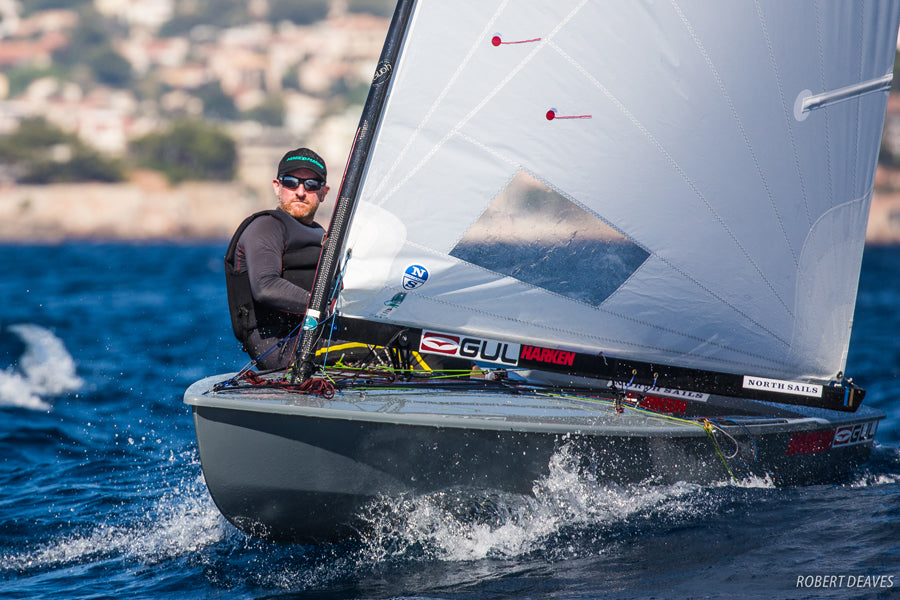
NORTH SAILS DESIGN PREVAILS AT OK DINGHY EUROPEANS
NORTH SAILS DESIGNS PREVAIL
New Designs Excel at the OK Dinghy European Championship
Heavy winds started the week off, as the Mistral blew through Bandol, leaving a mixed sea state, creating very physical sailing conditions for the OK dinghy fleet. As the week went on the conditions eased off, testing the sailors each day to eventually separate the leader from the fleet.
North Sails One Design expert Charlie Cumbley fought hard until the very end. Leading the fleet coming into the final day, points were extremely tight between the top three players on the field. Charlie scored a 2-15 on the final day, putting him in second place behind Fredrik Loof. In third place, trailing by just one point, was Swedish sailor, Thomas Hanson-Mile. Between Thomas and Charlie, they won six out of the eight races sailed.
Finishing thirteenth overall and becoming the new Junior European Champion was Will Heritage. All three of the sailors mentioned above were using the new development sail in the North Sails inventory. This model is a flatter version of the KAP-1, its performance has proved to be fast and versatile so far and will compliment the KAP-1 as part of the North Sails inventory.
“Based on the world winning KAP-1 it was designed specifically for sailors 90 kg and under. Providing plenty of power, but making it more forgiving in the stronger breeze. In Bandol we had a variety of conditions, it was still powerful in the lighter conditions but was much easier to de-power on the windy first day.”
–Charlie Cumbley, One Design Sales expert
Full results
READ MORE
READ MORE
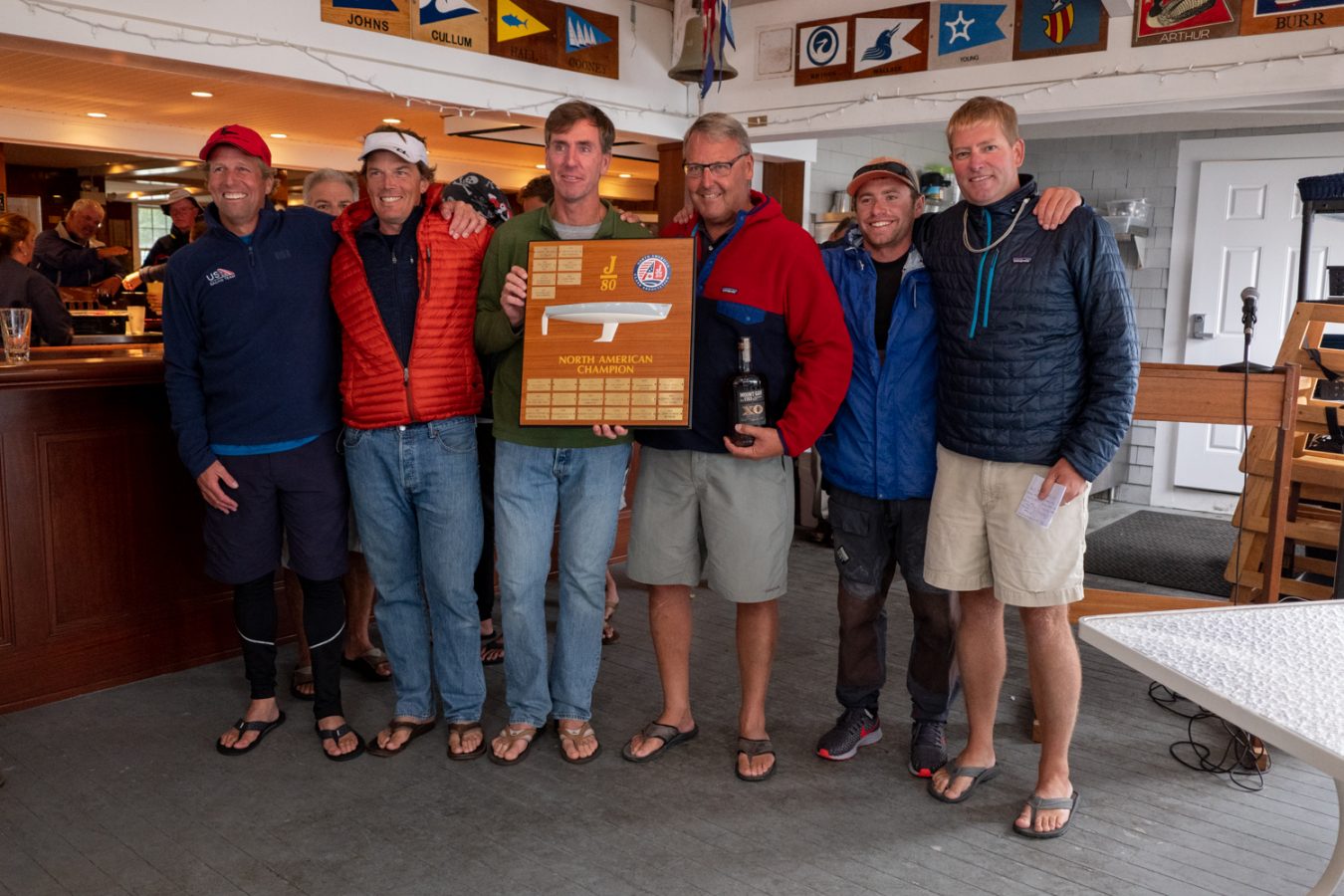
INTERVIEW: J/80 NORTH AMERICANS
J/80 NORTH AMERICAN CHAMPIONSHIP
Interview with Chip Johns
Team Cavitics – Chip Johns, Zander Gryska, Bill Marvel and Cam Tougas. Photo Anne Converse
We caught up with Chip Johns, winner of the 2018 J/80 North American Championship sailed in Marion, MA. Team Cavitica won the event with only 11-points in the 4-race series.
Congrats on your win! What was the key to Team Cavitica’s success?
Thanks. Doing well in this event was THE racing goal for me and our team for this year. Unfortunately, we had a setback in the pre-season when I dislocated my shoulder. This injury kept me out of the J80 until July and we did not have any August racing planned, so our time in the boat before the event was a bit limited. I think that our many years of experience in the boat allowed us to adjust as the event went on and get faster and better each day. We were fortunate to come out of the blocks on the 1st day with 2 wins in the first two races. We did not think we were fast on the 1st day, but we did feel that we were able to pick the shifts better than others. Given our speed deficit, we made sure we started safely and had the ability to tack when we wanted to. This allowed us to land at the top mark in the top few almost every race.
We made some tuning adjustments in Day 2 and found our upwind speed. This allowed us to be a bit more aggressive in starting and since we were still picking the shifts well, we were always in the top few boats at the top mark. Day 3 brought on more breeze and we had a comfortable lead. So we started very conservatively, but were still able to sail through the fleet and finish in the top few boats in each race.
I think our key to this event was the ability to pick the shifts on the upwind legs and over the course of the event get faster and faster through better tuning.
Tell us about your team? Have you sailed together for a long time?
Our team has been sailing the J80 for 10 years. Three of us own the boat together – me, Bill Marvel, and Zander Gryska and we really enjoy sailing together. We have also sailed other boats and done a few Bermuda races together, so we know each other pretty well. Billy is a great trimmer (and helm) and we are in constant communication about pointing, speed, waves, and puffs all the way around the course. Zander is the best fwd guy out there. He is athletic, has a great sense on the water, and has a 7’ reach so spin hoists and jibes are always great. He also takes care of problems when they happen because his sense of what might happen on the boat is so great. We always are searching for the right fourth person. Cam Tougas grew up in Marion doing a lot of sailing and was a great tactician to have aboard. Cam and Zander did a great job calling puffs and waves which for this event was critical.
Buzzards Bay is known for good wind, what were the conditions like throughout the regatta?
Well, as they say, “it never blows like that here” and this event was no different. Buzzards Bay is known for a thermal driven southwest breeze with big, steep waves. We had a shifty northeast breeze blowing about 13 to 20 knots during the entire event. While we didn’t get to showcase our “typical” breeze, we had great wind and the shifty conditions allowed for boats to come back if they had a rough start.
I have sailed and raced out of Marion for over 50 years. It is great to be able to host an event like this and have different wind that “normal” so there is less local advantage.
Did you do anything special on rig tune, mast butt position or did you use the numbers straight from our tuning guide?
We would start off with what the tuning sheet defined and then make small adjustments after setting up on the course before every race. We have never moved our mast butt in 10 years, but can understand how it might be important. I mentioned that we were a bit off the pace on day one. This was due to our lowers being too loose. Once we got these snugged up a bit, we had our speed.
READ MORE
READ MORE
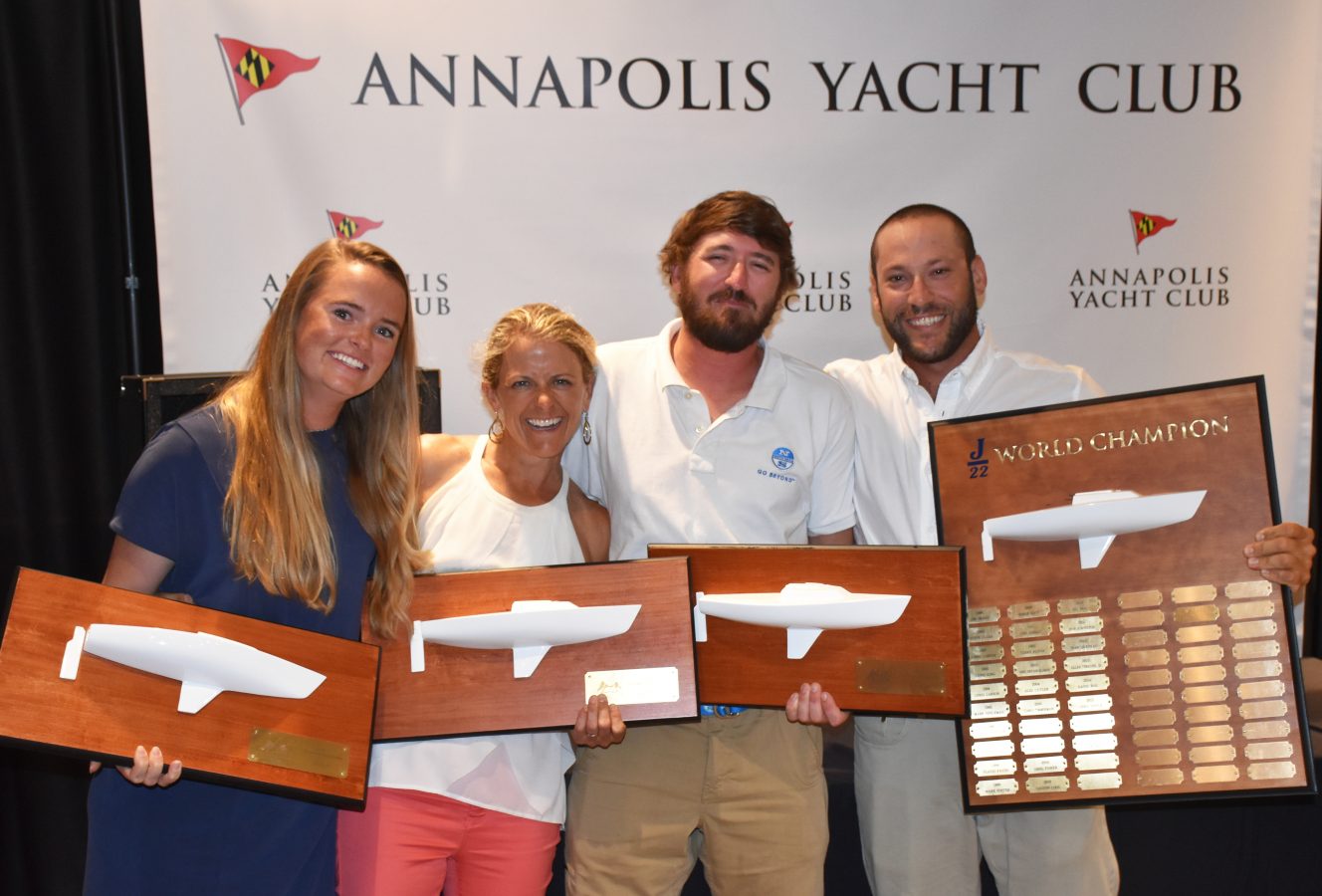
J/22 WORLDS: INTERVIEW TEAM UNCLE FLUFFY
UNCLE FLUFFY’S SECRETS TO WIN THE J/22 WORLDS
Interview Reveals Details on Boat Settings, Tactics and Crew Work
Congratulations Zeke, Emmy, JoAnn and Jackson on your, hard fought, victory at the 2018 J/22 Worlds in Annapolis. Can you tell us a bit about the team and how it all came together and worked so well?
Zeke – Our team first sailed together at the 2016 J/22 Worlds in Kingston which was our first event as a team and my first time ever skippering a J/22. I had sailed a lot with each other person on the boat separately but never together. It was clear from day one of that regatta that we had something special. With the Worlds coming to my home waters here in Annapolis, it was obvious who I wanted to have on board with me. Jackson has made a name for himself across our sport as a Real-Deal-Tactician-and-Trimmer and I feel lucky to have such a good friend be so talented and willing to sail with me! Jo Ann already had a World Championship under her belt and she brings all of the technical perfection to her bow work as well as tuning (she tunes the rig!). She’s a spark of positivity and fun and I can’t imagine having anyone else on the bow. Emmy Stuart is an All American Crew from the College of Charleston who has really come into her own on the keel boat scene. Her knowledge of wind shifts and current really gave us an edge in the tricky conditions we had. On top of that, she kept us all organized with the off the water logistics that took a ton of pressure off of the rest of us. The only thing more special than winning a world championship is doing it with friends you love!
Jackson – My role on the boat was to handle the jib trim, spinnaker trim, and tactics pre-start, upwind, and if we were going to have a straight set at the windward mark or look for an opportunity to gybe quickly. I would try to discuss my thought process as best as I could so that everyone was on the same page. Emmy would take over the tactics downwind as I was trimming the kite, and she also did a great job painting the picture of what was going on behind us on the downwind legs, which would keep me keyed into the race for when we turned back upwind. Sometimes I would take a quick snapshot of what was happening behind me while trimming the kite (maybe once or twice a leg if the opportunity presented itself, although I’m sure Zeke isn’t thrilled to hear that!). Due to Emmy’s tactics downwind, I don’t think we ever had a negative delta on any downwind leg the entire regatta. In fact, I’m pretty sure we actually passed boats about 75% of the time on the downwind legs.
Jo Ann – I had 2 main roles on the boat:
1. Tuning the rig. Zeke, Jackson, and Emmy gave me full control over setting up the rig which freaked me out. I would ask for their opinion on it and they would always respond “just do what you think is right!”
2. The bow. Just making sure all sets and douses were flawless as well as ensuring weight placement was correct. Then assisting Emmy with an information regarding boats, speed, wind etc that Zeke and Jackson needed.
Emmy – My role on the boat was pit. I was responsible for time on the line, trimming jib during pre-start, calling pressure, waves, current, lanes, keeping eyes on the marks, prepping kite for set/dousing the kite, cleaning up lines as needed, and moving my weight around quite a bit. With four people on the boat, I was sharing quite a few jobs with Jo Ann which forced me to constantly think about what I could be doing to add value in the moment.
The week started off with an announcement that they were shortening the event by a day due to the possible effects from Hurricane Florence. How did that affect your strategy for the week knowing that the first few days they would be looking to get as many races “front loaded” as possible?
Zeke –When we heard they were going to front-load as much racing as they could, it didn’t really alter our approach all that much. We just knew the first couple days might be long so we brought some extra rations so we could stay healthy out there. But our hard focus for the first couple of says was still the same – DON’T LOSE THE REGATTA. You can’t win the regatta in the first day or two, but you can certainly lose it. We just tried to avoid big mistakes and give ourselves a shot at the end of the regatta.
Jackson – I personally didn’t look into that too much. We knew we had to have good races from the very beginning, but that’s always the case if you’re looking to win an event. I suppose the only thing that the schedule change affected was that we knew we had to prepare for slightly longer days. I think it was fairly close to dusk as we hit the dock after the first day of racing.
Jo Ann – I think everyone on the boat is super focused and the longer days didn’t phase anyone. We made sure we all ate and drank after every race.
Emmy – I was initially bummed to hear that Friday was cancelled. However, it was really positive being with a team that was excited to get in as many quality races as we could while we had good weather. From my perspective, we were all psyched to be racing this event together that it was more so mentally preparing for some of the challenges ahead (sailing in some of the tricky shifty conditions, lighter conditions and even the fog) and staying positive.
In looking at the results the fleet was packed with talent with many past World and NA champions. Obviously teamwork was critical but you had to be confident in your boat speed in a large fleet like that. What were the keys to being “World Champion Fast”, what were the condition for the week and how did you “change gears” as the conditions changed?
Zeke – As always, speed is king. Jackson and I worked hard to get the mast tuned as straight as possible before the regatta and from there I knew Jo Ann could take care of all the tuning. As the helmsman, it was my responsibility to keep us moving fast. I focused a lot on the balance of the helm and tried really hard to keep the keel engaged – I think that is the real trick in the J/22.
It was mostly light air, so Jackson and I worked hard on keeping the boat fast but erroring on slightly eased/open sails and when I felt we had an opportunity to “squish” the boat flat with the sails trimmed a bit harder, I could really feel the keel engage and the boat would just take off. The North M7 main has been an amazing sail for us with that design having won 4 of the past 5 World Championships. We have worked a lot on development on new molds and designs over the years and, at this point, we just keep coming back to the fact that the M7 is the best all around shape. When the breeze came up a bit, my focus was on finding the perfect amount of backstay so that we could pull the head stay a bit straighter and open up the main leech to help keep the boat flat while still at max power. There was a lot of communication throughout the entire regatta about crew placement, sail trim, and mode so we could be sure we were on the same page shooting for the same goal. Major KUDOS to Emmy and Jo Ann who had to tough it out down below in a number of the light air races. Having weight low and decreased windage is key for light air speed upwind. But we wouldn’t have been able to be fast if we weren’t in the best breeze! Jackson, Emmy, and Jo Ann did a phenomenal job with boat placement so we always had a chance to rely on our speed!
Jackson – Oh man, this is a good question. Our boat preparation started months and months before the Worlds even started. Zeke did an amazing job making sure we had the bottom of the boat well taken care of, and then we made it as perfect as possible throughout those months leading up to the Worlds, always thinking about how we might enhance even the smallest things. Starting to prepare the hull, rigging, and rig tune well before the event allows you to go into the first day of racing completely focused on the task at hand (sailing well in the conditions of the day), which is a major advantage. It takes a really long time and a lot of effort to get the boat in tip-top shape. We went over every little piece on the boat with a fine-tooth comb to make sure everything was working just the way we wanted it to, and it wasn’t going to break on us.
Setting the base rig tune on Uncle Fluffy is a little strange. We found that for some reason the mast was very hard to set straight, and keep straight, through the settings. I really focused on that for a few days during the Annapolis NOOD back in May, then recorded caliper measurements at the turnbuckles to easily replicate those base settings. Once I dialed the rig into the best base setting I could, we pretty much turned the rig tune on the water over to JoAnn. She has an amazing wealth of knowledge and experience in that department and I think the team actually trusted her more than she trusted herself! But we knew we were in the best hands possible with Jo handling the changes on the water. She has a keen eye for mast bend and a lot of our speed came from her expertise! Our normal game plan for rig tune was to set it for the given wind and wave conditions before each race, but then we’d revisit it right before the warning signal and make sure that it was tweaked just ever so slightly towards how we thought the conditions might change for the start and the first leg of the race.
Zeke mentioned the M7 main and knowing that we had proven winning sail designs that are also very easy to use in all conditions allowed us to keep our thoughts towards actually racing the boat and cracking the code of the current and wind each day. My focus on trimming was on the jib and spinnaker and, like the M7, having the BigFoot AP jib and FR-1 spinnaker in our quiver was a real confidence boost since we knew that, using that combination, guaranteed us World Championship speed. When the dust settled the top 4 teams as well as 5 of the top 6 used the same sail combination that we did so we certainly had to stay on top of all facets of our game since we weren’t the only team that figured that puzzle out! I think the overall results speak clearly for themselves as to which sails are used by the fastest boats.
Jo Ann – On the lighter days Emmy and I spent a lot of time in the dog house! It was difficult to exactly tell what was going on, but we were constantly moving positions down below to keep weight in the correct place.
Downwind, I think it was important to stay in the breeze and know where the next shift was coming from and where the leeward marks are located. As soon as we set, we’d immediately look for the leeward marks.
Emmy – I’ve been lucky enough to learn so much from this team over the past couple of years. Jo Ann and I would talk through relatives compared to the boats around us, especially as the boys were talking about changing gears. We were constantly talking about wind on the course and counting down the immediate pressure. Weight balance feels pretty natural but we would talk through making minor adjustments like shifting weight in, or Jackson coming off the rail, to a change as drastic as me (and Jo Ann) hopping down below/up on deck.
Consistency won the day at this event and, while you did win one race, more importantly you counted all single digit finishes in your scorecard. What was the focus of your game plan going into the event and how did you alter it as the week progressed?
Zeke – I’ve done a fair amount of sailing (and talking about sailing) with Jackson and I know he is all about those top 5 finishes. He rarely makes a super risky call to try to win a race, but rather he sets the boat up to be in the top 10% at the first mark and then he snipes off packs or boats for the rest of the race. He’s always trying to avoid big mistakes. We would try to start conservatively near the favored end and then play the fleet up our side of the course. We paid very close attention to the breeze and course angles in the pre-start (3-5 wind checks before each race) so we could set up to be on the favored end of the line. We never really altered our approach until the very last race of the regatta.
Jackson – A main contributing factor from our consistency came from Zeke’s excellent starting abilities. I’d develop the game plan, and then the area of the line that I wanted to start, and then he’d execute perfectly from there. Starting in low density areas of the starting line is a low-risk/ high-reward game plan, so we’d generally start near where we thought was the favored end of the line, but safely away from the pack. If for some reason the extreme end of the line was not crowded, then we’d jump at the opportunity. Making sure to pay attention to the location of the pack from about 2:30 before the start really helps to make sure you don’t mistakenly get caught up in it.
With the highly variable and unpredictable wind that we had at this regatta, it was pretty stressful at times trying to keep track of all the top boats in each race. Playing the odds in relation to where the largest number of boats in the top group were heading generally provides for a solid score line. However it doesn’t necessarily keep the second pack that escapes to a corner behind you every time. Making sure to keep your cool in that kind of situation was hard, but imperative. Things were constantly and sometimes invisibly changing on the racecourse, so I tried my best to play the cards we had at each point in time and that seemed to work out pretty well.
Emmy – Jackson had an innate view of the course, current, line and fleet and was very audible about the game plan for each race from the get-go, thus putting us in all the right spots. He was mostly conservative, which helped us manage the fleet, and was positive and patient when a shift didn’t go our way. Zeke always had the boat hooked up and going so fast (it also helps that he is incredible at starting) And on the course Jackson and Zeke were almost constantly talking through changing gears and minor adjustments to really put the boat through the water.
Jo Ann and Emmy ran the front end of the boat all week. Sailing with 4 how did you divide up responsibilities and how did having the extra person help?
Jo Ann – I’ve only sailed the J/22 with 4 (or 5 in the Womens’ Rolex days). The extra set of hands and eyes is key. One of us could be looking for upwind boats, logs (so much debris in the water), leeward marks etc. while the other one looked from breeze. Also weight placement downwind with four people really helps to balance the boat as we can fine tune the weight placement. Emmy and I work great together and would report different info such as puffs, relatives, compass headings etc. The whole team worked well together and really respected one another which made it easy to sail well.
Emmy – With 4 people on the boat, Jo and I would share some responsibilities – we would both talk about pressure on the course, count down immediate puffs/waves/chop and help to be “opposite” eyes for Jackson and Zeke. Downwind we would talk about big picture pressure on the course, lanes, immediate pressure, relatives for the boats around us, finding the marks and helping determine game plan for the next beat. (Jo Ann is a boss on the bow.)
The final day seemed to be quite a test for the team to stay focused on the task at hand. What would you consider your “mental tool” when you are under pressure going into the final race at a major event where you know you can win it or lose it all?
Zeke – For me, it’s faith in my teammates. When things weren’t going well and I would get frustrated, (….after an initial outburst….) I would say to myself, “What’s your job?” I had complete faith that everyone else on the team was focused on their job and I knew that if I did mine well we would come out of tight spots.
Jackson – It’s incredibly important to stay calm, cool, and collected in that kind of situation, not only before the race but throughout as well. Making sure you eat something and continue to hydrate properly can be easy to forget, and I find staying on top of that helps to keep my brain firing on all cylinders and settles my nerves a little bit. I really tried to focus on the process and stick with the normal pre-race routine that I would go through before every race. It was also helpful to try and predict what the game plan would be for our closest competitor so that we could minimize surprises, and then develop a fluid plan for how we might deal in certain situations. Knowing the point spread and where we had to finish to win the event also plays a big part in developing the game plan.
Jo Ann – I was so impressed with how calm (and quiet) Zeke and Jackson remained when we were in constant battle during four general recalls.
Emmy – Honestly, with this team I have the utmost confidence in everyone’s skills and ability to execute their jobs at a high level. My “mental tool” when I was under pressure was checking myself, going through the laundry list of jobs and making sure that I was providing the team with the information or action they needed.
OK, tell us about current. Rumor has it if you didn’t know about current when you got to Annapolis you sure knew about it by the time you left. How did the current affect the fleet, positioning and did you guys have an advantage having sailed for years in Charleston current?
Zeke – I think we absolutely had an advantage having all done a lot of sailing in Charleston. The current was certainly stronger than normal here on the Chesapeake Bay and it was a major factor in the regatta. In general I’d say the trick was always trying to be positioned up current of our nearest competitors when we could. But it really affected mark rounding and there was a lot to be gained from managing the current around the corners. We would not have won the Worlds if we didn’t nail the current at the first weather mark of the last race. We must have passed 15 boats by getting up current of the pack stacked up on the starboard lay line. It was an amazing call by my team!
Jackson – It was certainly “currenting” quite a bit! With all of the rain in Annapolis and further north up the Chesapeake before the regatta, the bay was pretty high. I believe that a few dams opened up above Annapolis as well which provided a ton of ebb tide. Some days the flood tide never actually even happened, it would just slow the ebb down a little bit. Staying out of the adverse current was certainly on the top of our priority list and having raced in the currents of Charleston provided us with the knowledge and experience for how to deal with the strong currents. Especially during the starts and mark roundings.
Jo Ann – Thanks goodness Jackson and Zeke have spent so much time sailing in current! Zeke was amazing at mark rounds despite the ripping current. We were able to get inside everyone at the leeward marks and sail around boats at the top marks.
Jackson was also incredible at strategically placing us in the right position at the top mark to gain as much as possible from the current.
Emmy – I never thought that the current in Annapolis would be as bad as it is in Charleston but this week proved me wrong. We were talking a lot about where we could get current relief in shallower water and would talk about relatives to other boats when we crossed current lines. I think with all of the current, especially on the last day, our experiences of sailing in Charleston shined (especially Jackson’s hard left, port layline call in the first beat of the last race that helped us cross the fleet sitting on the starboard layline “treadmill”).
What were your rig settings. Did you stay on the looser side so you could power thru the lulls? Or were you in the same settings most of the regatta?
Zeke – We checked and adjusted the rig tension a lot. Jo Ann always nails the rig to perfection but for sure we encouraged her to keep us set up for the lulls. We felt we could get away with being slightly too loose if the breeze came up by pulling the back stay on and hiking hard, but it was imperative to be set to get through the lulls.
Jo Ann – We always tried to have the rig tune set up “perfectly” (That’s what I would tell Greg in the olden days….”The rig is perfect!” ) before the start. I would want to keep looking at the rig every 2 minutes or anytime the wind velocity changed to make sure it was still perfect. I tried to always look at it in the lulls so it would be set up for the lulls. I guess you could say we might have always been on the looser side.
Going into the last race we were anticipating the wind dying so we set up a little on the loose side, as it turned out the breeze picked up which was not ideal.
Emmy – Jo Ann is the rig master and really had us hooked up all week. With the breeze on the lighter end, we would bet on it dying out more than building so we mostly would keep it on the looser side.
World Champions know stuff the rest of us don’t so, at the risk of giving a way all of your secrets, can each of you tell us 2 things that you felt were the key to your win and one “tip” or “secret” that every J/22 sailor should know to help them move up in the fleet?
Zeke – There is nothing like the magic of a good team. Pick the people who you LOVE to sail with and who you have fun with regardless of the result. Then focus on your communication and be honest with one another about what you like and don’t like. Take the time to build confidence in your boat speed and then let good conservative starts and top notch speed do the work for you.
In terms of trimming, be willing to make changes and always set up for speed before height. The J/22 will not go upwind until the flow attaches to the keel, so don’t even think about pointing until the boat is moving. Once it’s moving, focus on getting the boat DEAD FLAT with 0 helm. Now the keel is doing the work for you! You’ll learn to feel the boat starting to lose flow before it happens at which time you need to go back into speed mode. It’s all about changing gears and sailing as flat as you can!
Jib trim is imperative. Make sure your jib trimmer is always ready to ease or trim to keep the tell tales straight back. The helmsman can’t appropriately correct for shifts or puffs if the jib isn’t reacting first.
Jackson – Making sure you’re having fun always seems to make the boat go faster. Our teamwork was a major part of our success. I can’t think of any other sailors I would have rather been on the boat with for this championship. We all have a ton of respect for each other and we’re great friends. I think that’s really important and it makes for excellent chemistry on the water. There are definitely times when we disagree with each other, but it’s quickly and easily forgotten due to the nature of our relationships.
Playing the jib sheet constantly helps the boat go fast and stay fast, even as much as 2-6 inches at times. If we sailed into a header, I’d trim the jib in to help bring the bow down as Zeke brought the boat down to the proper course, then ease it into acceleration mode before trimming back into the “5th gear” setting. If we sailed into a lift, I’d ease it out to the proper trim according to the telltales in the middle of the luff, which would allow the bow to ride up back to the proper course, then trim back in to the “5th gear” setting. Also keeping the jib sheet moving through the pressure changes proved to be very fast as well. My eyes were on the leech telltale of the jib (through the main window) fairly constantly when the boat was going straight and not encountering any pressure or angle changes. I’d look to have it flying 100% of the time, while also making sure I had it trimmed in as tight as it would allow. When the leech telltale starts to raise up 15 or so degrees from flying straight back (but still flying and not stalling), I’d know that it was at maximum trim.
Eating the most delicious wraps I’ve ever had in my life (thanks to Emmy!) also didn’t hurt!
Jo Ann – For me this team had fun, we were always hanging out together and enjoyed each other. We all drink the same cocktail (Ed: The cocktail of choice for Team Uncle Fluffy is “The Fisher”, which is vodka, water, splash of grapefruit! Is this the next big thing?) and I
READ MORE
READ MORE
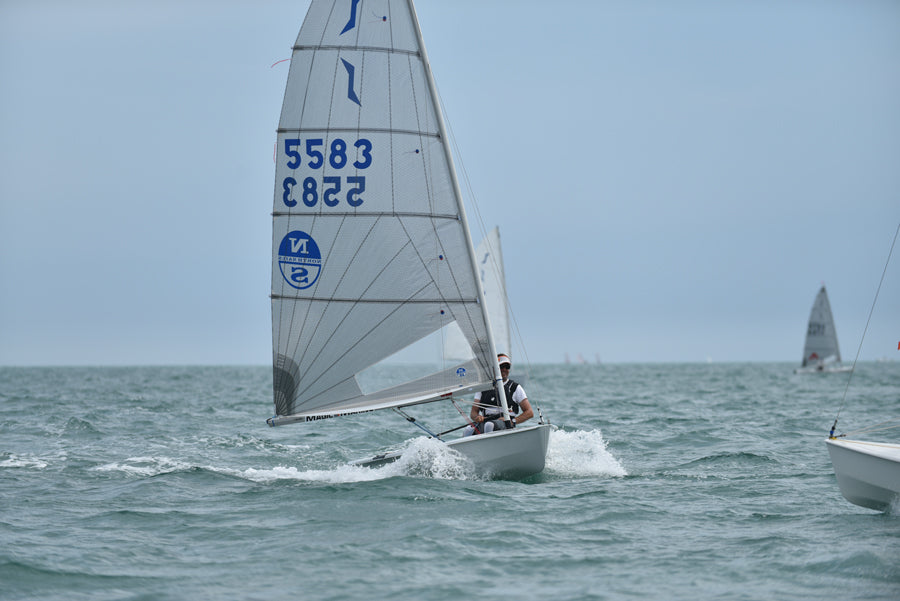
SUCCESS IN THE SOLO CLASS
2018 SOLO CLASS UPDATE
Another Fantastic Year for North Sails in the Solo class
© Errol Edwards
2018 has been a fantastic year for sailors using North Sails in the Solo class, with an almost unprecedented number of victories racked up so far this season. The current race range of P-2, P-2C and F-2 mainsails has provided sailors of all shapes and sizes the ability to go and win races at international, national and local levels of competition.
To date this season some of the major victories have been:
Solo Class 2018
Winter Champs
1
Charlie Cumbley
Spring Champs
1
Ian Walters
Spring Cup Medemblik
1
Lawrence Creaser
Northern Area Champs
1
Ewan Birkin Walls
Southern Area Champs
1
Lawrence Creaser
Midland Area Champs
1
Chris Brown
Nations Cup
1
Charlie Cumbley
Eastern Area Champs
1
Ewan Birkin-Walls
UK Nationals
1
Charlie Cumbley
2
Pete Mitchell
3
Tim Law
* Denotes Partial North Sails Inventory
On top of these majors events, there have been numerous regional and open victories, so many congratulations to all those who have added to the victory list. Our North Sails team, which includes Charlie Cumbley, Lawrence Creaser, Tom Lonsdale, Nick Bonner and Pete Mitchell have been sailing throughout the season and have been out amongst the action, challenging the Solo class sailors for titles.
Charlie, UK One Design Sales Manager commented, “Thanks to our team being on the water we have managed to ensure that we give our customers the best possible sales service. By being on the race course amongst our clients, we have created a fantastic bond which enables us to stay on top of all class and sail developments, which in turn help us to make the best possible product on the market.”
© Errol Edwards
For all those who have competed in the North Sails Super Series there is still the chance to win a North sail at the ‘End of Season’ champs in October, so make sure you are there as you have to be in it to win it!
© Errol Edwards
READ MORE
READ MORE

MELGES 20 EUROPEAN FINALE
MELGES 20 EUROPEAN FINALE
Brontolo Racing Wins 2018 World League with 3Di
📸 Zerogradinord
Brontolo Racing finished second in the final act of the Melges 20 World League European Division to secure the overall 2018 series title. With a new suit of 3Di sails, they brought their A-game to the final event, says North Sails expert Giulio Desiderato.
“As always, there was heavy competition within the Melges 20 European class events,” Giulio added. “Starting off the regatta with double bullets, and then staying ahead of Nika was what they had to do—and they did just that.”
“My main focus before each event is to make sure we have the right inventory and that everything with our boat is 100%,” said North Sails Federico Michetti, team manager and trimmer for Brontolo. “I pay very close attention to details, everything from accommodations, to eating the best food, and making sure we have time after racing to unwind together as a team.”
📸 Zerogradinord
Asked about the pressures of racing, Federico responded that “We try not to think about it, but to each do the best job we can. Our skipper Filippio Pacinotti provides us with the best equipment in order to be competitive, while working hard to make his own personal improvements too. Manu Weiller our tactician has serious talent and makes our life easier, keeping us out of trouble, which is super important.”
“Our team is working hard to improve by learning from our mistakes,” Federico concluded. “We’ve learned a lot from each other, always working hard to grow as a team. We have all really enjoyed our journey together.”
📸 Zerogradinord
North Sails 3Di is the new inventory option for the Melges 20 class as of this year. We asked Federico his thoughts on how 3Di has enhanced his sailing experience within the class.
“We love our sails. The designs have come a long way over the past few years. North has lead the way with 3Di for the Melges 20. We follow our tuning guide, we have the best products, and we are built for speed. We have better techniques and a longer lasting inventory, which has proven to be unmatched.”
Federico says the hardest part about racing in this fleet is staying consistent. The talent amongst each team is so steep that each leg must be better and faster than the one before. “With the growth of the class over the last few years, many of us are sailing at the same speed, so making mistakes is not an option.”
📸 Zerogradinord
The sailors within the class are some of the best sailors in the world. It is never easy racing against some of these teams. Federico comments; “Racing against previous world champions like Drew Freides and his team Pacific Yankee is tough. They are consistent and have impressive speed, and they never give up. It is a huge honor to race against PY and we learn more and more each time we get the opportunity.”
There was a ton of excitement as Brontolo Racing returned back to the dock. Skipper Filippio Pacinotti commented;
“I dedicate this victory to my excellent crew, and to my family that have always endured and encouraged my enormous passion for this sport. Thanks to all the friends who over the years has raced onboard Brontolo – this is their victory too!”
Full Series Results
📸 Zerogradinord
READ MORE
READ MORE
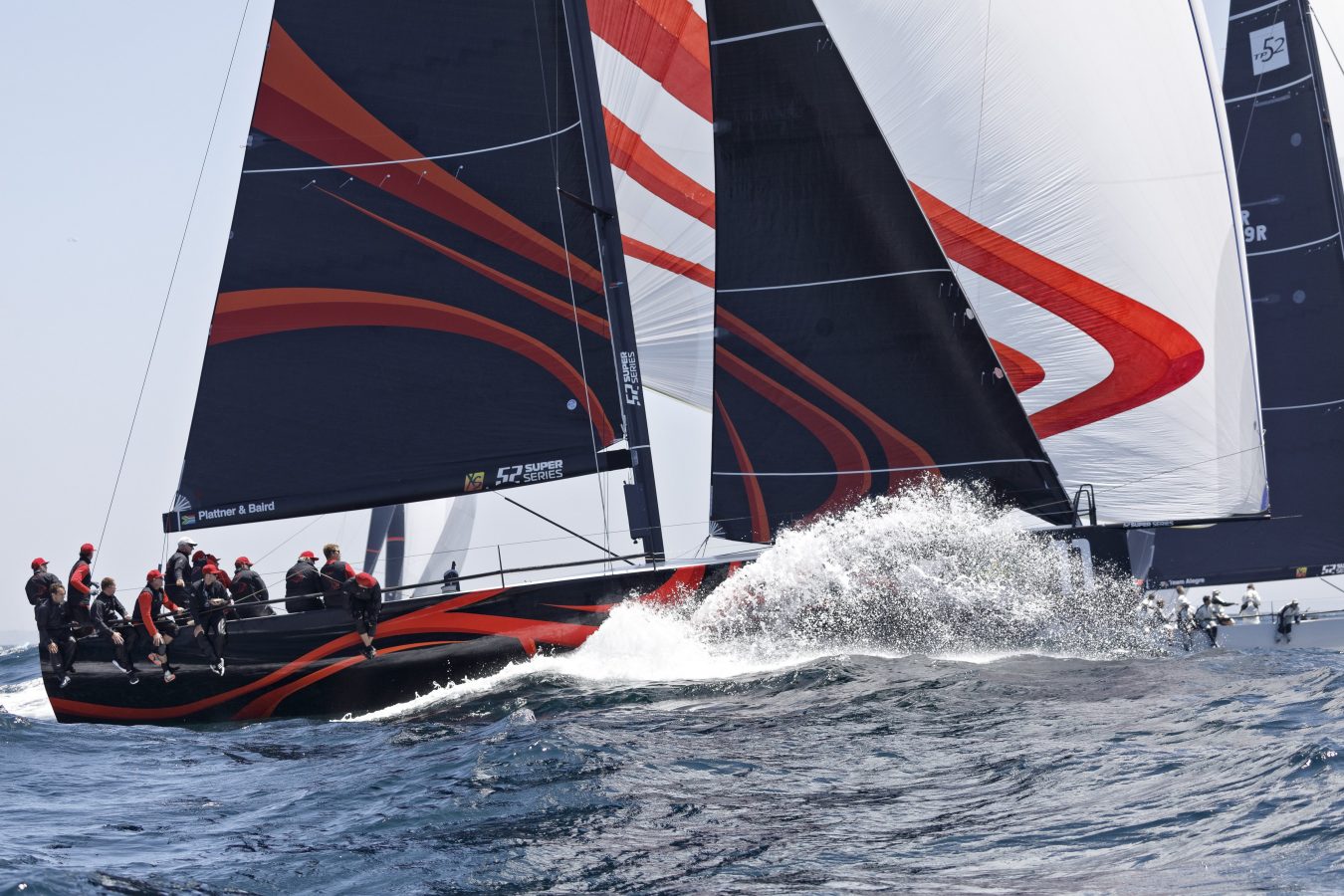
SAILS, SUPPORT AND THE 52 SUPER SERIES
SAILS, SUPPORT AND THE 52 SUPER SERIES
An Interview with Morgan Trubovich, Sail Coordinator on Phoenix
📸52 Super Series / Studio Martinez
Morgan Trubovich is upwind trimmer and sail coordinator for Phoenix, a TP52 sailing in the 2018 52 Super Series. The 52 Super Series is known as one of the most competitive racing circuits in sailing, and the 2018 season has upped the ante with many America’s Cup teams using the series as a training platform. The TP52 boats fall into a box rule, which features a deep slender keel and powerful sail area. “TP52s racing in the Super Series are all very even as different boat designs and equipment selected have gotten closer together,” explains Morgan. “Sail performance is critical, and it may be the difference that sets you apart from the fleet at a critical moment in the race.”
“The sails are the engines of the boat,” says Morgan. “If your sails aren’t good, your speed isn’t good. If your speed isn’t good, your day won’t be good!”
As sail coordinator, Morgan is responsible for ensuring Phoenix’s days are good. His job begins pre season with articulating the team’s requirements to the North Sails designers, which then rolls into managing the boat’s inventory throughout the Series. The class has a limit of 18 new sails each season and during the season Morgan is focused on tracking sail performance and durability.
📸52 Super Series / Studio Martinez
Phoenix uses 3Di RAW 880, the most carbon-dense sails offered within the 3Di family, and more carbon than any sail on the water. RAW 880 was developed specifically for the TP52 class and its availability is limited to Grand Prix inshore racing where extreme construction is necessary to meet the low stretch, lightweight demands of intense racing. Phoenix was launched for the 2018 season and, so far, Morgan likes what he sees in the North Sails product.
“I have been very impressed by the 3Di RAW 880 product. The sails built using this blend of materials seem to be lasting longer in terms of shape retention than what I have previously used. They also appear to have more dynamic shape shifting when we make adjustments to our controls.”
It’s commonly said that races are won before a boat leaves the shed, and sails are the end products of many behind the scenes hours. “The support system and the collective knowledge with North Sails set Phoenix up for a great season,” Morgan explains. I was able to meet our sail designer Burns Fallow at the loft in New Zealand, as well as the team on the floor finishing our sails. During the Series events we have North designer Shane Elliott onboard as our navigator and Mark Sadler assists me onshore with managing the sail inventory. We also have access to Paul Westlake who provides valuable insight and guidance on our sails from the coach boat.”
Phoenix and other nine boats are at their final 52 Super Series of the 2018 season. The fleet is currently sailing in Valencia through September 22. Follow along with the action on on the 52 Super Series website. And a special good luck to Morgan and the Phoenix team.
📸52 Super Series / Studio Martinez
📸52 Super Series / Studio Martinez
READ MORE
READ MORE
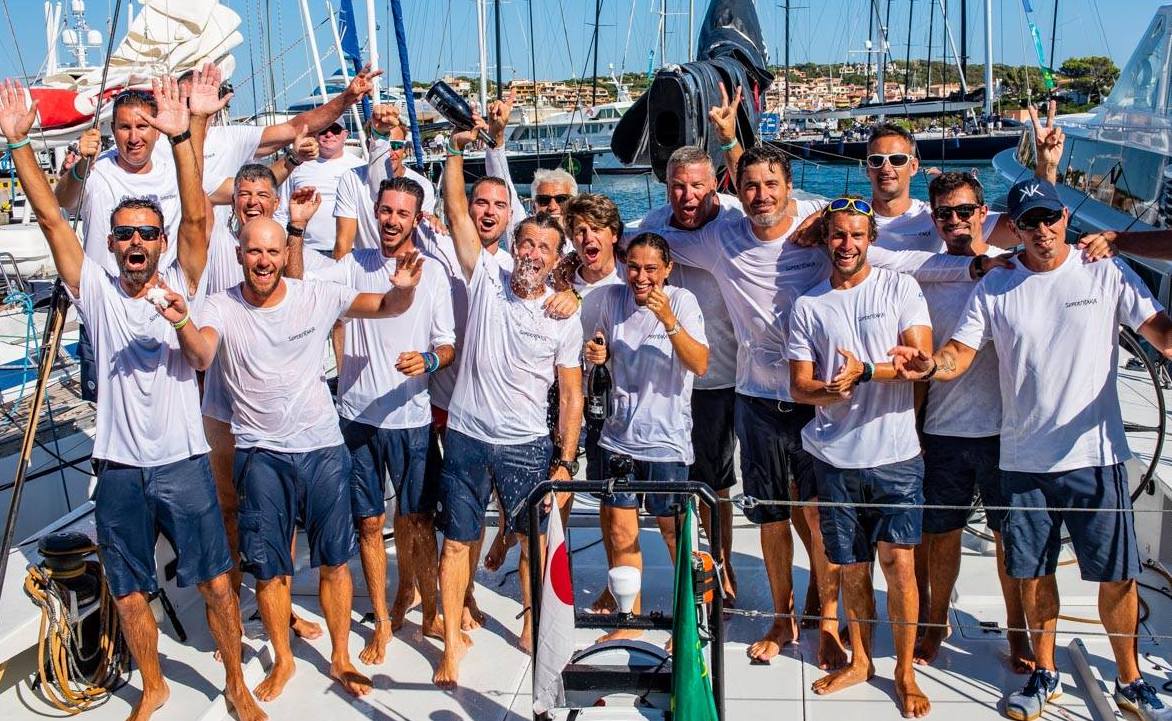
COMMANDING RESULTS AT 2018 MAXI YACHT ROLEX CUP
COMMANDING RESULTS IN PORTO CERVO
Six Division Wins at 2018 Maxi Yacht Rolex Cup & Maxi 72 Worlds
Forty-one of the world’s most beautiful racing yachts met in Porto Cervo, Italy for the 29th edition of the Maxi Yacht Rolex Cup & Maxi 72 World Championships. North clients won six of seven divisions with their North 3Di sails. Over twenty North Sails experts participated in the regatta. Porto Cervo served up a variety of conditions and race formats, challenging teams to trust their boat handling and limit their losses. Hear what our team had to say about the regatta and their firsthand experience onboard some of the most prestigious racing yachts.
Charif Souki’s Tango 📸 Rolex / Carlo Borlenghi
Laurent Delage, North Sails France, Tango, 2nd Place Wally Division
“We had great starts and good tactical calls that contributed to our overall performance this week. It was a tough battle with all of our competitors having excellent speed, but our crew work and perseverance paid off in the end. There is a lot to be said about not giving up and continuing to push the boat to its maximum potential. The Wally class gets faster each year while using a perfectly matched product in 3Di, which holds shape unlike other products that we’ve used.”
SuperNikka celebrate their win at 2018 Maxi Yacht Rolex Cup 📸Lanfrancotti-Taccola
Alessio Razeto, North Sails Italy, SuperNikka, Winner Mini Maxi Group 1
“Boat speed, starts, and sail trim set SuperNikka ahead of our competition. We were able to improve our boat performance throughout the Maxi Worlds by focusing on sail shape and rig tune. We recently introduced 3Di RAW to the SuperNikka program and we were instantly fast and ahead of the competition. Our speed downwind dramatically improved with the addition of two new kites. Our A0 in particular was a great weapon throughout the week – we were able to sail the tighter angles with ease and gained a ton of speed.”
Winner of Super Maxi Division, J8 Topaz 📸Rolex /Carlo Borlenghi
Eckhard Kaller, North Sails Germany, Topaz, Winner Super Maxi Division
“Competition within the J Class is tough as all boats have the same North 3Di sails, but each boat has their own set up and what they feel is an optimized inventory, which keeps things interesting. 3Di is perfect for the J Class – it gives a wide range for every sail. It wasn’t just one sail that made the difference for us; it was our entire sail inventory that made it possible to have a leg up on the fleet.
The Topaz team has been together for two years, and we are constantly working on sail trim and crew techniques for every maneuver. Our teamwork is above and beyond, and is reflected through our overall boat speed and handling. There were 15 nationalities onboard Topaz for this event and we really made a great team.”
H20 accepting their Rolex prize for winning the Maxi Group 2 📸Rolex / Carlo Borlenghi
Riccardo de Michele, Skipper, H2O winner of Mini Maxi Group 2. This is the third Maxi Yacht Rolex Cup win in four years for H2O.
“There’s something to be said about maintaining the same crew and skipper. Being able to work together and train together for some time has benefited our team greatly. We were also able to work closely with our sail designer who got us up to speed with 3Di, making it possible to win our division.”
Lyra, winner of the Wally Class leads J One. 📸Rolex / Carlo Borlenghi
Terry Hui, Skipper, Lyra, Winner of the Wally Division
“Being new to this class, I am learning a lot. We have a great team on Lyra. Racing in Porto Cervo is beautiful and the YCCS is the best.”
Massimiliano Florio’s Grande Orazino Southernwind 82, winner of Maxi RC and Combined division. 📸 Rolex / Carlo Borlenghi
Second place Maxi 72 Division, Dario Ferrari’s Cannonball 📸Rolex / Carlo Borlenghi
The Juan K designer Rambler 88. 📸Rolex / Carlo Borlenghi
📸Rolex / Carlo Borlenghi
Full Results
READ MORE
READ MORE
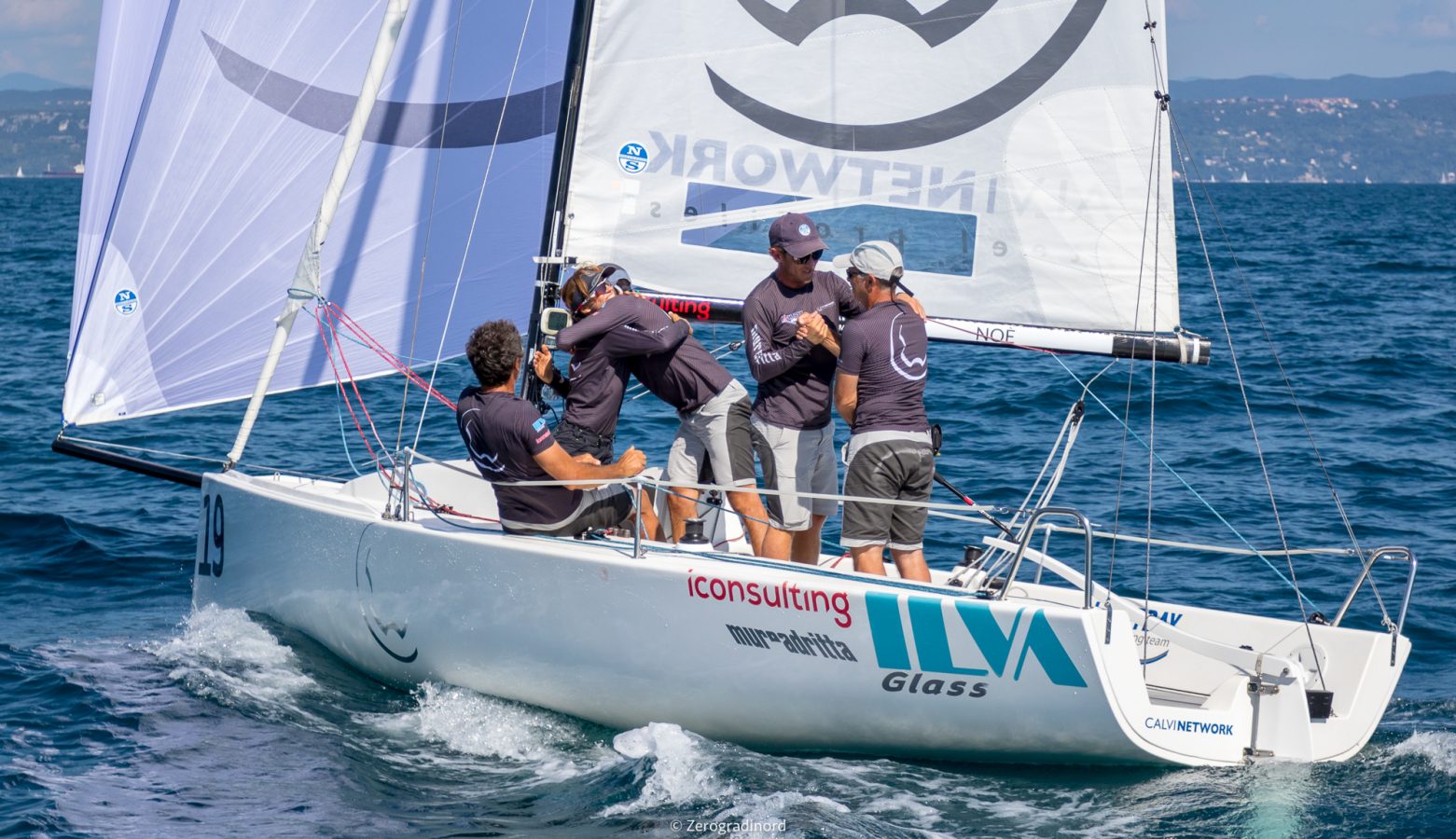
J/70 ITALIAN CUP ROUND UP
J/70 ITALIAN CUP ROUND UP
Calvi Network Wins Overall Title
© Zerogradinord
After six events at six different venues, 26 races, and 13 black flag starts, Gianfranco Noe’s Calvi Network have taken the overall title in the 2018 J/70 Italian Cup for the second year in a row and the third time since the series’ inception. Consistent racing throughout the season moved them to the top of the overall standings, despite the hot competition from European Champions, Enfant Terrible.
© Zerogradinord
Lera Kovalenko and her team on Arttube won the final event in the series for second overall in the Corinthian rankings. Paolo Tomsic and Mauro Brescacin, La Femme Terrible won the Corinthian title and finished third overall.
© Zerogradinord
The next event on the J/70 calendar is the World Championship in Marblehead, MA, USA at the end of September. Top North American sailors and European contenders will make this one of the most competitive regattas in the history of the class.
North Sails experts have contributed their J/70 knowledge, tricks, and speed tips to create the ultimate Worlds tool kit. Race your J/70 to its full potential.
© Zerogradinord
© Zerogradinord
READ MORE
READ MORE
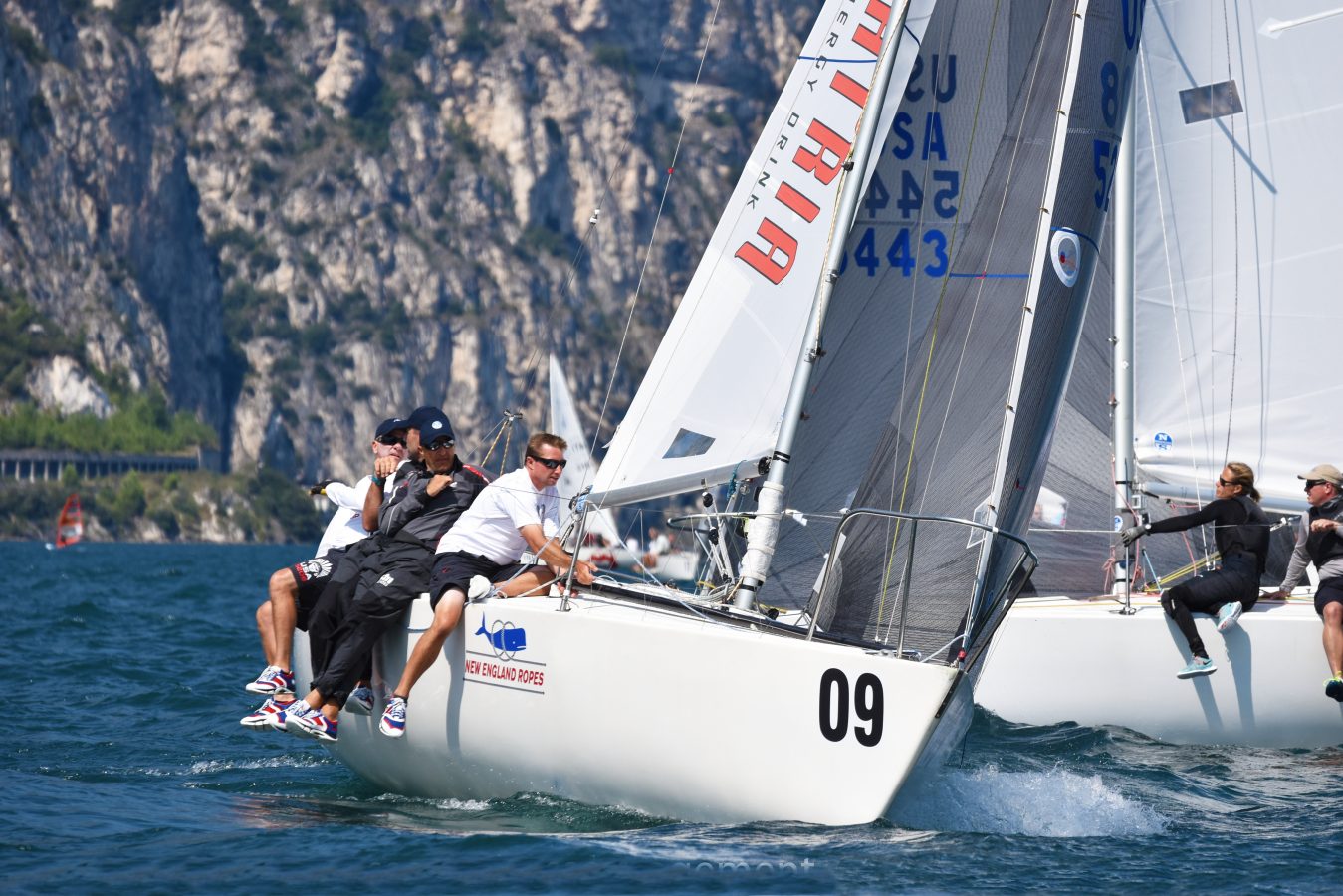
2018 J/24 WORLDS INTERVIEW
SPOTLIGHT: WILL WELLES, J24 WORLD CHAMPION
North Sails Experts Dig for Will’s Secrets to Win the Worlds
Eighty-nine teams from fourteen countries attended the 40th edition of the J/24 World Championship held in Lake Garda, Italy. North Sails One Design expert Will Welles won his second J/24 world title, dominating the scoreboard from day one, scoring 47 points over the course of ten races. Congratulations to team Kaster and crew Nick Turney, Rich Bowen, Giuliano Cattarozzi, and Andrea Casale.
Another great achievement to be noted, Keith Whittemore’s Furio finished 3rd place overall to win the corinthian division. Teams powered by North finished 1,3,5,6,7,9,10.
The North experts had some interesting questions for Will upon his arrival home from Italy. Here is what he had to say:
From Mike Ingham:
It was mostly flat water and windy, where/how did you set your genoa leads?
We call “touch/touch” our base lead position, this is when you trim the sheet in the mid-leech of the genoa touches the spreader at the same time the foot touches the chainplate. With the flat water and breeze we were mostly one or two holes aft from base. If we ever felt super over powered we’d move the lead aft and vise versa, if we felt under powered we’d move the lead forward. Seemed most of the days you could trim the genoa fairly hard with the lead back. As much as two inches of the spreader.
You were able to sail well at the high end of the genoa when much of the fleet switched to jib. How are you able to make the genoa work at the upper end without being totally overpowered?
It’s a sort of dance for sure! The key is to manage the angle of heel at all costs. Start with feathering the boat into the breeze in the onset of the puff, if that is not enough you will need to ease the sails, mainsail and the genoa. In 20+ knots with the genoa you will most likely have the genoa eased out to the lifelines. The mainsheet is eased in the puff and then trimmed on afterwards, I’ll wind the genoa sheet in when I feel we can take it. The backstay is on hard as well as the vang, the shroud tension is at our maximum tuning guide setting.
From Zeke Horowitz:
Any tips for stepping into a charter boat for the first time and trying to get it all set up the way you like it?
We were lucky with our charter boat, it was a fast boat but we did our homework months in advance. With the help of a local friend we found a good boat, which is a start but then you need to do all your homework so you can be prepared once you arrive. The key is to not burn up sailing days with unforeseen boat work. I like detailed pictures of the boat, pictures speak a thousand words….you can see how the rigging is, blocks, cam cleats, keel, rudder, mast, etc. I also send a list of yes or no questions to the boat owner, this way it’s easier for them to just say yes or no. We prepared what we needed to bring to make sure the boat didn’t have gear failure…and we brought some of the things we like to have on the boat that may not be there…winch tops, tiller, something of that nature. We make the list, gather the items, and pray it all fits into your luggage!
We heard it was imperative to get a good start at the favored end so you could be one of the first boats to the geographical shift. How did you balance conservative strategies with being aggressive enough to be one of the first boats off the favored end?
Yes, the start! Where you started and being able to get onto port straight away was the key to success. Surely it seemed you needed to be in the fray to get a good position off the start. Garda isn’t a place you can be conservative and start down the line in a less congested area. It was dicey to say the least but a must! Most everyone who started on the right end knew the deal, once in awhile you’d get one or two boats that wouldn’t tack right away and that was death.
From Mike Marshall:
What was the base setup? Prebend? Forestay sag? Upper and lower tension?
Our base set up was the same as always, 20/15 (uppers/lowers) with the silver loos gauge model B, 2 ¼ prebend measured at the spreader and two fingers on the headstay (measured with Loos gauge B). Garda is known as a windy venue with flat water and the world’s week was no different. With the flat water and breeze we were faster to make the rig tighter, faster then if it was a windy wavey venue. We always set up the rig for the first beat and figured if the breeze dropped out then we’d be able to manage through. I seem to remember we mostly sailed at 29/27 on the shrouds. Sometimes a setting tighter and sometimes a setting lower.
From Chris Snow:
What model genoa did you pick for the event and why?
Stick with what you know! We used the DX-7TT genoa, also known as the “Newport Genoa”. The SD-TH and DX-7TT are close enough in shape that we feel we can make one look nearly like the other with halyard and lead position. I think the key is knowing your settings, when to go where with the sail controls we have available in a certain condition.
From Skip Dieball
What was your favorite dinner while in Italy?
Hands down the dinner we had at Guiliano’s house, what a beautiful spot he and his family have! Guiliano owns Kaster the boat we sailed.
What was your key to getting good starts?
We were very fortunate to get decent enough starts to go the way we wanted to the first beat. The key in Garda was to battle for the right side of the line. You needed to go right so even if you got a second row start with speed you could get onto port and drag race to the right. If you started down the line and couldn’t tack you were in a really tough spot, if you stared down the line and were able to tack all the boats that were right of you were ahead by the end of the beat. So we just worked hard in the fray, time, distance to the line and looking for a lane out straight away.
From Ched Proctor
When do you decide it’s time to “Go to the wall?”
It’s always time to go to the wall in Garda! I think the question is which wall? Andrea says nine times out of ten the right works. Seemed to be true!
Are you the first American skipper to win a major event on Lake Garda?
I’m not sure! We will need to research that, somehow I suspect not, there is a lot of major events held in Garda in all sorts of different classes. One thing for sure, there may not be a prettier place to race! There is great breeze in the morning out of the North, it dies around noontime and then the Southerly comes in the afternoon. If you like wind and raw beauty Garda is for you!
From Marnie Jenkins
Sailing in Italy….did you have wine or water on board?
Water of course! Lots of good wine around Garda though!
From Chuck Allen
Is Rich Bowen on steroids to trim that well at his age?
I don’t think Rich is on the steroids, he says he works out which is the key to get the genoa in along with good timing! I wondered if Rich might be the oldest trimmer to win the J/24 worlds…Brad Read thought Moose McClintock was!
READ MORE
READ MORE
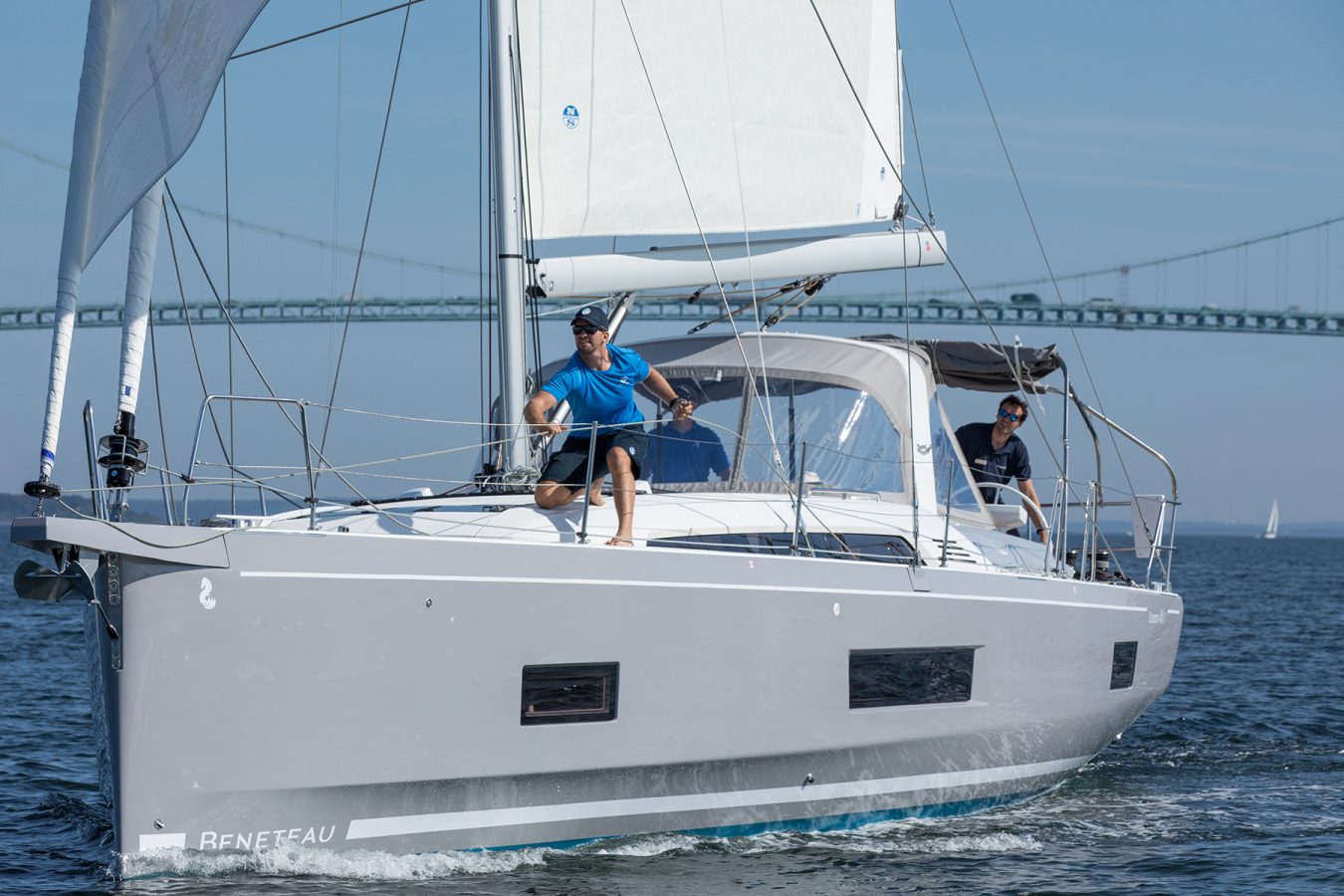
NORTH SAILS AND BENETEAU AMERICA SHOWCASE PRODUCT
North Sails officially launched a partnership with Beneteau America in Newport, Rhode Island at an exclusive event dedicated to showcasing their new sailboats. Five boats were sea-trialed by over 100 people—press, dealers, and potential buyers—during the weeklong event.
READ MORE
READ MORE
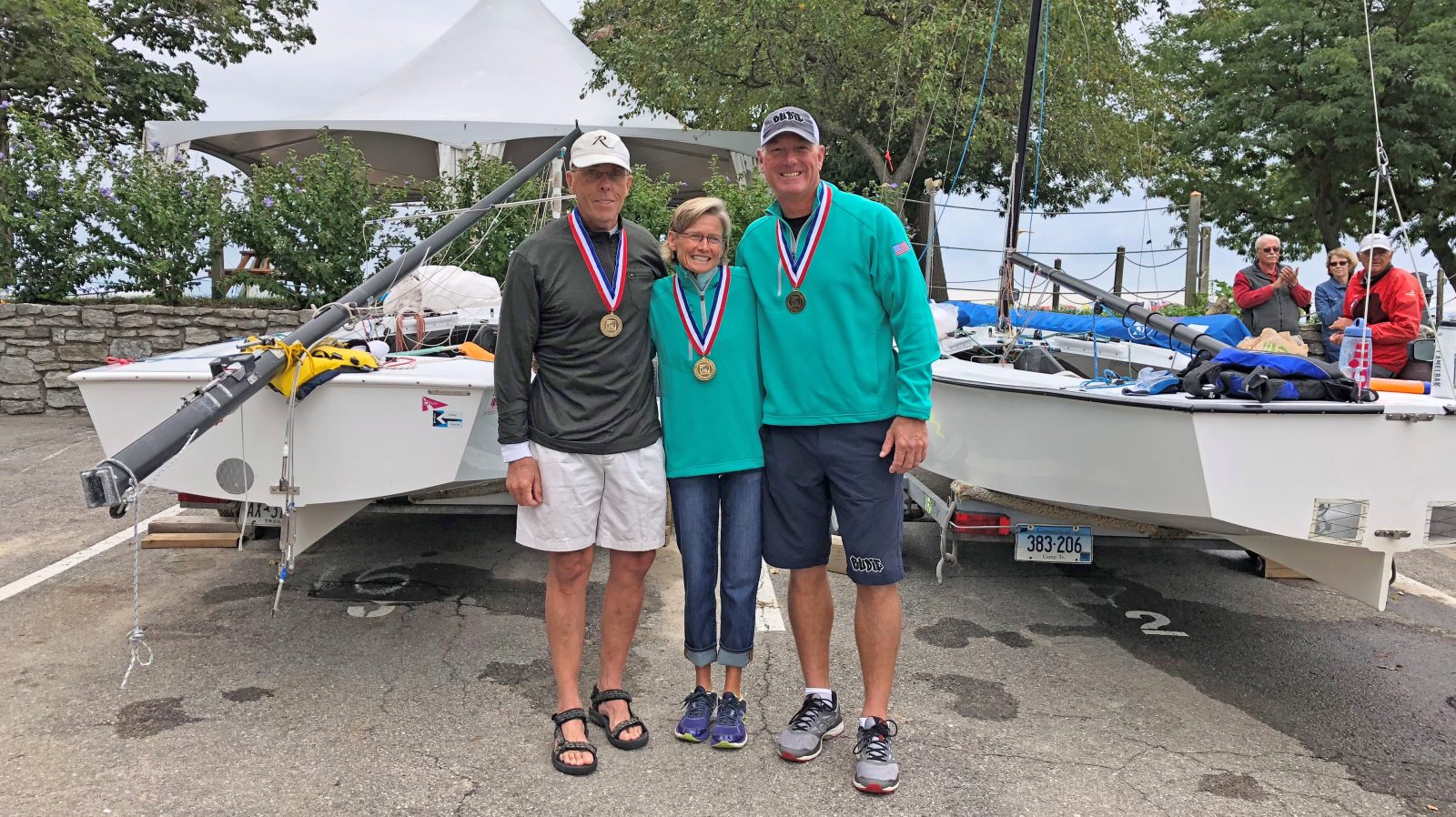
LIGHTNING US PANAM TRIALS
LIGHTNING PANAM TRIALS
Jody Starck, Iain Jones and Skip Dieball to Represent the USA in Lima
Congratulations to Jody Starck, Ian Jones and Skip Dieball on securing the US Lightning berth for the 2019 PanAm Games in Lima, Peru. Held at the Buffalo Canoe Club the weekend of September 7-9, the event had six of the eight races contested in “Peru-like” conditions with 15-25 mph winds.
The winning team scored six race wins along with a 2nd and a 6th to dominate the series and best the team of Allan Terhune, JoAnn Fisher and Jody Lutz by 12 points. 2015 PanAm Silver medalist Justin Coplan finished 3rd followed by current North American Champion Ched Proctor in 4th and current North American Masters Champion Tom Allen in 5th.
Dave Sprague as PRO did an excellent job of running races with courses featuring four windward leeward legs with no offset mark. This made the jibe-set timing crucial to positions in the race.
North Notes:
15 of the 45 sailors competing had either won a North American Championship or World Championship (or both) as a skipper or crew.
15 boats competed with the top 14 using full North inventories.
READ MORE
READ MORE
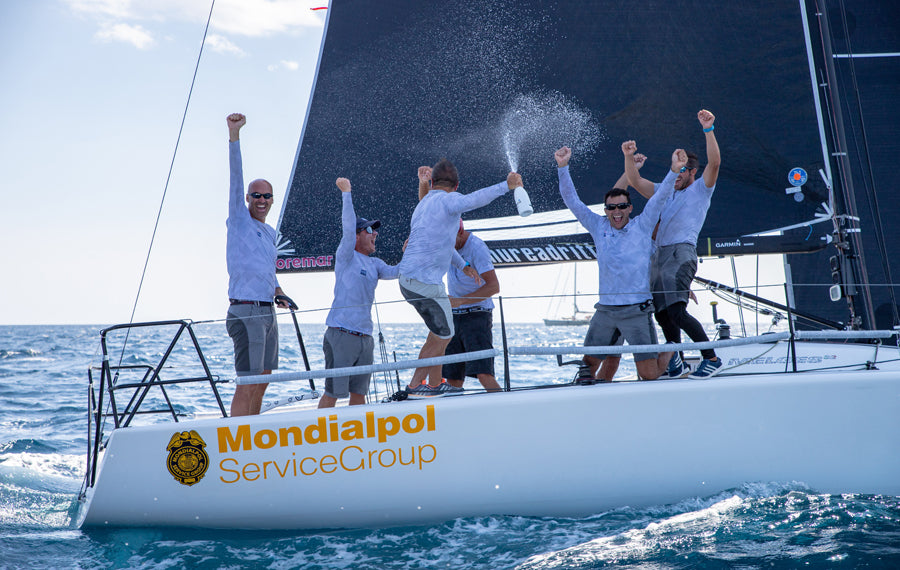
MELGES 32 GIOGI WINS 2018 WORLD LEAGUE
MELGES 32 GIOGI WINS 2018 WORLD LEAGUE
Winning the Final Event in Cagliari Seals Their 2018 Victory
The fourth and final event in the Melges 32 World League concluded in Cagliari, Italy with a podium sweep for teams using North Sails 3Di. Matteo Balestrero’s Giogi claimed the top spot for the event, which also sealed their overall victory for the 2018 season. Luigi Giannattasio’s Donino and Edoardo Lupi / Massimo Pessina’s Torpyone finished second and third. The first place Corinthian team was led by Martin Reintjes on Caipirinha; they also secured the 2018 Corinthian title.
The Melges World League is in its second year; hosting both the Melges 32 and Melges 20 in a season-long series of four regattas. “It has been successful because of the commitment from our owners, sailors, and partners like North Sails,” says Federico Michetti, head of Melges Europe.
Michetti was the visionary behind the Melges World League. He was also closely involved in the product development for North’s winning Melges 32 sails.
“Three of the top four boats in Cagliari used North Sails,” Michetti explains, “a reflection of how great the 3Di sails are. As trimmer on Giogi, I’m on the front line of providing feedback to the North design team. I love our sails and am proud to have played a part in the development of the One Design inventory.”
Michetti’s teammate on Giogi, Giulio Desiderato, sent North Sails regular updates throughout the season. We managed to catch up with Giulio to ask about their final victory.
Why was 2018 such a great season for Giogi?
Using an all-round inventory was the key to consistent performance. Out of four regattas that make up the World Series, Giogi won the last two!
“On Giogi, we improved day by day. It is Matteo Ballestrero’s third season helming the Melges 32, but three of us were new to the boat this year. The last two events we sailed as a strong team, always working together, because we were very determined to achieve our goal of winning the circuit.”
Has there been any development in the class this year?
We are using the same sail designs as everyone else; true one design. In past years the North Sails designers and engineers have worked hard to optimize the materials and layout of our 3Di designs. After the Worlds, we will collect feedback from the fleet to determine the improvements for the future designs.
Why is 3Di the best choice for the Melges 32?
As main trimmer, I am really confident matching the sails to the rig tune and adapting it for different conditions because there is a good mix between the design and the stability of the cloth.
What’s your top tip for sailing the Melges 32 fast?
Both upwind and downwind, choose the correct heel angle and keep it stable.
Full results
READ MORE
READ MORE

2018 THISTLE NATIONALS
THISTLE NATIONALS
Interview with Brad Russell, 2018 National Champion
The 2018 Thistle National Championship was hosted by Cedar Point Yacht Club and their famous “Westport Mafia” hospitality provided a great time on shore. An amazing funk band, mafia night, and food trucks throughout the week kept everyone entertained and full. North Sails hosted a chalk talk each morning with Dave Dellenbaugh and Paul Abdullah with great attendance and participation. Rules expert Dave Perry was a guest on Tuesday and turned into a 5-hour marathon session during postponement ashore.
North-powered boats took all ten top spots on the scoreboard. Our Thistle expert Mike Ingham caught up with the new National champion Brad Russell for a quick interview:
First of all, congratulations on your 2018 Thistle National Championship! Start off with telling us something about your team.
I sailed with teammates Joe Hart and Terra Berlinski. Joe and I sailed together all year and have a great time on the boat together. He’s very physical on the boat, always has a positive attitude, and excels at painting the picture of what the fleet is doing, while this was the first time bringing Terra on board and she was an awesome addition with her positivity and being proactive on the boat. We were one of the heavier boats at around 500 lbs, but it didn’t seem to hurt us much even in the light air.
What were the conditions like?
Conditions varied greatly, with one race in very light air, two in heavy air, and four in light to moderate conditions
What sails did you use?
Our speed was excellent all week and in all conditions. We use a North Fisher main, Proctor jib, and Full Radial AirX500 spinnaker.
How were you set up?
The boat is setup to get overbend wrinkles halfway back the main window when fully trimmed. Our mast is 4-9-4 on the diamonds with the black Pro Loos gauge. We started the week with our forestay at 25 and moved it to 26 after Monday when the overbend wrinkles were slightly shy of the target. We didn’t use a shim on the mast step all week, but the step is shaved. After Wednesday I would have used a shim in any more races as our main was a little too full, but it was not windy enough, so we did not. Our rake was 27’ ½” and our prebend measured exactly 1” when the forestay was 25 and got slightly greater after tightening the forestay.
Any other trade secrets you would be willing to share?
We tried a few things during the week that were different than you see on most boats. In the moderate air we were trimming the jib quite hard, often over an inch inside the 10.5” tickler we use off the diamond. This only works because we use a jib leech tell tale to make sure there is still full flow between the two sails. The other thing was dropping the traveler some in heavy air, about 6-8”, to help neutralize the helm a bit.
Tell us more about that jib tale?
We felt as long as the leach tell tale kept flowing we could trim it in more. We kept experimenting with it further in and we were able to keep it flowing and it seemed fast.
You never won a race, and you were top 4 almost every race (except the last, but we will talk about that later). Tell us your strategy for the regatta and how you were able to be so consistent.
Our strategy all week was based on staying conservative and consistent. We try to sail defensively up the middle unless we are confident one side or the other will win. We rarely felt confident what side would win the first beat so we usually found ourselves trying to stay between the fleet. We would usually lose to a couple boats from the winning side, but we got to the top mark in the top 4 in all but one race. We would then try to sail fast and work with the boats around us on the reaches, instead of fighting with each other. Once the lead pack distances itself from the fleet there’s a little more freedom to fight with the boats immediately around you.
About that last race, you were winning going in, and multi time Thistle National Champ and Match Race Pro Dave Dellenbaugh needed to beat you and put some boats in-between to take the lead, that must have been pretty nerve racking, right?
The last race was really exciting, as Dave tried to match race us backwards through the fleet after we rounded the windward mark in 2nd and 3rd. After an extremely intense couple legs we only fell back to 7th. He wasn’t able to put enough boats between us to win the regatta. I never thought I’d be good enough for Dave Dellenbaugh to care to tack on me once, much less try to match race me backwards through a fleet, so that was pretty cool!
Congratulations again to Brad, Joe, and Terra!
READ MORE
READ MORE
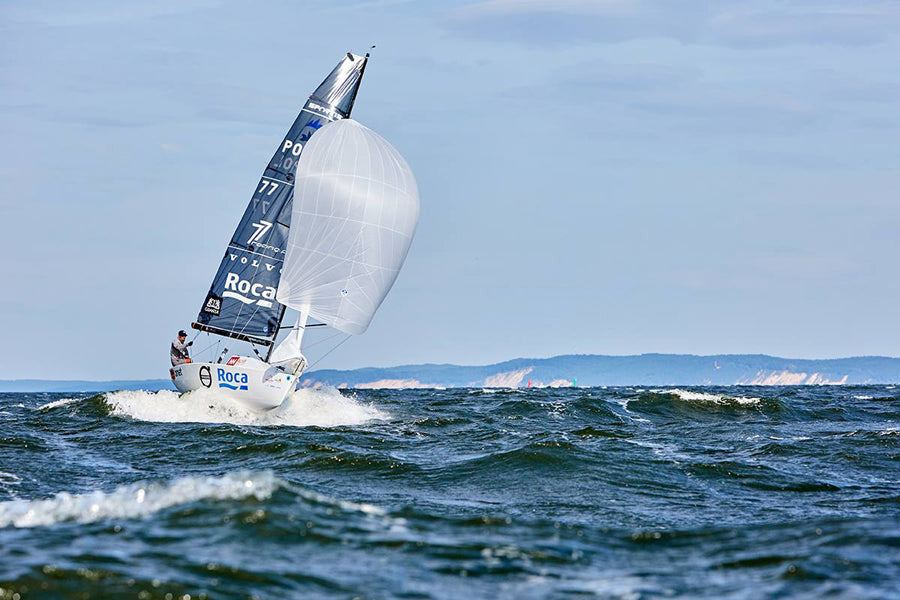
TARNACKI WINS HIS EIGHTH MICRO WORLD TITLE
TARNACKI WINS HIS EIGHTH MICRO WORLD TITLE
North Sails Prove to be the Fastest Sails on the Course
A fleet of 25 boats came together from seven countries at this year’s Micro Worlds event in Świnoujście, Poland. The Championship was a true test to the sailors with the full range of conditions across the week. The first half of the regatta was windy and wavy however the second half saw very light winds. Although there were 12 races planned, due to light wind at the end of the regatta the event was cut short on the final day.
The first and second placed boats were untouchable throughout the regatta and between Poitr Tarnacki’s Volvo Roca and Rafal Sarwocki’s Euro Shipping, they won all of the nine races, mostly with a big lead over the rest of the fleet. In the end, Piotr Tarnacki, North Sails Jockey, came away as World Champion for the eighth time! North Sails proved to be the fastest sailmaker in the fleet with boats finishing 1,2 and 4 in the overall standings and also gaining bronze medal and in the Cruiser and Racer divisions!
Congratulations to all North customers competing in the championship this year!
READ MORE
READ MORE
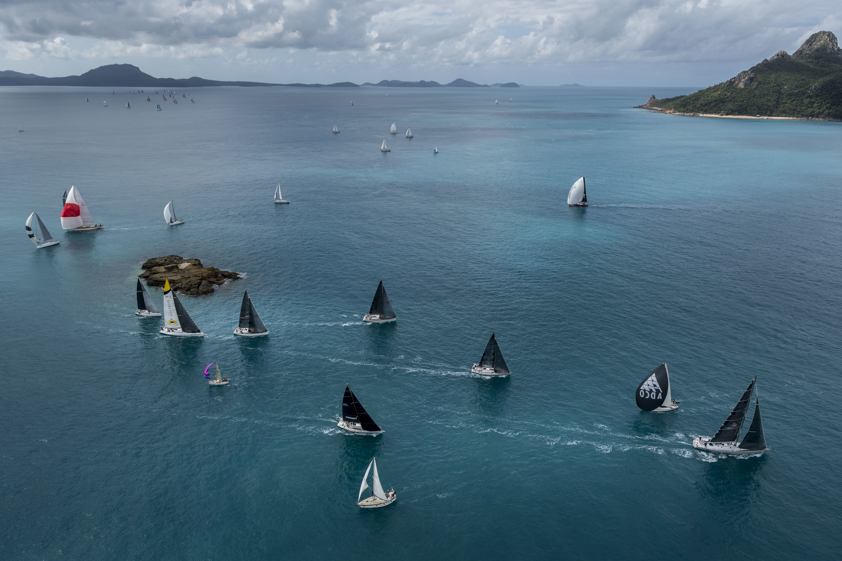
HAMILTON ISLAND RACE WEEK
HAMILTON ISLAND RACE WEEK
North Powers Multiple Class Wins at Australia’s Favorite Regatta Venue
North-powered multiple class victories at the 2018 Hamilton Island Race Week. North Sails experts were onboard to support clients in their quest to win one of Australia’s premier events. We checked in with the North team after the regatta concluded to get first-hand feedback on their awesome experiences, teamwork, sail power, camaraderie, and why they look forward to Australia’s largest offshore regatta every year.
© Salty Dingo / HIRW 2018
Alby Pratt, North Sails Sydney
“Racing on the CNB 76 Charlotte was different because she is set up more for cruising, but we were able to get a lot from her performance wise. Our crew worked well together, taking third on line honors, which was a great feat against the bigger boats. Charlotte was equipped with 3Di ENDURANCE 760, her 4th year with the same sails she uses mostly for cruising. The fact that she was built for cruising yet we were able to get her up to speed for racing is a testament to the long term value that 3Di provides, especially for this type of boat.”
© Salty Dingo / HIRW 2018
Billy Sykes, North Sails Sydney
“Hamilton Island Race Week is the biggest regatta in one of the best places to race in Australia. We had perfect conditions all week with nice breeze. There were a ton of whales on the race track, which also made it pretty awesome! If you haven’t done this event, you really should!
© Salty Dingo / HIRW 2018
Vaughan Prentice, North Sails Brisbane
“I just completed my 12th HIRW and my second year racing this event with RP100 Black Jack. 3Di RAW looked great both upwind and downwind and we had some close racing with Wild Oats, which was extra exciting. We focused on finding a faster downwind mode, and also on what sails we need to be ready for the next Sydney to Hobart. This race is very fun on and off the water, and is growing each year. I’ll definitely be coming back next year.”
© Salty Dingo / HIRW 2018
Hamish Crossan, North Sails Brisbane
“I was on Not A Diamond which is a H+H 42. It’s a new boat, so we’ve only sailed it a few times. I trimmed the main and helmed. HIRW was the owners’ first event with the boat, and we really had a great first experience as a team. Not A Diamond was equipped with a brand new 3Di RAW main and headsails. The owner loved the new sails and was grinning ear to ear after seeing them up. This was my first year at HIRW, and I had so much fun! I would definitely recommend doing this regatta, as I will be doing it again in the future.”
Not A Diamond © Salty Dingo / HIRW 2018
© Salty Dingo / HIRW 2018
Andrew Parkes, North Sails Sydney
“HIRW is one of the nicest regattas in the world. Not only is the sailing great, but seeing whales and dolphins is always a special experience. Onshore it’s a lot of fun talking to other teams to discuss the day and share stories.This regatta offers something for everyone, from Grand Prix and Maxi Yachts to cruising boats and trailer sailors. The tides are challenging and make the racing very interesting. 3Di ENDURANCE was a perfect inventory for a cruiser-racer sailing around Island courses.”
© Salty Dingo / HIRW 2018
Mark Bradford, North Sails Brisbane
“Hamilton Island Race week is always a great place to improve as there are a lot of moves that require both team work and smart decisions. We won our battle with Wild Oats, and both boats used full 3Di RAW inventories. We are looking forward to the next time!”
© Richard Gladwell
Aaron Cole, North Sails Melbourne
“I raced the 47’ Solaris Vamos equipped with 3Di ENDURANCE. Everything was the perfect fit, even though we fit the sails on the boat just days prior to the event. This regatta was one of the best in a long time. Event staff have it completely figured out; well matched division splits and great on the water communication, not to mention the fun we had onshore. It was everything we expected and more. Can’t wait till next year.”
© Salty Dingo / HIRW 2018
Paul Westlake, North Sails Sydney
“We can attribute our Hooligan> division win to the impeccable boat preparation provided by the owner: Marcus Blackmore, and project manager, Tim Wiseman. Our team is a great balance of youth and expertise, all working together toward the goal of winning. We were very well matched speedwise with Ichi Ban, so it came down to which team managed to get the little gains at the right time. The weather was warm, the wind was great, and the hospitality was unlike any other, thanks to the Oatley Family.”
Caption: Hooligan and Ichi Ban sparring upwind. © Salty Dingo / HIRW 2018
This year North Sails had 17 team members at Hamilton Race Week, as well as an onsite service loft.
© Salty Dingo / HIRW 2018
Whales were seen daily on the race track, making memories that will last a lifetime. © Salty Dingo / HIRW 2018
READ MORE
READ MORE
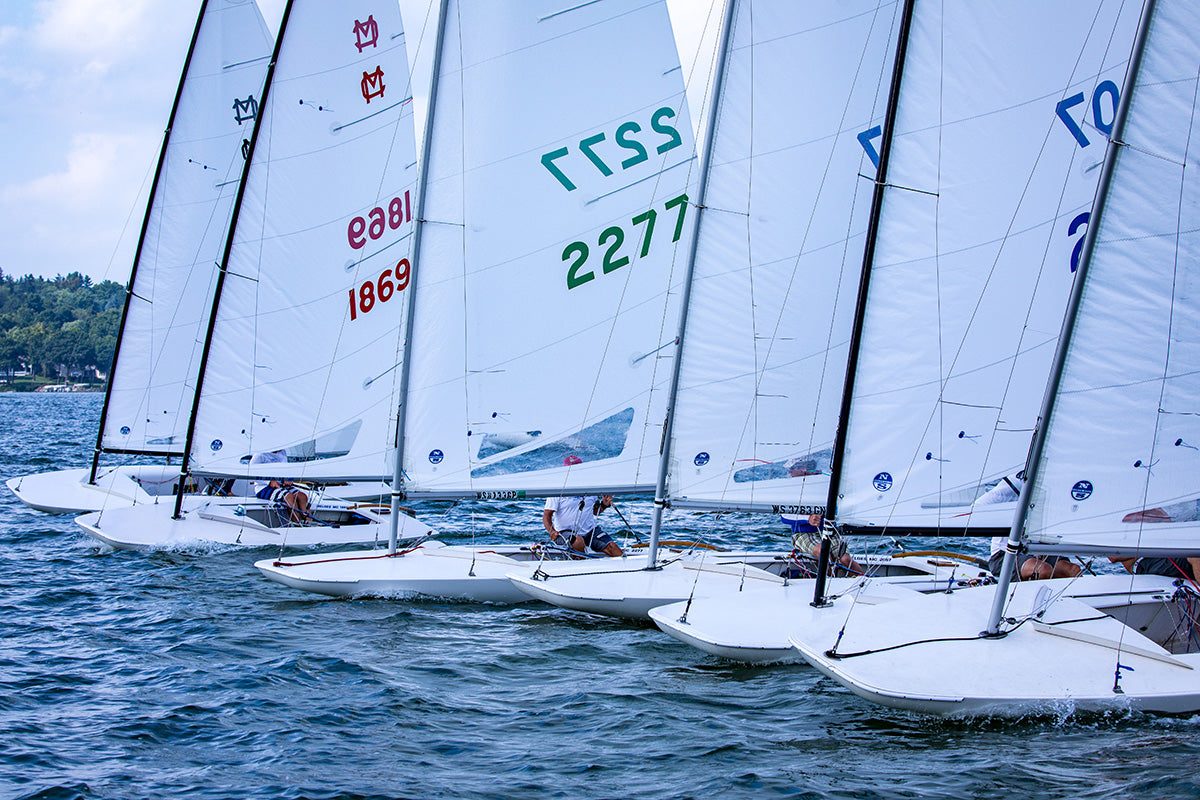
2018 MC SCOW NATIONALS
2018 MC SCOW NATIONALS
Pewaukee Yacht Club, WI
This week we held our annual National MC Championship at one of the best scow lakes and clubs in the US. Pewaukee Yacht Club (PYC) is known as a platinum standard for hosting great regattas once again pulled out all the stops for our 82 teams racing this year. If you look up the word hospitality in the sailing dictionary it would say PYC. Incredible food all morning, noon, evening for all 4 days of the regatta. At every turn, food, getting your boat in and out, buoys in and out, trailer parking, Lou Morgan’s famous Rib night was all spectacular. It seems like they had at least 75 volunteers in the total mix, maybe more.
The Regatta
The National Championship has a slightly different format than our normal regattas. It is a scheduled 7-race series with a drop race included if you get to 7 races.
The practice day saw some fantastic southwest breezes with nice temps in the high 70s on Thursday. About 30 boats raced in the 3pm practice race and about 45 boats made it out at one point or another to practice. 67 of the 82 boats were launched, in the water and on buoys by 6pm with the rest arriving late and also early on Friday morning.
For Friday we had a very unusual weather pattern upon us. Cold in the 60s and south winds. Even the locals were scratching their heads saying we have not seen this one before in August. The whole upper Midwest was both unstable with converging weather systems and storms. We had big winds but very manageable going into race 1 at 10 am on Friday. The race started on time with winds up and down between 10 and 20 mph. A WA3 was posted for our course. During race 1 on leg three, several times the PRO and other RC boats were getting big shots above our 23 mph max wind limit and also at one point had a max 35 mph gust reported. As the top ten boats rounded mark 3 and were heading downwind the PRO and RC team abandoned this race. Winds increased throughout the day and all racing for Friday (3 races) was lost. It was fun for all the crews though to get to sail. Some of the big single-handed sailors like Devon Howe were loving it though for this one (he was in the top ten) until it was abandoned.
The Sailors
Eighty-two teams from Canada, New York, Florida, Texas, Minnesota, Colorado, Illinois, Michigan, Indiana, Iowa and Wisconsin attended this year’s championship. The talent was deep in all categories. It was amazing how engaged everyone was, trying their best, prepping, practicing and more. It showed me the health of our class as they represented their fleets!
The Results
The results were really exciting. We lost day one of racing which means the series would be a max 5-race series with 3 races on Saturday and 2 on Sunday weather permitting. It was tough for the PRO and team but they pulled off three good but very challenging races in the shifty SW winds on Saturday. Velocity ranged from 5-14 mph. Going into Sunday you had several positions where big things could happen. 1st-3rd could have flipped positions easily. 4th through 15th maybe even deeper could have flipped. Then even deeper into the group there were individuals that could have easily gained or lost 15 boats by racing on Sunday with no drop race to be included. The wind however did not cooperate and we ended with no racing on Sunday. The regatta had it’s 3 race minimum in and we had a new champion.
This must have felt like ground hog day for Bill Draheim and Ted Keller as they once again tied for first this year. They tied earlier in the year along with Scott Harestad at the MC Midwinters. Bill won the tie-breaker at Lake Eustis and then again at Pewaukee. So great sailing to both of these skippers and their crews for finishing in a tie for first. As Bill joked at the PYC awards he appreciates the rules committee of our sport for their hard work on tie-breakers.
Race winners: Mike Considine race 1, Bill Draheim race 2, Jim Walker race 3
Top Master – Bill Draheim
Top Grand Master – David Koch
Top Mega Master – Tim Fredman
Top Woman – Natalie Sinn
Top Junior – Noah Janssen
Full results
Lessons Learned
Sailing the races over and over in my mind I think two main points come to mind as I look back at the moves I saw on the race course. Starting well and Patience.
Let’s break it down.
Starting Well – all three races saw 80% of the top 20 boats start well. In all three starts these teams did not start in the same place but simply started fast! They were able to accelerate and tack out from this large starting line. All three starts the top 20 boats jumped out quickly. For sure, good things were happening at the mid-line starting boat. Teams were using the RC boat to create space and escape. It happened every start. The ends provided a couple of folks escape but if you did not act quickly and take chances to cut it close and escape you were a goner. This happened to me once with Richard Blake 2 boats up, he tacks at start, boat next to me sails straight ahead for 60 seconds, we tack and we both end up 30th at first mark while Richard was 2nd. So starting, being fast and having a quick escape plan were big.
Patience – When you have a national championship the chances of the race going the distance are really good. So just racing in the moment, racing the boat next to you, looking up the lake, staying with the group and not straying is really critical. Hard to do once you are outside the top ten. You have to have confidence that your speed is good, your boat handling is good and that the velocity will come as will the shifts. Had you practiced before these races or just replayed in your mind what happened the last beat or run you know this was true. So being patient was huge and really evident in the forward groups.
Clear Air – Hardest thing to do in a 82 boat fleet is to feel like you have clear air. It is probably because you likely do not. If you are not in the top 5-10 boats this now has become a high value and you must pay attention to clear air so you can have 100% horsepower instead of say 60-70-80% horsepower with dirty air.
Other MC Class News
As the season finishes in some areas just know there is still some great racing going. The MC Blue Chip is coming up. Scott Harestad says he has some loaner boats available. Check in with him. Check www.mcscow.org for all the latest news on upcoming regattas like the Die-Hard, Polar Bear and some southern regattas this fall for anyone not liking cold weather or snow.
Team Melges provided 40 new MC Scows this season which is exciting. Check with them for all the latest news on 2019 MC Scows and plans for the new season.
Be sure to check out the Facebook pages for Melges, MC Scow, ILYA, Harbor Pictures Company for more updates, tons of pictures and video to come . There are some great pictures and videos you simply will not want to miss!
Feel free to reach out to us at Team Melges for any help you need with your MC sailing program. We would love to serve you!!
Learn more about the North MC Scow sails.
READ MORE
READ MORE
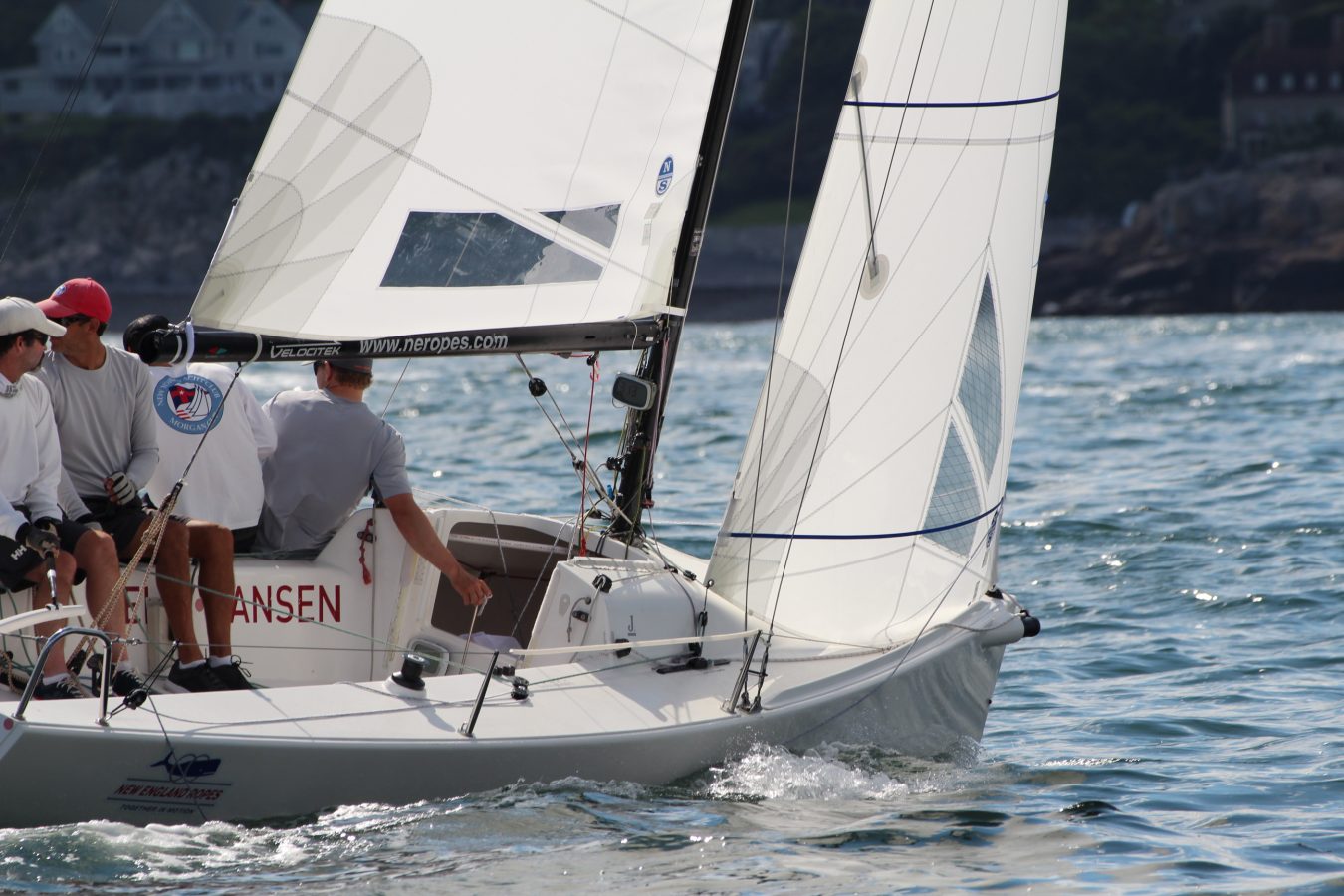
TIM HEALY WINS J/70 TED HOOD REGATTA IN MARBLEHEAD
NORTH-POWERED TEAMS DOMINATE J/70 TED HOOD REGATTA
XCS-2 & J-2 High Clew Combo Secure the Win in Marblehead
Forty-seven J/70s attended the Ted Hood Regatta held in Marblehead this past weekend in preparation for the upcoming World Championship end of September. Competitors saw three days of pleasant racing conditions allowing for a total of seven challenging races with winds ranging between 8-15 knots from the SE. All three days were very similar, with moderate to heavy chop, which comes as no surprise being a precursor as to what sailors will be expecting at the Worlds.
We caught up with North Sails expert Tim Healy to get his thoughts on his regatta winning inventory. Tim used the XCS-2 mainsail, J2-High Clew Jib, and the versatile AP-1 spinnaker, which he credited his power over chop, speed in light to medium conditions, and overall performance.
Upwind
“The hardest part about the upwind legs in each race was keeping the boat moving through the heavy chop typical to waters off of Marblehead. The J-2 High Clew jib keeps its power and depth with a twisted leech which proved fast and forgiving to trim in the difficult sea state. It is for sure my jib choice for the Worlds .”
Downwind
“Downwind was exceptionally tricky as all modes came into play. In many of the runs, we found ourselves winging, planing and in displacement mode multiple times. When planing mode was in play, there was a lot of ground that could be made up in one puff, which made things exiting! With that said, knowing when to switch gears downwind was key. Using the wing-on-wing tactically, knowing when to go bow-up to get on a plane, or stay in displacement mode were important decisions almost every run. The AP-1 spinnaker did it all and did it well! Once again the AP-1 proved itself as a great all-purpose kite and the best downwind choice for the Worlds.”
North-powered teams finished 1, 2, 3*, 4, 6, 7, 8, 9 and 1st* place in the Corinthian division.
“We had a very fun event. We decided to go with the J2-HC for the first time here at the THR. It worked well for us especially in the chop. Its powerful design helped a lot with acceleration out of our tacks and off the starting line. We also found it easy to trim. Based on our experience, given similar conditions, it will be the jib for us at the Worlds.”
Jim Cunningham, Lifted – 1st place Corinthian division
Need new sails for the Worlds? Order online or call your North expert today.
2018 TED HOOD REGATTA
J/70
1
New England Ropes / Tim Healy
2
Savasana / Brian Keane
3*
Mascalzone Latino / Umberto de Luca
4
Hydra / Martin Kullman
6
Rascal / Henry Brauer
7
Catapult / Joel Ronning
8
Rimette / John Brim
9
3 Ball JT / Jack Franco
* Denotes Partial North Sails Inventory
Full Results
Brian Keane’s Savasana, 2nd place with two race wins. Powered by North Sails.
Jack Franco’s 3 Ball JT – powered by North Sails.
READ MORE
READ MORE

TRIFECTA FOR CLASS 40'S PHIL SHARP
TRIFECTA FOR CLASS 40’s PHIL SHARP
Imerys Clean Energy Sets Record Around Britain And Ireland Powered By 3Di
©Paul Wyeth/RORC
Phil Sharp sailed Class 40 Imerys Clean Energy to line honors and first in division for the 2018 edition of the Sevenstar Round Britain and Ireland Race. They also shattered the 1800 nm race record by 15 hours with an elapsed time of 8 days, 4 hours, 14 minutes, and 49 seconds. Officially ratified, Phil Sharp, Julien Pulvé, Pablo Santurdé and Sam Matson are now in the Guiness Book of World Records!
We caught up with Phil to learn about the event that tops his third year of Class 40 racing.
“The coolest part is the extremity of the weather,” he says. “It’s guaranteed windy and fast offshore sailing. You’re getting every kind of condition packed into a relatively small course, like a condensed transatlantic. Up near Scotland the depressions come in very quickly, and you’ve got to be prepared for anything. Things can become pretty hellish sometimes, and you’ll be changing sails a lot.”
© PhilSharpRacing.com
“During the race we saw real extremes, from heavy downwind to light upwind sailing. We did two hours at seventeen and a half knots, which is our best average.”
Imerys Clean Energy is equipped with a 2016 North Sails 3Di Mainsail and 2017 headsails (J1 and NPL Sport J2 with reef). The downwind inventory includes a 2017 Code sail, 2016 Fractional A6 Superkote asymmetric, and a 2018 Masthead A2 Superkote Asymmetric. The hardest part for the team was knowing when to change sails for the fastest mode, because they saw such a wide variety of wind and sea states.
© Paul Wyeth/RORC
Driving the Class 40, Phil says, is “actually very, very light on the helm. Once you’re planing, you don’t have to make big adjustments to have the effects you want, because it’s traveling quite fast.”
Before the start, Phil was already thinking about the world record. Halfway around and in the lead, the team realized they had a good shot at it. “It’s hard, because you just have to go with the conditions you get, as opposed to when the weather is just right.” Though they were pushed hard by other boats in their class, the team won by a good margin. “Some of our competitors did not finish. The boat is highly stressed during this race, so preparation and reliability of equipment are main priorities.”
“Our mainsail is two years old now and has 20,000 miles on her. I’ve got the confidence in my sails to push the boat quite hard, and for that reason, we are very fast. Our main is so durable and holds shape very well. It feels bulletproof, something you can rely on, which is really important.”
© PhilSharpRacing.com
Asked about trimming a 3Di sail, Phil says “They’re quite sensitive to adjustments and you can completely change its shape. 3Di offers a lot of potential for tuning, and for sailing in different wind conditions.”
Phil works closely with North Sails expert Jeremy Smart, based out of Gosport, UK and says he was surprised how much direct involvement his team had with the development process. “Jeremy worked closely with this team to customize our inventory, which was really nice. We’ve been able to innovate and really develop our entire sail package over the last few years, which contributed to our success.”
© Paul Wyeth/RORC
“I’ve been very impressed with North Sails. If I have to get something repaired on the other side of the Atlantic, I’ve had equally impressive response and service. That global network is important when you’re ocean racing and end up in entirely different places around the world. I think that’s probably one of North’s biggest assets”
© PhilSharpRacing.com
“This is definitely the toughest race in the northern hemisphere, harder than a transatlantic. All credit to the team who stuck at it and were exceptional, especially when the going got tough.”
Imerys Clean Energy now sits in first overall in the Class 40 rankings.
© Paul Wyeth/RORC
© PhilSharpRacing.com
READ MORE
READ MORE
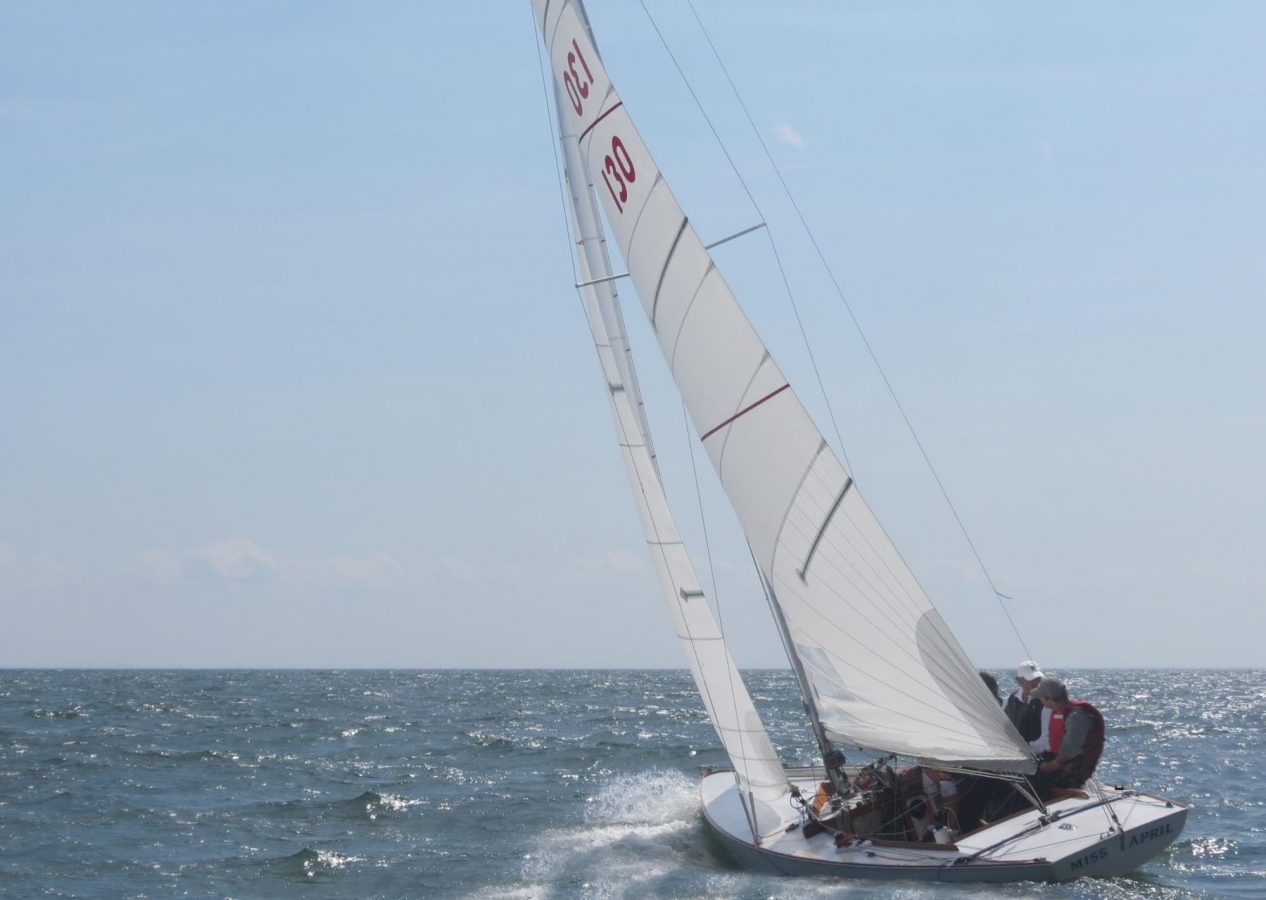
TIGHT FINISH AT THE 2018 ATLANTIC NATIONALS
TIGHT FINISH AT THE 2018 ATLANTIC NATIONALS
Steve Benjamin’s Cassady Wins the Title Tied in Points with Dave Peck’s Miss April
Madison Beach Club hosted the 2018 Atlantic Nationals with three days of good breeze that welcomed 27 teams for some competitive racing. Coming into the last race made for a very tight finish between Steve Benjamin’s Cassidy and Dave Peck’s Miss April who tied. Benj won the tiebreaker, securing his overall win. Dave’s brother Norm Peck III finished third place on Nonesuch, just one point behind second place. This was Steve Benjamin’s fourth North American title as a skipper in the Atlantic Class.
North Sails was well represented at the Nationals with Tim Healy sailing on Jeff Shay’s Papa, Rodrigo Meireles sailing with team Savvy from Cedar Point Yacht Club and North Sails designer North Sails expert Ched Proctor stood by for on the water support, checking sails and helping teams tune-up as so they could be ready for racing. We caught up with experts Tim Healy, Rodrigo Meireles, and Ched Proctor to get their take on the event.
Tim, you grew up sailing in Niantic Bay. How special it’s for you to be back in Madison sailing the Nationals?
It was great sailing in the Atlantic fleet again! I was sailing with my good friend Jeff Shay. Jeff was my junior sailing coach in the 80’s and he was also the bowman on my father’s J/24 back in the 1980 for the J/24 Worlds in Newport RI!
It was good to see fellow Niantic sailors, Norm and Dave Peck, battle it out with Benj for the Championship. The Peck’s and the Healy’s have done a lot of sailing with and against each other in many different classes including the 505, Penguin, Interclub, Bluejay, Laser, Lightning and Atlantic. Not only did I learn many important sailing skills from Jeff Shay and the Peck family, I also learned how to ski from both! My parents are friends with their parents from the Niantic Bay YC and we often spent weekends in the winter at their ski house at Magic Mountain VT.
I have many close friends in the Atlantic fleet and it was fun to catch up with them at Nationals. There are many new faces in the fleet as well. There is for sure a growing interest in the class over the past ten years. The boats are beautiful with their classic lines and are very fun to sail!
Rodrigo, you have recently joined the Atlantic class, what’s special about this class so far? How are you enjoying learning to sail a classic boat like the Atlantic?
I have been sailing the Atlantic for about a year now and I really enjoy the boat. The camaraderie of the fleet members and the classic feel of the fleet is truly one-of-a-kind. It was great to come up to Madison to compete at the Nationals with David Polsky from CPYC. I plan to race next year on my own boat.
Ched, you were supporting the fleet on the water checking sails and making sure all the competitors were up to speed for each race. As a sail designer, what’s next for the North Atlantic sails?
Our clients seem pretty happy with the sails as currently designed. It has taken 33 years of designing and evaluating Atlantic sails to get to where we are now, and it is a good place. The sails are fast and easy to handle. The longer battens in the main are a great asset to the class. They make the sails much smoother and allow for the best sail shape.
Learn more about North’s fast Atlantic sails.
2018 Atlantic Nationals
1
Cassidy / Steve Benjamin
2
Miss April / David Peck
3
Nonesuch / Norm Peck III
4
Schucks / Scott Reichhelm
5
Savvy / Dave Polsky
6
— / Chris Wittstock
7
Waypoint / Rory Coster
9
Papa / Jeff Shay
10
Thistle / Mark Foster
* Denotes Partial North Sails Inventory
Full Results
David Peck’s Miss April, 2nd place
Team SeaBiscuit powered by North Sails
READ MORE
READ MORE

ERIC DOYLE & PAYSON INFELISE WIN STAR NORTH AMERICANS
ERIC DOYLE & PAYSON INFELISE WIN STAR NORTH AMERICANS
Three Bullets, Great Speed and Consistency Secure the Silver Star
The 2018 edition of the Star North American Championship was held in Marina Del Rey by the California Yacht Club. Thirty-six teams battled for four days and eight races. We caught up with World Champion and North Sails expert Eric Doyle after earning his second Silver Star, winning the title.
Eric, congratulations on your second North American title. How were the conditions?
Conditions were typical Southern California, 6-12 knots, pretty bumpy and shifty, very challenging. The Star has lots of power so it made the racing very enjoyable. We did have several races where the wind came up at the end of the day and Santa Monica Bay put up some nice waves for us to surf downwind.
Your race results, excluding the discard, were all on top 3, including three bullets. What were the key factors that worked for you and Payson?
We have been working very hard this summer on our light air speed, everything from sails, upwind rig tune and overall set up. Our speed has really come a long way since the NA’s last year where we had a real problem in light air. We had confidence in our speed which allowed us to start very conservatively, look outside the boat to recognize the conditions and decide which way to go. We also had great downwind speed that allowed us to pass a lot of boats.
How long have you and Payson been sailing together?
We have been racing together for more than 5 years. He is a great sailor and really helps me out a lot. He is very calm on the boat, even when I screw up royally. He runs the tactics downwind and always sets us up for the next leg. It’s great to have such a solid crew.
The Star Worlds are coming up. What are your expectations?
Well, the last time I won the NA’s we won the Worlds as well but in the Star Class there are so many excellent sailors that all one can really hope for when you show up at the Worlds is that you are competitive with the top boats, sail your best, and have a shot to win going into the last race. If every aspect of your program is not at its top level, at some point during the week it will show up and you will drop out of contention. We have been working hard all summer on the West Coast so hopefully it carries over into the Worlds.
Which North designs did you use?
The whole week we used our light air mainsail, the M-05 and the J1-R5 jib. However, the weekend before when we won the King of Spain regatta, we used our standard M-16 main and seemed to go pretty fast there was well. The M-05 main uses a minimum weight cloth and has a little rounder sections which help power the boat up sooner. The jib is quite full with a wide entry that really helps in the chop which we often encounter when racing in bigger fleets.
You have been involved in the Star Class for a while now. What is it so special about the boat for you?
I did my first star regatta as a crew when I was in high school (long time ago) and bought my first boat right out of college in 1990. With the small mast section and huge amount of sail area, the rig tuning and sail trim is very critical and if you understand the dynamics of a Star boat, you can race any boat in the world. There is also the challenge of just you and one crew member handling everything on the boat – sail trim, rig tune, boat balance, tactics, etc. Also, as soon as the wind comes up, the boat is very physical and requires a lot of hiking and force to muscle the boat around the track. It is by far my favorite boat to race!
What are your major titles in the Star Class?
We won the 1999 World Championship in Punta Ala, Italy, same year we last won the North Americans in Boston. I have also won the Spring Championships but I can’t recall the year. It is always very special to win a Star Class event as the competition is very challenging and the friends are the best. Always lots of fun in this class!
Congratulations Eric and Payson and good luck at the Worlds.
Learn more about North Sails fast Star designs.
North Sails Jib Jenga
READ MORE
READ MORE
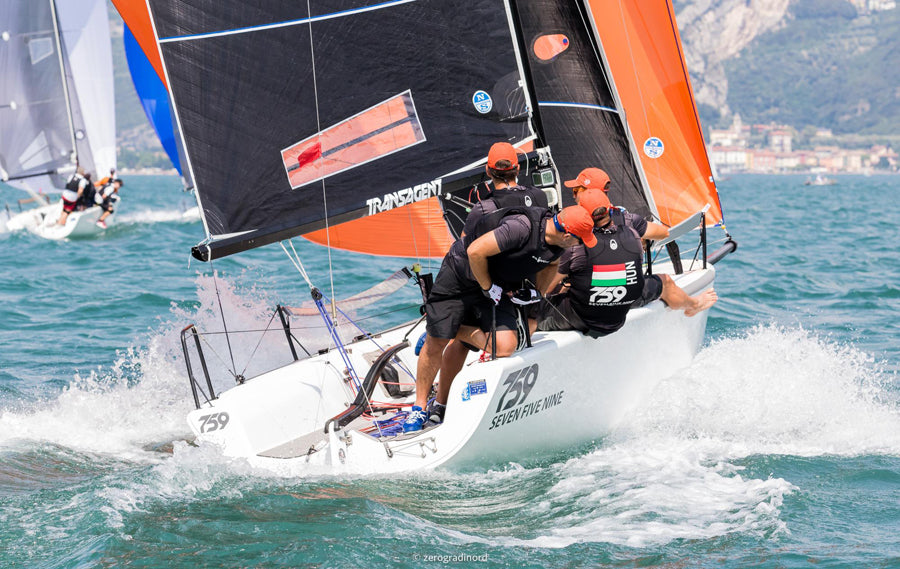
3Di PERFORMS AT THE MELGES 24 EUROPEANS
3Di PERFORMS AT THE MELGES 24 EUROPEANS
Thoughts on the New Melges 24 3Di Mainsail
The Melges 24 Europeans hosted by Fraglia Vela Riva on Lake Garda gave the seventy-two competitors everything that is to be expected on a typical summer day racing on Lake Garda – light winds in the morning followed by a strong mountain breeze coming in the afternoon. Over the past year North Sails have put in a lot of development to their small boat 3Di sails which has included a new inventory for the Melges 24 class.
We spoke to North Sails expert John Bowden who was onboard third placed USA team Lucky Dog. They used the new North 3Di designs for the Melges 24 class and this is what John had to say about their performance.
What is your role on the boat and what were the things you were looking out for in the big breeze?
I am the trimmer, responsible for the sails for the boat. We were happy with our setup in the breeze and we were very happy with the flexibility of the 3Di sails in the only one light air race of the event.
Which sails were you using? And how did you find them?
We used the 3Di Mi-1 mainsail for the three days leading up to the regatta and the more we used the sail the better it looked. Through our tuning and speed testing with the top boats we were extremely satisfied with the 3Di performance that we decided to measure the Mi-1 mainsail at the very last minute. For the jib, we used the standard J-7K jib. We measured the P-1 and the P-3 Asymmetrics although we raced with the P-1 95% of the time.
What was the trick to go fast upwind in these conditions?
The main setup very well, we stuck to the North Sails tuning guide. The mainsheet was a bit more sensitive than the old sail, but once we got used to it the sails went up and down the range better than expected.
And the same for downwind?
Downwind we used the P-1 spinnaker and were super happy with that sail. It has always been our default.
The big surprise was that there was more sheet load on the mainsail downwind. I think this was a huge factor in our speed downwind. Great layline calls were also critical, but the lack of stretch in the Mi-1 3Di Mainsail gave us more power down low to help us go forward. We were quite surprised at how the sail made that big of a difference off the wind.
Did you use the North Sails tuning guide?
Yes, we stuck with the tuning guide. The Mi-1 3Di Mainsail seemed to react very similarly to the AP-3 Mainsail in all conditions. We were just conscious to not be too loose as the lack of stretch in the mainsail made it quite powerful.
Do you have anything else to add about the sails?
We were very happy with the new mainsail, 3Di is definitely our future. We are looking forward to spending more time with the new jib. I think the durability of the material will be huge for these sails. We are expecting to see almost twice the life out of them over the standard sails!
Are you interested in our Melges 24 3Di products? Get in touch with a class expert today!
READ MORE
READ MORE
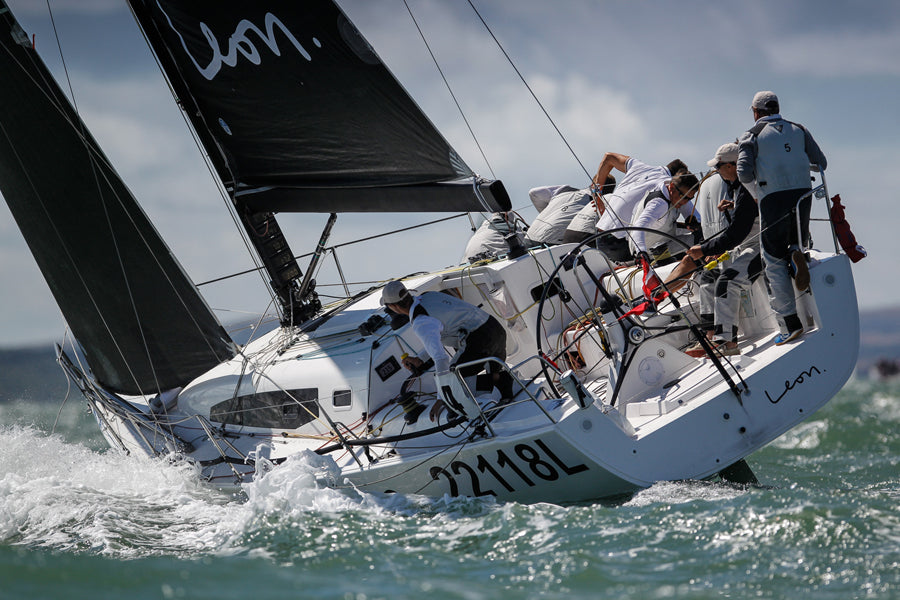
ANOTHER SUCCESSFUL YEAR AT COWES WEEK
ANOTHER SUCCESSFUL YEAR AT COWES WEEK
North Powers Boats from One Design to TP52s
With everything from Etchells and J/70s to Fast 40s and TP52s, Lendy Cowes Week is an entirely inclusive sailing week with thousands of competitors taking part in one of the world’s largest sailing events in this iconic destination. What started off to be a very light air week with racing relying on seabreezes rather than gradient winds, turned very quickly on the final day of racing with extreme conditions and racing called off just an hour into the final race after eye opening conditions on the water.
David Franks J/112 Leon © Paul Wyeth
An outstanding performance was put in by the new J/112 Leon whose previous owners were winners of the IRC Worlds and Europeans. Now owned by David Franks, Leon and team put in a stellar performance, winning the majority of the races in Class 4. Franks brought his experience from his JPK 10.80 Straight Dealer to the race course to take the win in the class and hold off fellow J/112 sailors Davanti Tyres skippered by Paul Heys and Chaz Ilvill.
With six different IRC fleets the racing was close amongst all the yachts. Adam Gosling’s new JPK 11.80 YES! pulled back from a 2-6 over the weekend to win IRC 2 overall. In second and third places respectively were Christopher Daniel’s Juno and Tony Mack’s Mcfly who were tied on equal points and trailing shortly behind YES! by just 3 points.
IRC0 was dominated by Tony Langley’s TP52 Gladiator all week, who won four out of six races. The competition between second and third was much closer between Lady Mariposa and Tokoloshe. Unfortunately with the last race being abandoned, Michael Bartholomew’s Tokoloshe had too much to come back from and ended up just one point behind Lady Mariposa.
Nicklas Zenstrom’s Fast 40+ RAN © Paul Wyeth
The main event for the Fast 40+ was the first four days of the regatta, where they had a mixture of short windward/leeward and coastal races. Despite some hot competition from Peter Morton’s Girls on Film, Nicklas Zenstrom’s, RAN once again stormed the results giving them a three-point lead and the overall win.
The J/70 fleet had their highest turnout for a regatta this year in the UK with many charter boats revelling in the success of the One Design class. With 41 boats on the start line, it was experience in the fleet that proved to be the key to success. After a slow start to the week, Paul Ward’s Eat,Sleep,J,Repeat recovered to take the overall win thanks to a string of bullets in the coastal races.
The XOD fleet was one the strongest One Design classes on the water, with a total of forty-nine boats coming from Itchenor, Lymington, Cowes and Hamble. Andrew Tremlett’s Lass had a fantastic week, winning four races and the overall win for the second year in a row.
Andrew Tremlett’s XOD Lass © Paul Wyeth
As well as the above mentioned, there were many more strong performances across all the fleets by North Sails clients, congratulations to all those competing.
Results
Cowes Week 2018
Fast 40+
RAN / Nicklas Zenstrom
Class 0
Gladiator / Tony Langley
Class 2
Yes! / Adam Gosling
Class 4
Leon / David Franks
Class 5
Swuzzlebubble / Phil Plumtree
Farr280
Toucan / Glyn Locke
Quarter Ton
Aguila / Sam Laidlaw
Etchells
Man’s Best Friend / Martin Hill & Andrew Palfrey
XOD
Lass / Andrew Tremlett
J/70
Eat,Sleep,J,Repeat / Paul Ward
* Denotes Partial North Sails Inventory
READ MORE
READ MORE
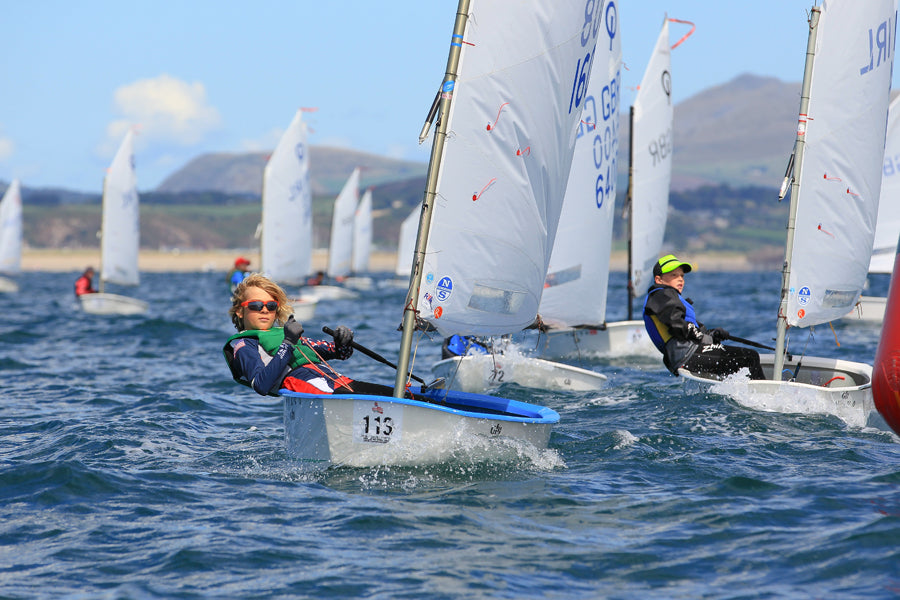
R-2 OPTIMIST SAIL SHINES THROUGH
R-2 OPTIMIST SAIL SHINES THROUGH
Rocco Wright Wins Junior Fleet at UK Optimist Championship
Rocco Wright, Junior Fleet Winner © Andy Green
More than 370 young sailors representing over a dozen countries descended on Plas Heli, Pwllheli, for the 2018 Volvo Gill Optimist British National and Open Championships.
The event officially launched with a colourful parade of sailors and international flags, followed by an opening ceremony serenaded by a Welsh male voice choir. The occasion also included a Welsh poem read and translated by Welsh sailors Tasmyn Green and Callum Davidson-Guild to welcome the fleet and set the scene for the week.
The first day of racing saw PRO Ian Bullock and his team working hard to get a race away for the 154-strong main fleet, only to be thwarted by massive shifts in the sunny but fickle conditions, which saw a number of starts and two races abandoned. The 120-boat junior main fleet was likewise on the water but unable to get any racing.
The racing regatta fleet of 56 sailors and 41-boat coached regatta fleet had more luck, with up and coming Optimist sailors able to hone their skills on smaller courses closer to shore.
In total there are 371 sailors competing, including around 100 young helms from 13 different nations who have joined GBR’s Optimist sailors to compete for the open title, attracted by the world class junior racing offered by the British National Championship.
Overseas competitors include large teams from Ireland and the USA; a number of sailors from Bermuda, Spain, Hong Kong, the Cayman Islands and Australia; plus entrants from Holland, France, Belgium, South Africa, St Lucia and the Virgin Islands.
In the 120-boat Junior main fleet, Ireland’s Rocco Wright powered by his R-2 Radial North Sails managed to overtake USA’s Aston Smith for the open title during the gold fleet series, with Ben O’Shaughnessy (IRL) third. Way to go Rocco!
Another special mention goes to the young Spanish sailor Ona García Parés who finished second placed female in the Junior fleet, also using the R-2 sail.
Congratulations to all our young North Sails customers who were competing at the Championship. Click here to find out more about North Sails Optimist products.
Ona García Parés, Second Girl, Junior Fleet © Andy Green
Full results
READ MORE
READ MORE
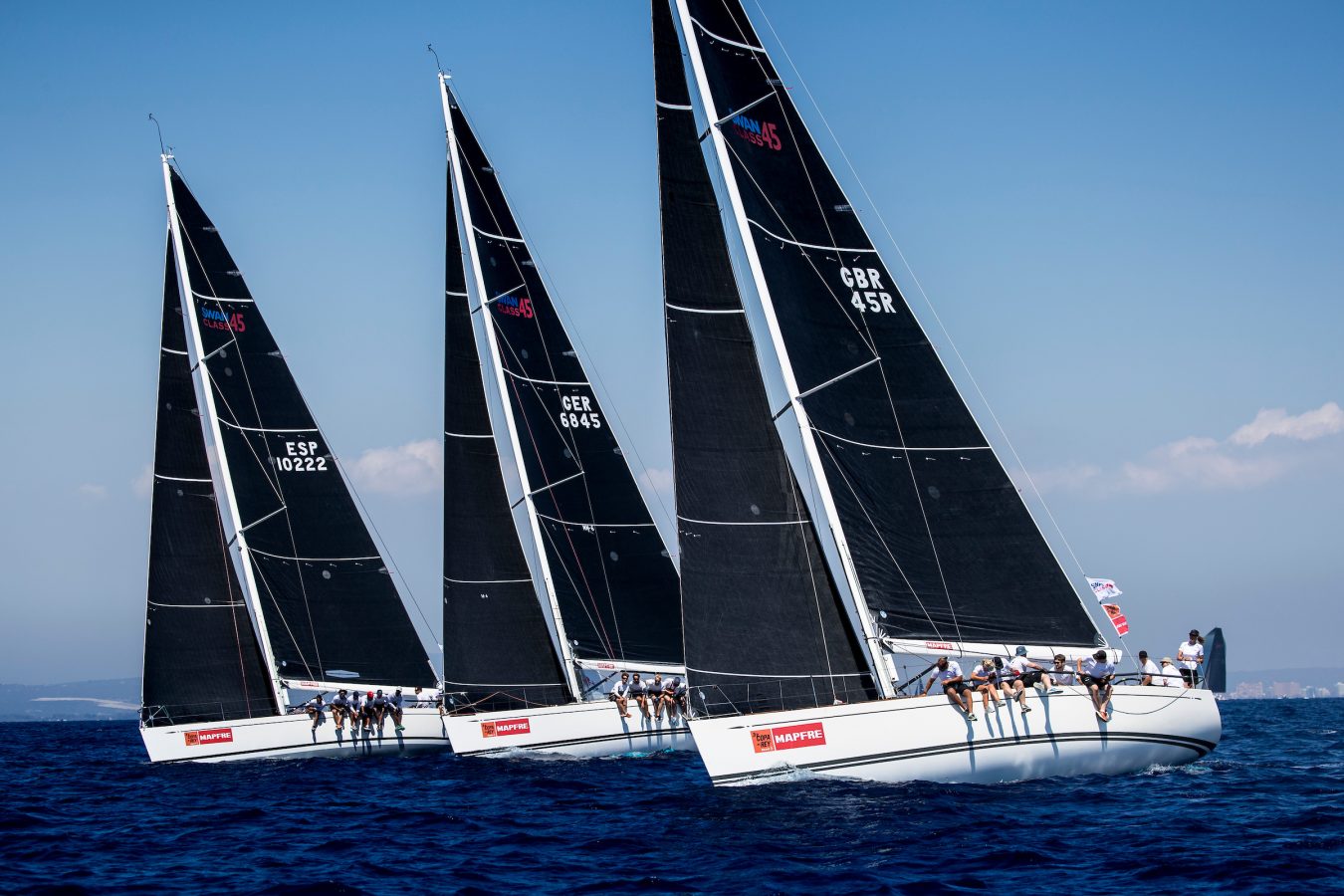
NORTH SAILS DOMINATES COPA DEL REY
NORTH SAILS DOMINATES RESULTS
Victories for Clients Across Classes at Copa del Rey
📸María Muiña/37 Copa del Rey MAPFRE
It’s not easy for a single sailmaker to dominate the leaderboard in a 150+ boat regatta but that’s exactly what the team from North Sails witnessed in Palma at the prestigious Copa del Rey MAPFRE last week. In the end, North Sails clients won 11 of 13 classes at the Copa del Rey. King Felipe VI and the Spanish Royal Family hosted the awards ceremony for the event North Sails expert Alessio Razeto called the “Boatspeed World Championships”.
The success at the Copa is attributed to a combination of sails, that deliver boat speed, and client support, which delivers confidence. For Alessio, last week’s results are achieved by stacking the cards in our client’s favor. “All of us at North Sails are concentrated on what we have to do each day to help our clients achieve results,” Alessio explained. “Our job does not stop once the product is delivered. We also make sure the customer and their crew are fully educated on how to use the product to its full potential. Our client support includes sea trials, organizing clinics and providing a coach if that’s the right fit. Finding the ideal product and support to match our customer’s expectations helps them to be more successful on the water.”
“The majority of feedback we get from our clients is ‘I’m fast or I’m not fast,” Alessio explained. “They’re easily reaching the speed or not, which is dependent on many factors but sails play a huge part. As you’d assume, the feedback from this event was good and the leading boats were super happy with their boat speed.”
📸Laura G Guerra/37 Copa del Rey MAPFRE
“Giulio Desiderato is a young North Sails expert who was placed as a coach with Alessandro Rombelli’s Melges 40 Stig, Alessio explained. Stig won the Copa Del Rey in the Melges 40 class which was also the third event of the Melges 40 Grand Prix series. “Giulio is there to help the Stig make sure the team using their North sails to the full potential, and also provides first hand feedback to the North design team”
While North 3Di has become the gold standard for performance, Alessio made sure to point out how impressed he was by the North Downwind sails he saw at Copa Del Rey. “Design, shape, speed, we’re doing a great job with downwind sails.” Alessio commented. “The North design group fully committed to improving downwind performance over the last year and it’s really making a difference.”
📸María Muiña/37 Copa del Rey MAPFRE
“Every day, at exactly at 1 pm, the seabreeze kicks in on the Copa Del Rey race courses.” Alessio explained. “The direction is more or less stable, with the velocity slowly creeping up as the day progresses. These conditions put a premium on maximizing the range of light air sails.”
“The race organizers are fantastic and have done a good job development this regatta over the last 11 years. The race committee is always accurate in moving the marks on each of the courses to provide a fair playing field for all the competitors. And, we’re used to racing in the water in Europe, and it’s not really common to find this kind of organization.”
📸María Muiña /37 Copa del Rey MAPFRE
“Sailing out of the Real Club Nautico de Palma is amazing because you have everything you need. You have the wind, you have the race organization, you have accommodation, you have yacht club…Honestly, it’s a great event, in a great location and you couldn’t ask for much more.”
📸María Muiña/37 Copa del Rey MAPFRE
📸María Muiña/37 Copa del Rey MAPFRE
📸María Muiña/37 Copa del Rey MAPFRE
2018 Copa del Rey Results
BMW ORC 1
1
ESTRELLA DAMM / NACHO MONTES / OSCAR CHAVES
BMW ORC 2
1
ANTONIO BANDERAS DESIGN / JAVIER BANDERAS
CLUB SWAN 50
1
EARLYBIRD / HENDRIK BRANDIS
MRW SWAN 45
1
K FORCE / JAN DE KRAKER
CLUB SWAN 42
1
PEZ DE ABRIL / JOSE MARIA MESEGUER
MALLORCA SOTHBEYS IRC
1
BEAU GESTE / KARL KWOK
MELGES 40
1
STIG / ALESSANDRO ROMBELLI
GC32
1
INEOS TEAM UK / BEN AINSLIE
6M CLASSICS
1
BRIBON / JOSE CUSI
6M MODERN
1
SOPHIE RACING / HUGO STENBECK
HERBALIFE J/80
1
BRIBON-MOVISTAR / MARC DE ANTONIO ALTAMIRA
* Denotes Partial North Sails Inventory
READ MORE
READ MORE
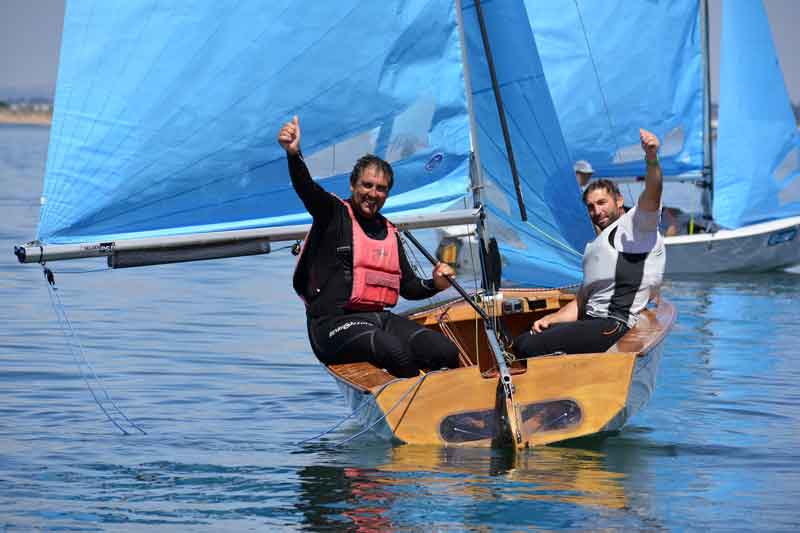
ENTERPRISE UK NATIONALS
ENTERPRISE UK NATIONALS
Nine Of Top Ten Boats Powered by North Sails
The 2018 Enterprise National Championships took place at Exe Sailing Club with the thirty-seven entries being treated to a wide range of conditions. Sunday was cancelled, with 35 knots of breeze and the last race day cancelled due to no wind! The three racing days in between, however, we were treated to eight fantastic races ranging from 15-20 knots of breeze on Monday and Tuesday and 8-12 knots on Thursday.
The event started strongly for Dave and Chris Jackman from Looe, with a stellar 1st day of 3 race wins. Clearly revelling in the strong winds, they continued this into the 2nd day with another bullet, followed by a 2nd in race 5. Phil Ford and Jane Humpage were putting a good series also, with a string of 2nd places to sit within striking distance of the lead. A well earned lay day on Wednesday gave the fleet’s legs time to recover from all the hiking out on the first 2 days.
Thursday was much lighter and we saw a different group of boats at the from of the fleet. Defending champions, Jeremy and Becca Stephens from Penzance had a great day with 1,3,5 to move up to 3rd overall. Phil and Jane had a solid day to move up to 2nd overall with a 3,5,4 and Dave a Chris managed to hold onto 1st place overall with a 15,7,9.
As it happened this is how the event finished with no racing on Friday due to a diminishing Northerly breeze, which finally dropped away to nothing, giving the race committee no choice but to abandon racing for the day early. So Dave and Chris were crowned 2018 National Champions; very deserved and popular winners it has to be said with Phil and Jane finishing as runners up for the 3rd year in a row!
Exe Sailing Club did a fantastic job running and hosting the event and thanks must go to all the club officials and members who volunteered their own time to help make it the success it was.
It was a great event for North Sails too, with 9 of the top 10 boats overall using the blue badge including the winners. As co-sponsors of the event, there were lots of happy recipients of North Sails caps and other North Sails merchandise throughout the fleet.
Get in touch with the team if you are interested in any North Sails Enterprise products!
READ MORE
READ MORE
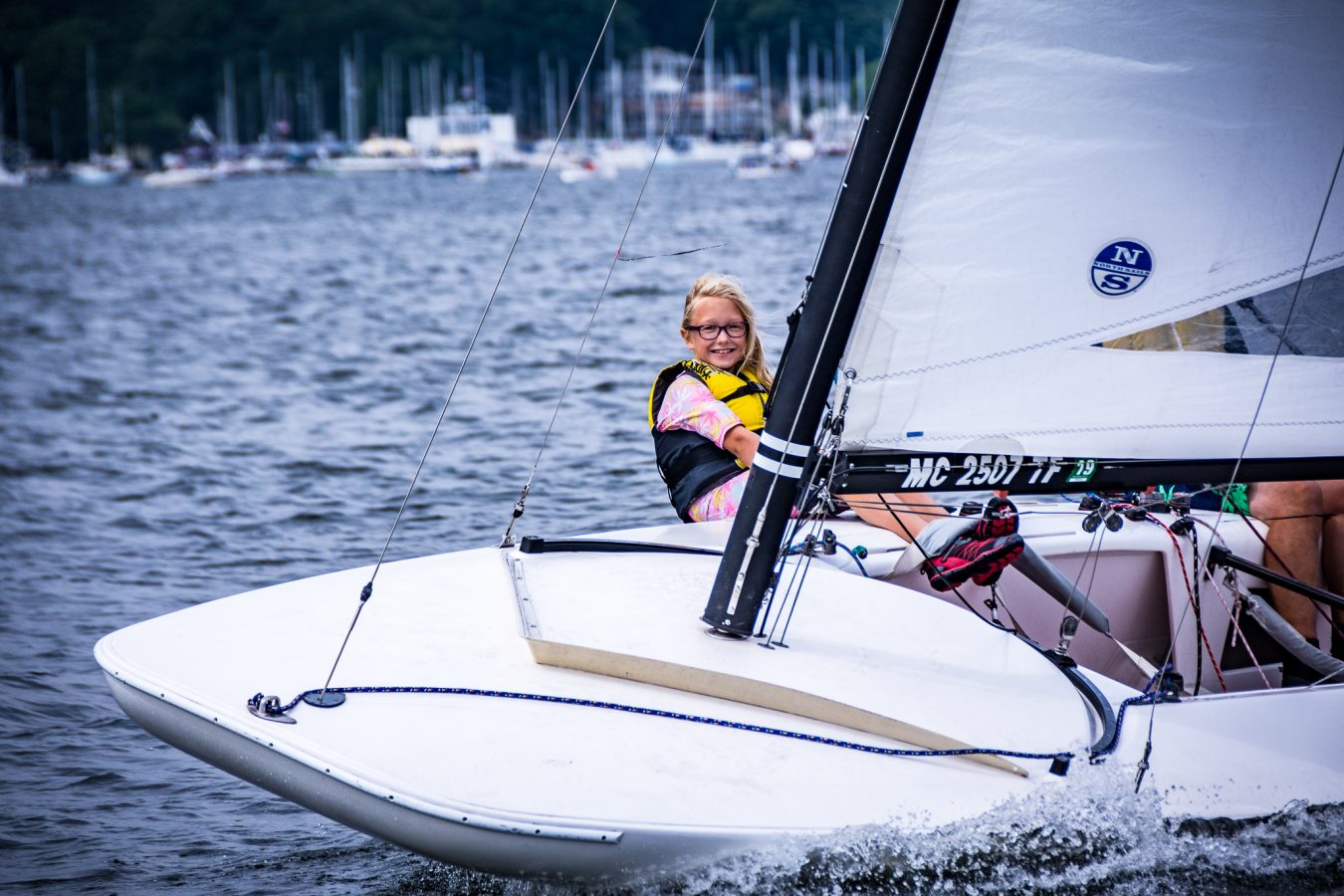
WESTERN MICHIGAN CHAMPIONSHIP
WESTERN MICHIGAN CHAMPIONSHIP
Great One Design Regatta on Lake Muskegon
Melges E Scows, C Scows and MCs faced off at the Western Michigan Yachting Association’s championship held August 1-4 at Muskegon Yacht Club. Tight action, nice breeze and as always a great party highlighted what was a top-notch regatta.
E SCOW
In the E Scow fleet, Eddie Cox’s I-66 took top honors followed by Cam McNeil in second and Tom Munroe in third. All top five teams were powered by North Sails.
C SCOW
The C Scow champion was Spring Lake’s Scott Harestad winning his second consecutive championship with Glenn McMurray and Joe Schaub close behind.
MC SCOW
In the MC fleet, Cam McNeil sailed a solid event to take first. Second place was Jamie Kimball and third was Will Crary. The top three teams used the North ZMax mainsail.
The Melges and North Sails Zenda Team was proud to attend the WMYA Championship and support its sailors. Next up, the team will head to the ILYA Championship on Lake Minnetonka.
Learn more about North’s Fast C Scow, E Scow, MC Scow, Butterfly and Optimist sails.
Full Results
READ MORE
READ MORE
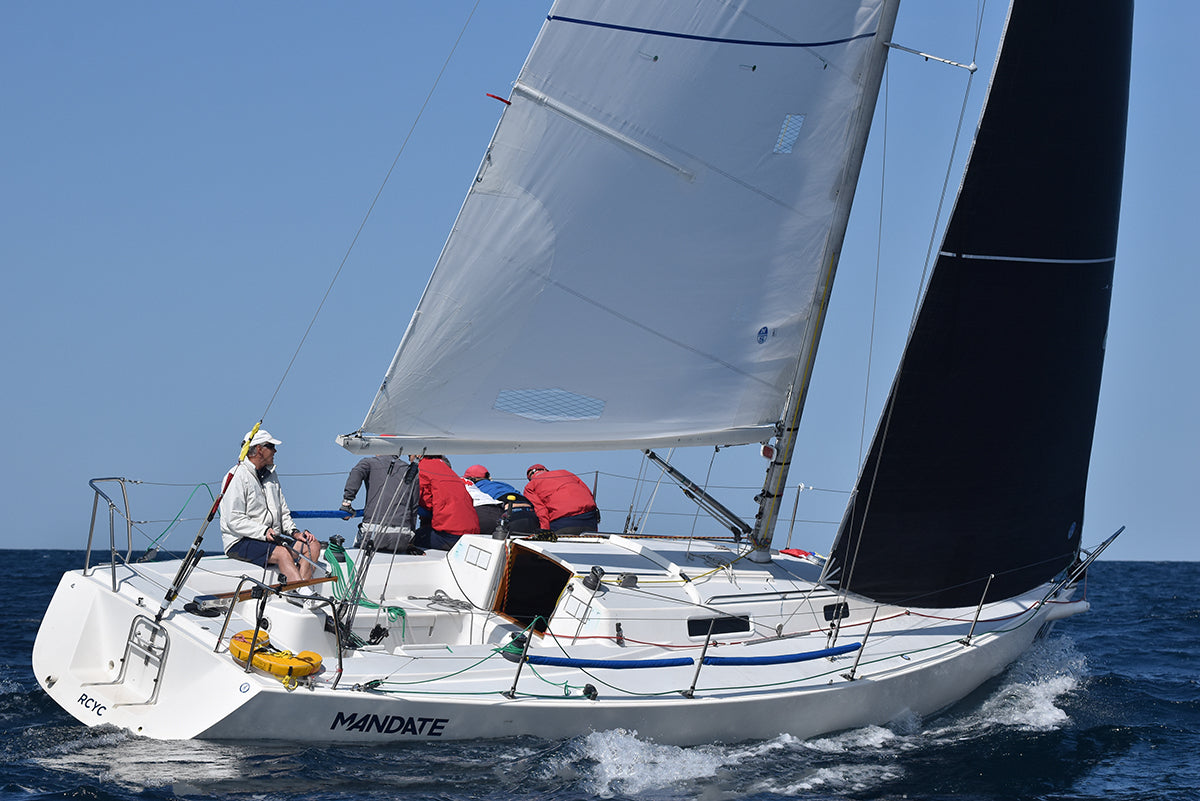
INTERVIEW WITH J/105 NORTH AMERICAN CHAMPION
INTERVIEW WITH J/105 NORTH AMERICAN CHAMPION
North Powers Mandate to Another North American Title
© Chris Howell
This is the third North American title for Terry McLaughlin’s Mandate. Terry bought the J/105 in late 2012 with friend Rod Wilmer. They race during the week on Tuesday evenings in Toronto and do weekend local regattas in preparation for larger events. Terry really enjoys sailing his J/105, commenting that it is “incredibly comfortable to race both on deck and down below”. Terry also enjoys the competition within the class explaining, “no matter where you race them there are always good sailors on the race course.”
Prior to the start, they made sure they had the correct shroud tuning and best jib for current conditions. In variable conditions they found it was better to be a bit loose on the rig tension, so they weren’t too tight in the lulls. Like most good sailors, Terry typically planned to win the favored end of the starting line.
“At the NA’s the lines were usually quite square so it was more important to decide what side of the course you favored. In the windier races, we didn’t push the line too hard knowing that we had good speed in those conditions.“
© Chris Howell
“There were some teams that were also fast downwind so we had to be at our best. As the wind comes up, there is a point that you have to put the bow up to get it to plane. The vang is sensitive on the J/105, so we focused on sailing with less vang while soaking in our low-mode, which is something we wouldn’t have previously done. Our crew weight is always at max weight. It doesn’t take much to be overpowered. The rudder is quite large, so I try to keep the rudder movements small, but if its too small the bow has tendencies to go down. Having my crew understand when they need to lean in and out to hike when the pressure comes is important.”
Terry said that his team improved mostly on vang tension downwind. They were much more sensitive to it this time around, and he noticed a difference in boat speed and how they could sail lower angles much faster.
© Chris Howell
Mandate’s worst race was a third in race seven. “We went for the RC boat-end of the line, which we thought was slightly favored, despite the fact that we liked the left side of the course. We were never able to get left enough after that and had to fight back all race to salvage a third.”
We asked Terry what the hardest part of the event was for his team. He mentioned;
“Bruce Stone’s Gryphon was good right from the start of the regatta. Bruce and Nicole are both very experienced J/105 sailors and know how to make the boat go well in just about anything. Bill Zartler’s Deja Voodoo got stronger every day .”
© Chris Howell
For the most part, Terry’s team sailed clean and stayed out of trouble. They’ve spent a lot of time together racing the J/105, and they can feel when the boat needs something to improve speed.
“My crew is very willing to hike hard, which is key to speed,” Terry said.
Mandate was powered by a new main, Li-5 3Di light air and Mi-4 All Purpose Jib, and runner kite.
“The two 3Di Jibs looked really good. Both had nice, straight exits.”
Terry’s Tips:
Sail with a consistent crew. Form a group of seven or eight crew members that you can count on to be available most of the time.
Have your tuning numbers on hand. Putting together a tuning guide for the shrouds that is very extensive is key. Get to know what the right “look” is for the forestay sag, leeward mast sag, and leeward shroud tension.
Have Fun & Ask Questions. Ask questions to those who are out front. We all have things to share. Everyone is willing to help out.
Interested in North Sails J/105 products? Call your local expert today.
Full Results
© Chris Howell
© Chris Howell
READ MORE
READ MORE
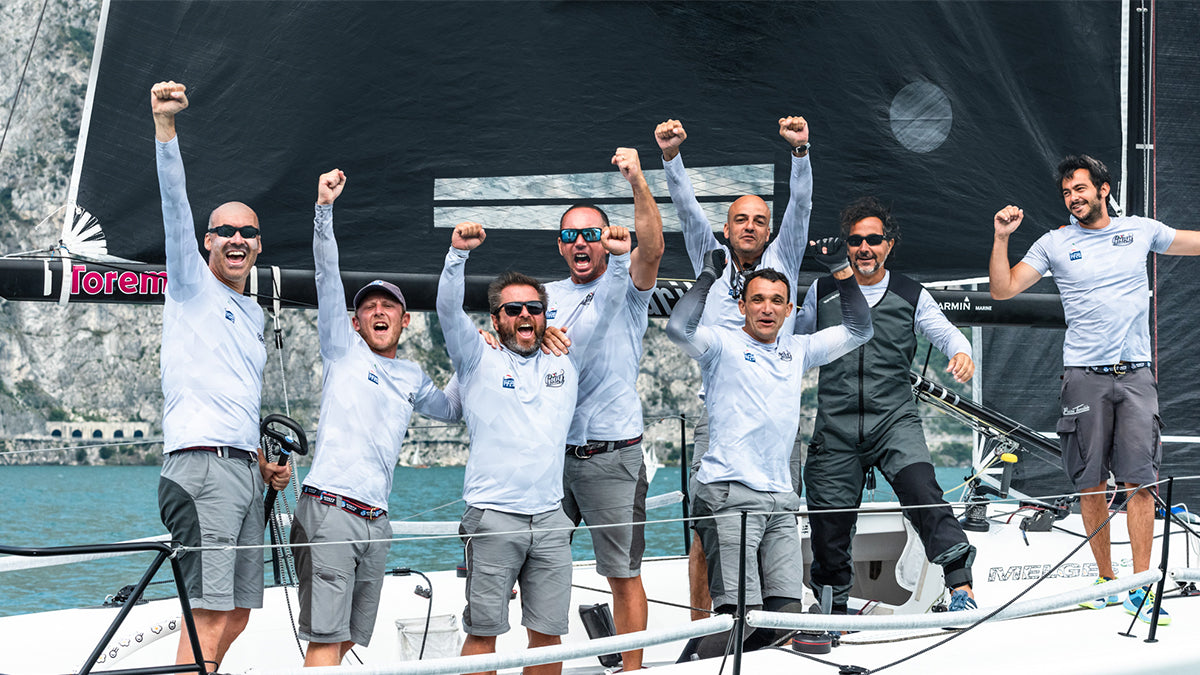
MELGES 32 WORLD LEAGUE EVENT #3
MELGES 32 WORLD LEAGUE EVENT #3
North Powers Giogi To Success At Lake Garda
© Barracuda Communications
July has been a successful month for North Sails expert Giulio Desiderato. After his second place finish in Porto Cervo with the Melges 40 team Stig, he won the J/70 Italian Championship on Calvi Network as mainsail trimmer. He has now claimed another victory after winning the Melges 32 European Division Event #3 last weekend with Matteo Balestrero’s Giogi. Giogi secured the lead after day one and the team was unstoppable throughout the remainder of the event; placing first overall out of 16 teams. We caught up with Giulio to get his thoughts after starting the 2018 season off with a bang.
©Zerogradinord / Mauro Melandri
“Teamwork is the most important factor that allowed us to do well at the Melges 32 event,” Giulio remarked. “We are a strong motivated group of sailors, and Matteo is a seasoned driver who has great feel for the helm and drives the boat very well in all conditions.”
The team manager, trimmer and North Sails colleague Federico Michetti kept the team’s focus on being first across the line. Tactician Branko Brcin answered the call with great positioning on the race course which gave Giogi ample opportunity to succeed. Powered by a full suit of 3Di, the team had all the ingredients for a winning recipe.
© Barracuda Communications
“This regatta came down to the last few races,” Giulio explained. “Our competition was very close, but we were able to sail faster and stay ahead to hold onto first place. Our starts and speed upwind and downwind were very good. We also worked the boat well, and executed our maneuvers as we wanted, which is not something everyone is able to do 100% of the time.”
As avid one design racer, Giulio also serves as a North Sails Class Leader for multiple boats within the Melges range. “I’m super happy with this result on Giogi and really proud to race with my various teams,” commented Giulio. “North Sails is doing an excellent job in these Melges classes, and I can see that our clients are sailing well and satisfied. It’s not only good to see, but also gives me motivation to do well in future events.”
© Zerogradinord / Mauro Melandri
Giogi will now turn their focus to preparing for their next Melges 32 World League event at the end of this month. “To prepare for our next regatta, we will get the team together to talk about the things we can do to improve,” Giulio explained. “We always have a brainstorming session after events to get our thoughts and ideas out there so our team as a whole can deliberate.”
“We are very proud to win this event. Forza Giogi!”
Interested in North Sails Melges 32 Products? Shop all sails.
Full Results
© Zerogradinord / Mauro Melandri
© Barracuda Communications
© Barracuda Communications
READ MORE
READ MORE
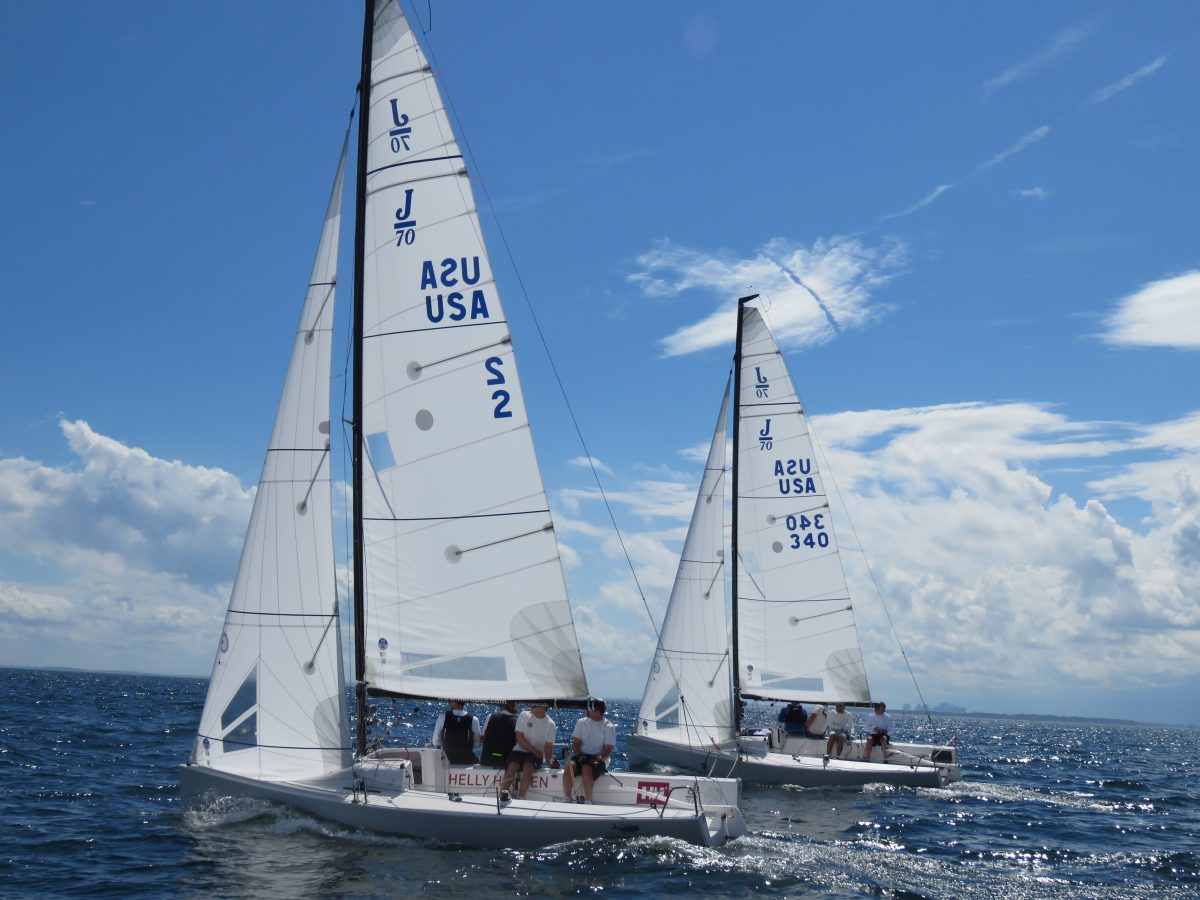
J/70 TAKEAWAYS FROM MARBLEHEAD
TIM HEALY’S TAKEAWAYS FROM MARBLEHEAD
Tim’s Suggested Inventory For The 2018 World Championship
Marblehead is an open-water venue that can often have flat water, swells and chop. My headsail of choice for this particular venue is North’s J-2 High Clew jib. It features a powerful shape for conditions seen in Marblehead, and has proven itself after winning four World Championships as a great option. The high clew allows for more efficient in-hauling over the cabin top and is easy to trim out of the box.
We used the J-2 for practice leading up to and during the NOOD regatta, and our trim settings became noticeably fast. By the end of the regatta we had excellent upwind speed in the lumpy sea-state. I recommend the J-2 High Clew jib as your best headsail option for the Worlds.
Our Race-Winning Settings: (6-10 knots)
Lead Positioning: 5.5 – 6 holes in front of car
In-Hauling: Clew positioned right at the cabin house
Sheet Tension: Use sheet tension to control the twist, keeping the upper leech telltale flowing 100% of the time.
We used the new XCS-2 Mainsail which features the same championship winning shape of the XCS-1 mainsail, with some minor updates.
The AP-1 Dynakote Asymmetric is also ideal for Marblehead’s choppy conditions. When we were in displacement mode (under 10 knots) we needed power and the ability to trim. The Dynakote material is more forgiving and absorbs the shock from the unforgiving sea-state making it easier to trim and easier to sail lower angles at a faster pace. These two sails paired with our tuning guide will make your Worlds experience easier and faster out of the box.
Contact Tim if you have any questions on how you can up the level of your program and get maximum performance this year at the World Championship.
We caught up with Ray and Jenn Wulff, who placed first in Corinthian division using Tim’s suggested inventory. Here is what they had to say about their experience using North Sails and how it impacted their weekend performance.
“As a corinthian team, we don’t have a lot of time to tune and practice before events. At the Marblehead NOOD, we pulled a set of North Sails out of the bag, having never seen them before. We followed the tuning guide provided, and had a fantastic regatta. The North Team put the time in to create a fantastic guide that makes it easy to go from the office to the race course with confidence. North’s J/70 sails are user friendly, forgiving, and easy to set up. Hard to beat that!”
-Ray & Jenn, Joint Custody
READ MORE
READ MORE
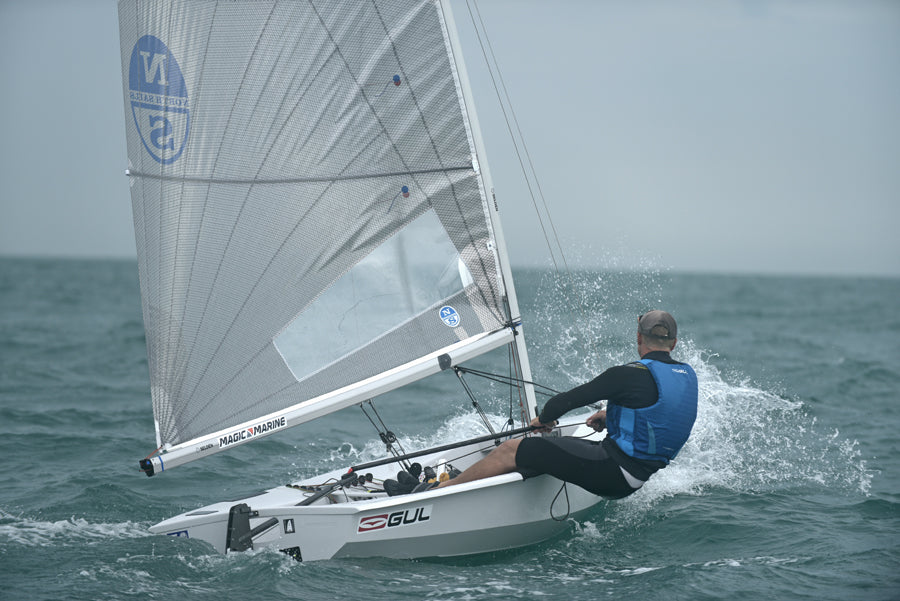
RECORD NUMBERS AT THE SOLO UK NATIONALS
RECORD NUMBERS AT THE SOLO UK NATIONALS
Tuning Tips with Winner Charlie Cumbley
A record 104 Solos entered this year’s National Championship at Hayling Island Sailing Club for five days of ideal sailing conditions. The two-month heatwave continued and a sail from the sandy beaches of Hayling Island on the outskirts of the Solent was the perfect place for this year’s National Championship.
With the UK team back from the Nations Cup in Lake Garda, there were some hot contenders for the National title, including Nations Cup podium finishers Charlie Cumbley and Tim Law. Laser Radial sailor Ellie Cumpsty was competing with the men (the Solo is a traditionally very male dominated class) and in a podium position, until the last day when an unfortunate stream of BFDs pushed her into 13th place overall. Ellie won the First Lady Helm award.
Going into the last day of racing Charlie Cumbley had scored four bullets already, enough to secure him the title. The fight between Tim Law and Pete Mitchell was still on. Both scored a mid fleet results in the penultimate race and a BFD to finish off the regatta, so both were unsure if they had made the podium. Although their score lines were nearly doubled from the penultimate race which they had to count, their previous results were enough to put Pete in second and Tim in third.
We spoke to Tim Law who not only finished third, but at 62 years old qualifies as a Grand Master in the fleet. Here’s what he had to say about racing and his North P-2 Mainsail.
‘I predominately sail Lasers so when I enter Solo events I typically have little time for pre-event preparation. I tend to go to North Sails who do spend a great deal of time and effort on sail development in the Solo class.
I recently purchased their latest design, the P-2 in order to compete in both the recent Nations Cup on Lake Garda in predominantly strong winds and the Nationals off Hayling Island which experienced Medium to light winds.
There is no doubt in my mind that I had the best boatspeed both upwind and downwind that I have ever manage to achieve in a Solo to date. The sail shape provides plenty of power when needed but can also be depowered easily when required in a stronger breeze.’
If you are interested in the P-2 sail or want to get some more advice from our Solo Class experts then get in touch today!
Tuning tips with Charlie Cumbley
READ MORE
READ MORE
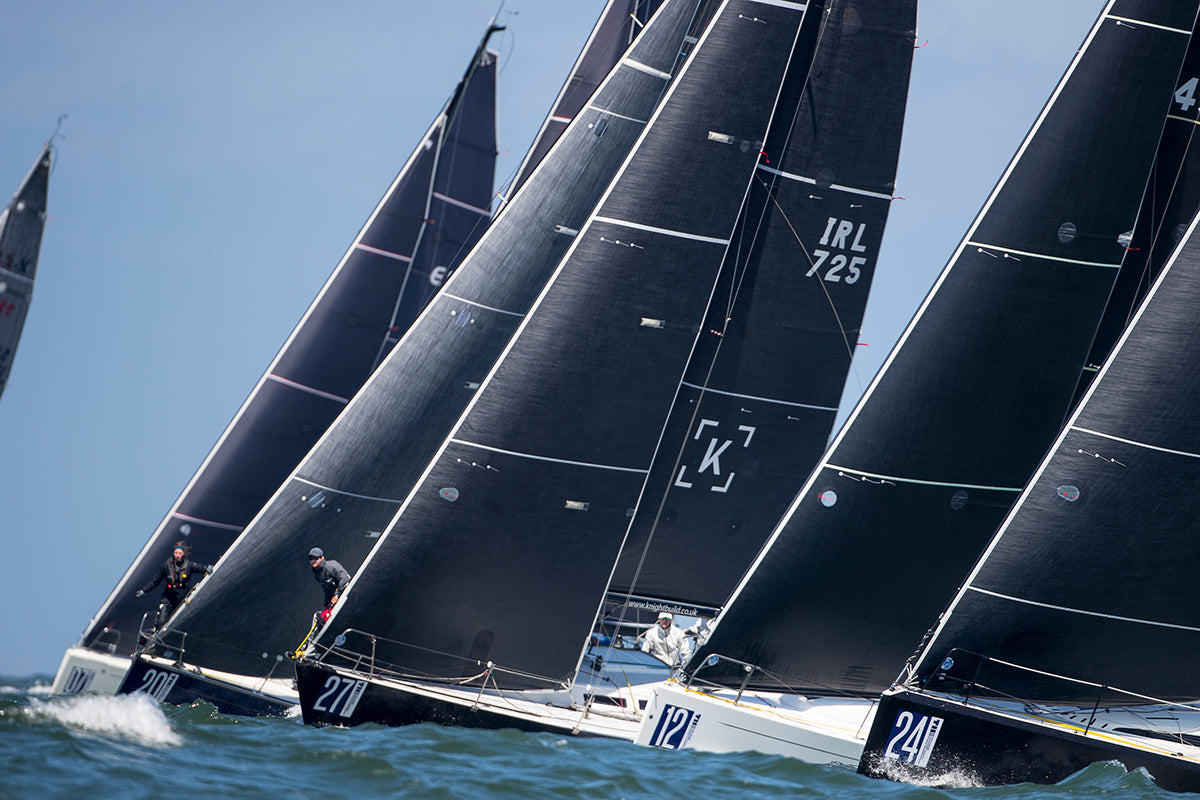
OFFSHORE WORLD CHAMPIONSHIP
OFFSHORE WORLD CHAMPIONSHIP
Beau Geste Crowned Overall Champion
📸 Sander van der Borch / www.sandervanderborch.com
Eighty-five teams competed on the North Sea in the first-ever IRC/ORC Offshore World Championship in The Hague. Yachts ranging between nine to 20 meters battled for podium space across three classes in this highly competitive regatta. Close racing left little room for errors throughout the week of varying conditions and race courses. In the end, Karl Kwok’s Beau Geste was named World Champion; a title they credit with being well prepared and executing spot-on boat handling.
“Understanding the handicap rule, and then optimizing the boat was key to our success in The Hague,” commented Dave Lenz, North Sails designer, and Beau Geste tactician. “It is quite a challenge to get a boat optimized for IRC/ORC racing. You have to run your ideas through simulations in advance, where you’ll often find there are conflicts. Some rules favor a certain boat setup, and identifying potential gains and losses ahead of time helps us make well-informed decisions.”
Lenz was also quick to point out the strength of the Beau Geste crew. “It was my first time racing with this team, and I was impressed by the collection of experience and expertise onboard. Team captain Gavin Brady is a great leader and was on the helm all week. Our hardest part of racing was fending off second place Outsider who was close to matching our boat speed. The crew did a great job staying focused, especially when we had to execute some match racing skills to fend off Outsider.”
Fellow North Sails expert Dave Swete has been with Beau Geste for five years and joined Lenz onboard as lead-grinder. Both Swete and Lenz expressed their satisfaction in the boat’s 3Di inventory, and agree the sails were light, easy to handle and well matched for IRC/ORC sailing. Beau Geste’s secret weapon offshore was the 3Di Helix Luff Code Zero.
“Our new Helix Luff Code Zero proved handy and performed well in the offshore race,” said Lenz. “It can be tough using a Code sail between a spinnaker and jib when you need to cover a wide range. I feel that the Helix Code did just that in an offshore race which gave us 100 and 110-TWA. Our North Sails Helix Code was the perfect option with a lot of breeze.”
Beau Geste works closely with the North Sails team in New Zealand and designer Magnus Doole. “Our owner Karl highlighted that he wanted to win the event, so we knew getting a jump on our closest competition was critical,” reflects Swete. “There was a lot to consider each race because we needed to perform well under the two rating systems. Magnus and the team in New Zealand did a great job getting the boat exactly what she needed. We are feeling pretty good after our accomplishment at the Worlds.”
📸 Sander van der Borch / www.sandervanderborch.com
Van Uden’s bowman, calling distance to the line 📸 Sander van der Borch / www.sandervanderborch.com
In a tough battle for third place in Class A with Van Uden, Hitchhiker finished fourth, still sailing a great week with seven finishes within the top five. 📸 Sander van der Borch / www.sandervanderborch.com
To find out more information on IRC/ORC Ratings and how teams were scored at the Worlds, click here.
Full Results
Offshore World Championship
Class A
1
Beau Geste / Karl Kwok
3
Van Uden / Gerdjan Poortman
Class B
3
Olympic / Tiit Vihul
Class C
1
J Lance 12 / Giddeon Messink
3
Pro4u / Patrik Forsgren
* Denotes Partial North Sails Inventory
READ MORE
READ MORE
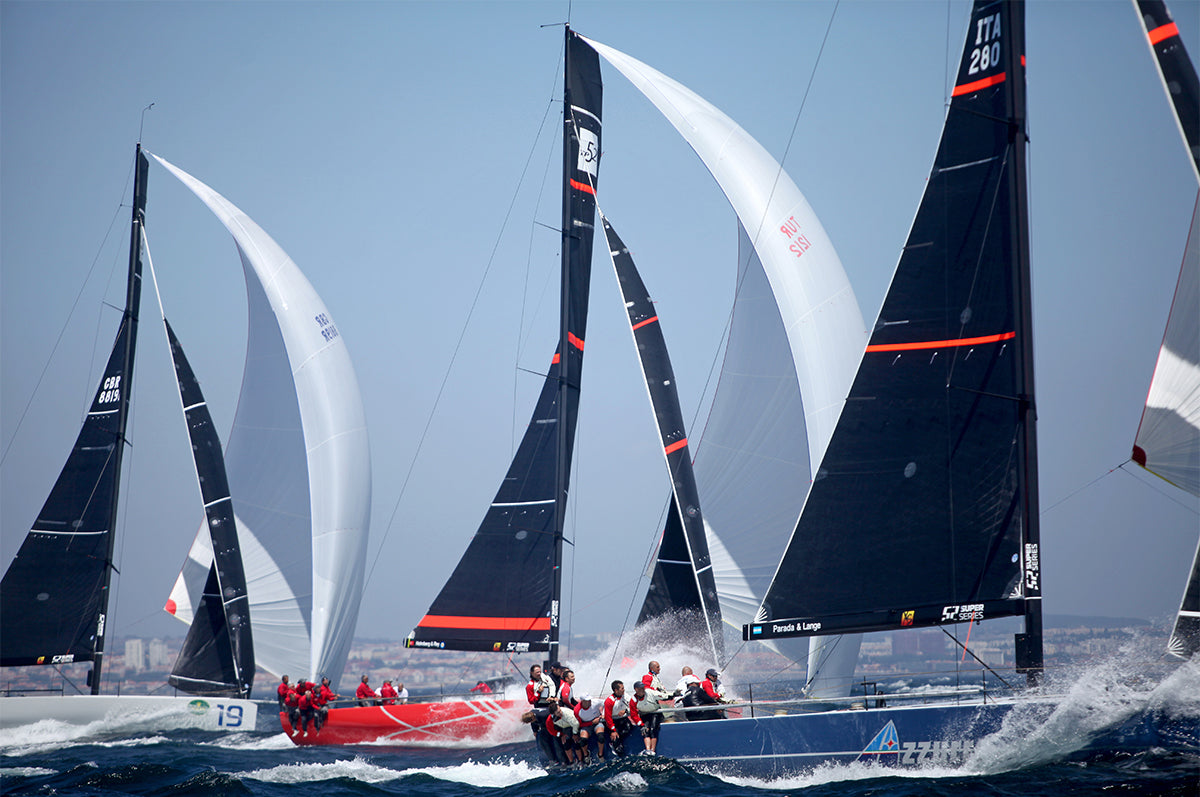
HARD WORK NETS POSITIVE WITH TP52S
HARD WORKS NETS POSITIVE RESULTS
Refocused Efforts Paying Off in the 2018 52 Super Series
📸52 Super Series
The TP52 fleet is coming off the Rolex TP52 World Championship in Cascais, Portugal last week where North Sails powered four of the top five boats. The TP52s have one of the most competitive circuits in sailing today, and require the most progressive sail technology and design. A few years ago North Sails recognized an opportunity to improve results and their 52 market share by doubling down their efforts within the class. North designers Mickey Ickert and Juan Meseguer are both deeply involved in the development of North’s TP52 products and use events like the Worlds to see first hand the feedback they’re getting from the trimmers. Mickey and Juan are in agreement that the last few years of hard work are evident this season.
“There is no question that the communication and cooperation within the North Grand Prix designers has gotten even better,” said Juan. “Our design group is more effectively applying our use of software and data to help guide the design process and deliver performance information to trimmers. This is coupled with introducing 3Di RAW 880, the highest performance, most carbon dense sail developed specifically for the TP52. The key indicator of the performance shift is North clients are sailing with a lot of confidence this season.”
Three events down and two remain in the 2018 52 Super Series circuit. The season to date has been positive, but the results do not surprise Mickey. “North Sails has put a lot of smart people and powerful tools towards the TP52 fleet. You have to believe all that hard work will pay off and that’s what we’re seeing now. I really think the North 3Di product continues to show why it’s so good, especially towards the end of the season where the sail cards will be limited. It would not come as a huge shock to see two North powered boats on the podium in the Series overall results.”
📸52 Super Series
The final day of 2018 Worlds saw the two top ranked owner-driver teams of Sled and Alegre going head to head with Alegre coming up a winner. Azzurra and Quantum Racing, the two top pro-driver teams, went to battle through the final racing in a who-beat-who for the World Championship crown. A special congratulations to Andy Soriano’s Alegre who not only won the owner driver award, but collected their first Super Series podium finish this season.
“The results from Cascais reflect the experience of the veterans teams, and their boat handling in the winder conditions,” commented Mickey. “Sled and Alegre both have very strong owner-drivers who have pushed their teams to the top limits. During the event someone commented that the gap between the owner-driver and fully pro teams is getting smaller and smaller. This is a great credit to the owners who keep improving their skills and building teams of great sailors.”
📸52 Super Series
📸52 Super Series
📸52 Super Series
READ MORE
READ MORE
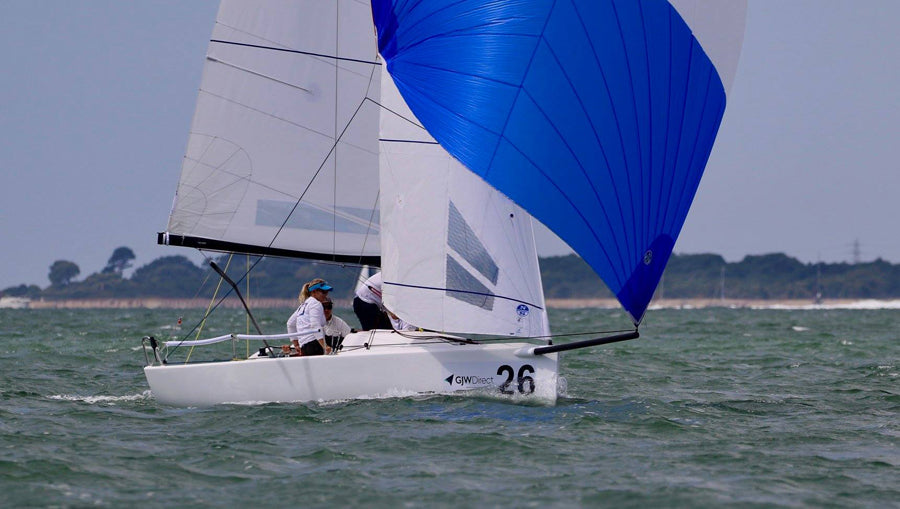
J/70 UK NATIONALS
J/70 UK NATIONALS
Mark Lees and team win the J/70 UK Nationals with a fresh set of North Sails
The 2018 National Championship saw the growing J/70 fleet at its full strength, with thirty-five boats entered for the 3-day event held by the Royal Southern Yacht Club. With light winds in the forecast for the weekend, there was high hopes for the Solent seabreeze. Fortunately PRO Stuart Childerley delayed racing each day guaranteeing great afternoon racing in the summer seabreezes.
Mark Lees onboard SeriousFun with his young team were crowned 2018 UK National Champions after ten races, with a lead of 20 points and four bullets. They raced on a brand new boat with new North sails straight off the shelf the day before the regatta. In second place overall was reigning J/111 World Champions, Martin Dent with his team onboard Jelvis and rounding off the podium in third place was Doug Struth’s DSP who were also first corinthian team. All three top teams were powered by North!
We caught up with Mark Lees to learn more about their experience:
Brand new boat and brand new team – What did you do to make sure the boat was ready for racing?
Not a lot! We only got the boat the day before the regatta and didn’t expect to be ready in time. The forecast was for a light weekend and we thought it would be a good chance to shake the boat down. We made sure we checked the rig setup thoroughly and went into the racing with very open minds. To have the boat go as well as it did was a very pleasant surprise.
Why North Sails? Which models did you use?
When starting out in a new class I thought it was important to reduce as many variables as possible. I have a good relationship with the guys at North Sails from previous campaigns and they advised which sails most of the fleet were using – the whole process couldn’t have been easier. We used the XCS-1 mainsail, J-6 Jib and AP-1 spinnaker.
Did you follow the North Sails Tuning Guide?
We started off bang on the North guide and didn’t stray too much. We thought we were on the lighter side as a crew so we changed up a little earlier than the guide.
The J/70 is not the only class you sail, what experience did you bring from Etchells to the J/70?
The basics are key. As mentioned we weren’t as well prepared for this event as we would have liked. We didn’t put pressure on ourselves with any expectations, which was definitely an advantage, but we focused very hard on the basics.
We followed the tuning guide, we started well – choosing a side of the course and then aiming for a clean start in that half of the line but away from the pack. From there we tried to keep it simple and fought hard to stay in clear air.
Tell us a little about your team onboard
I had a fantastic team of close friends and very good sailors. My girlfriend Hannah Peters has been doing a lot of J/70 sailing recently which really helped us. It was fantastic for us to sail together. Toby Mumford used to match race with me and we’ve sailed together for a long time. He’s good for me as he always gives an honest opinion about how I am sailing – good or bad! Annabel Vose, our tactician, who I have sailed with and against many times. She did a great job this weekend and made my life a lot easier. There are a lot of very good sailors in this fleet so I’m glad she was on our boat!
This is a testimonial to not only Mark and his team’s racing skill but also to the production and consistency of the boats and the sails. Here at North Sails we pride ourselves in our worldwide consistency in the production of our One Design sails and Mark’s win is a true testimonial to this.
Congratulations to Mark and team SeriousFun. To find out more about the North Sails tuning guide or to speak to one of our J/70 experts, head to the class page!
J/70 UK Nationals 2018
1
SeriousFun / Mark Lees
2
Jelvis / Martin Dent
3
DSP / Doug Struth
5
Calypso / Calascione/ Ripard
6
Eat,Sleep,J,Repeat / Paul Ward
7
Sorcha J / Peter Harrison
8
JDog / John Greenland
9*
Darcey / Clive Bush
* Denotes Partial North Sails Inventory
Full results
READ MORE
READ MORE
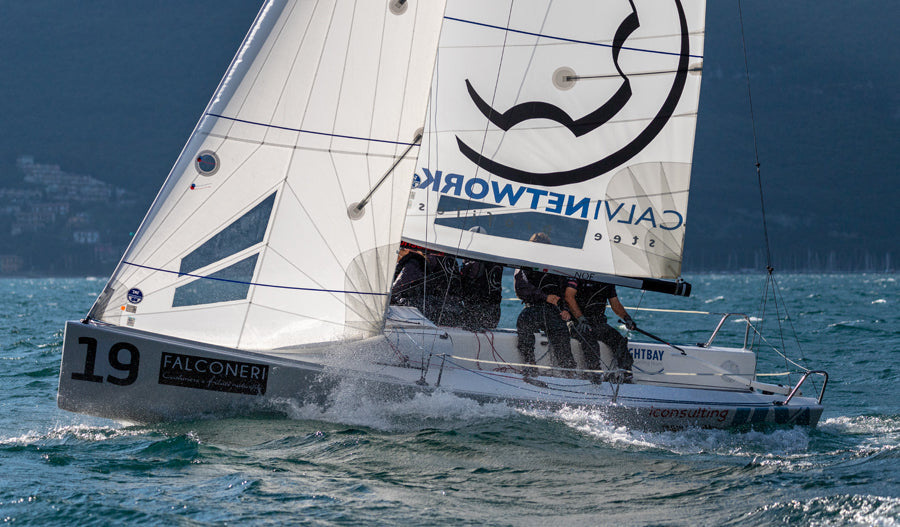
J/70 ITALIAN CUP - MALCESINE
J/70 ITALIAN CUP – MALCESINE
Petite Terrible wins the Inaugural J/70 Italian Championship whilst Calvi Network take the Italian Cup
The third act in the J/70 Italian Cup 2018 was combined with the first ever Italian Championship in Malcesine, with seventy-four boats turning up for the event. Lake Garda’s typical conditions of light winds in the morning followed by strong thermal winds in the afternoon came through in style across the three-day event.
As the 2018 Italian Cup has gone on, the competition has been getting tighter and tighter across the fleet as boats get into the groove. In eight races there were eight different race winners, seven of them powered by full North Sails inventories. Overall, Gianfranco Noe’s Calvi Network kept their cool throughout the regatta with consistent results in the top ten places of the scoreboard securing the win in Malcesine and putting them also in the lead of the Italian Cup standings.
“I’m very happy about our performance and I can say that we were super fast on the water. The team work and the good tactics call in some difficult situation have been the key of the success.” Giulio Desiderato, Trimmer onboard Calvi Network
The results for the 2018 Italian Championship were taken from the weekend’s results and boats with entirely Italian crew were eligible. In third place overall and winner of the first ever Italian Championship was Claudia Rossi’s Petite Terrible. Claudia and her team were using a full North Sails inventory consisting of M-2 Mainsail, J-2 Jib and AP- 1 Spinnaker.
Congratulations to all North Sails clients who won races in Malcesine, for what turned out to be the tightest regatta yet. If you are interested in buying any North Sails products, or want to find out how these teams are using their North Sails to full advantage, get in touch with one of our J/70 experts today!
J/70 Italian Cup – Malcesine
1
Calvi Network / Gianfranco Noe
3
Petite Terrible / Claudia Rossi
4
Team Notaro / Luca Domenici
5
Viva / Tommaso Pavan
6
L’Elagain / Franco Solerio
7
Uji Uji / Alessio Marinelli
8
Enfant Terrible / Alberto Rossi
9
Alice / Federico Leproux
10
Joyfull / Denis Cherevatenko
* Denotes Partial North Sails Inventory
J/70 Italian Championship 2018
1
Petite Terrible / Claudia Rossi
2
Team Notaro / Luca Domenici
3
Viva / Tommaso Pavan
4
L’Elagain / Franco Solerio
5
Uji Uji / Alessio Marinelli
6
Enfant Terrible / Alberto Rossi
7
Alice / Federico Leproux
* Denotes Partial North Sails Inventory
Full results
READ MORE
READ MORE





















